STUMBLING THROUGH VERMILION HISTORY
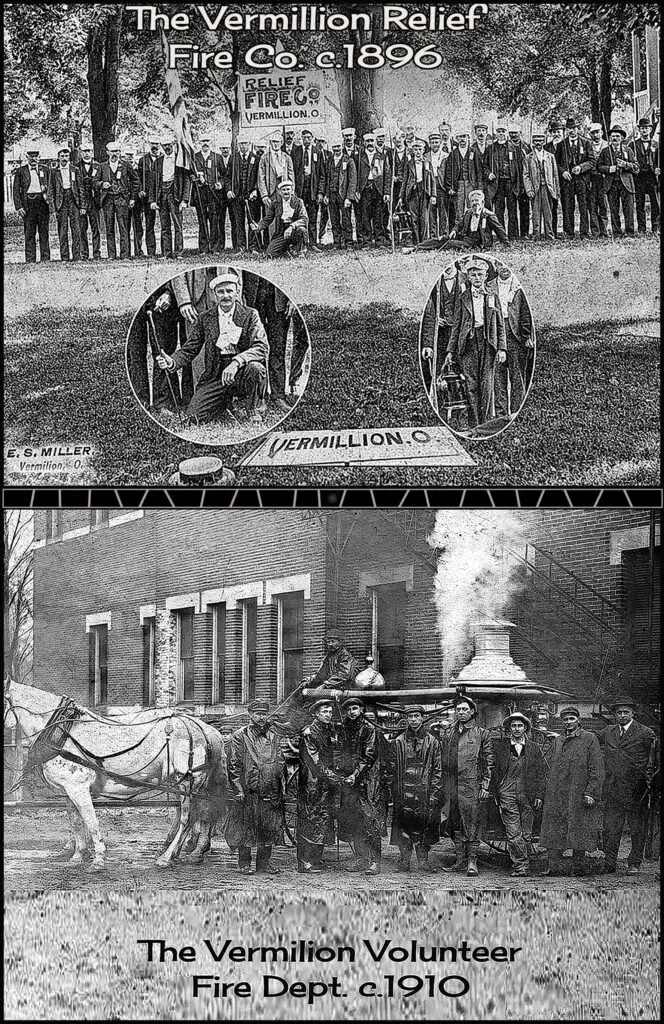
While stumbling through the local history of our community I am inclined to make mistakes now and then. Given the fact that few to none of them are what one might consider to be “earth-shattering” it’s not much of a problem. There is room for some error. However, while on the subject of mistakes I note that there is at least one organization in our community that through the years seldom made mistakes because the result would be devastating. That organization is the Vermilion Volunteer Fire Department.
As local organizations go it is undoubtedly one of, if not “the” oldest volunteer safety organizations in the city. Although, to my knowledge, no records exist to document that as a fact it would likely be safe (no pun intended) to assume that a loosely organized force of volunteer firemen probably existed for some time prior to Vermilion’s official incorporation as a village in 1837.
Formally organized as the Relief Fire Company #4 in the mid 19th century (top photo) it was reorganized and was renamed the Vermilion Volunteer Fire Company (lower photo) at the dawn of the 20th century.
By 1910 when Vermilion News Editor/Publisher Pearl Roscoe froze the lower image of Vermilion fire-fighters at the back of the Vermilion Township Hall they had come a long, long way from the bucket brigades and hand-pumpers of their fathers and grandfathers. Their steam-fired fire pumper was a state-of-the-art machine. And it is clear that the men were truly proud of the apparatus.
Prior to the time water became readily available throughout the village the fire pumpers were placed near a good water source – such as the river – where they were used to pump water through lengths of hose to the fire. The hand-pumper, as the name implies, required as many as 10 men to operate. Thus, the advantages of the steam pumper over its immediate predecessor is appreciable.
And Vermilion did have its fires. In the years of 1875, 1891, and 1903 many of the stores and shops located along the southwest side of Liberty and Division/Main Streets were visited and destroyed by flames. In 1910 twenty-two cottages in Linwood Park went up in smoke. So frequent were the mishaps that after the 1903 fire a small headline in the old Erie County Recorder placidly observed “Vermilion Burns Again”.
In truth – although they were catastrophic – there was nothing extremely unusual about these conflagrations. A majority of buildings were located close together, constructed of wood, were heated by coal/wood stoves, and were illuminated by kerosene lamps. Put all those things together, mix in the human error factor, and the potential for disaster becomes, and became, very real. Fortunately, no lives were lost, and no one was injured as a result.
Although the steam pumper greatly improved the ability of Vermilion fire-fighters to address many of the fires they encountered it was hardly a match (again no pun intended) for fires such as the 1910 fire at Linwood Park. In this case two additional steam pumpers, and hose carts, manned by Lorain firemen arrived on flatcars furnished by the Lake Shore Electric interurban railway. Nonetheless, the old steam pumper more than proved its worth over the years – as did the numerous volunteer firemen who manned it.
Then in 1928, after 20 years of very commendable service, a new age dawned, and the old steam pumper was mothballed. The Vermilion Volunteer Fire Department, under the direction of Fire Chief William “Dad” Tischer, leapt into the new century with both feet and purchased a newfangled (gasoline engine powered) firetruck. It was not a mistake.
Ref: Vermilion Bugle – 1981, History of Vermilion Fire Department, by John Fischer; The Vermilion Historical Society (formerly the Vermilion Area Archival Society), Pearl Roscoe Photo Collection; VPJ 04/22/07.
© RNT – April 14, 2024

RICH TANGENTS
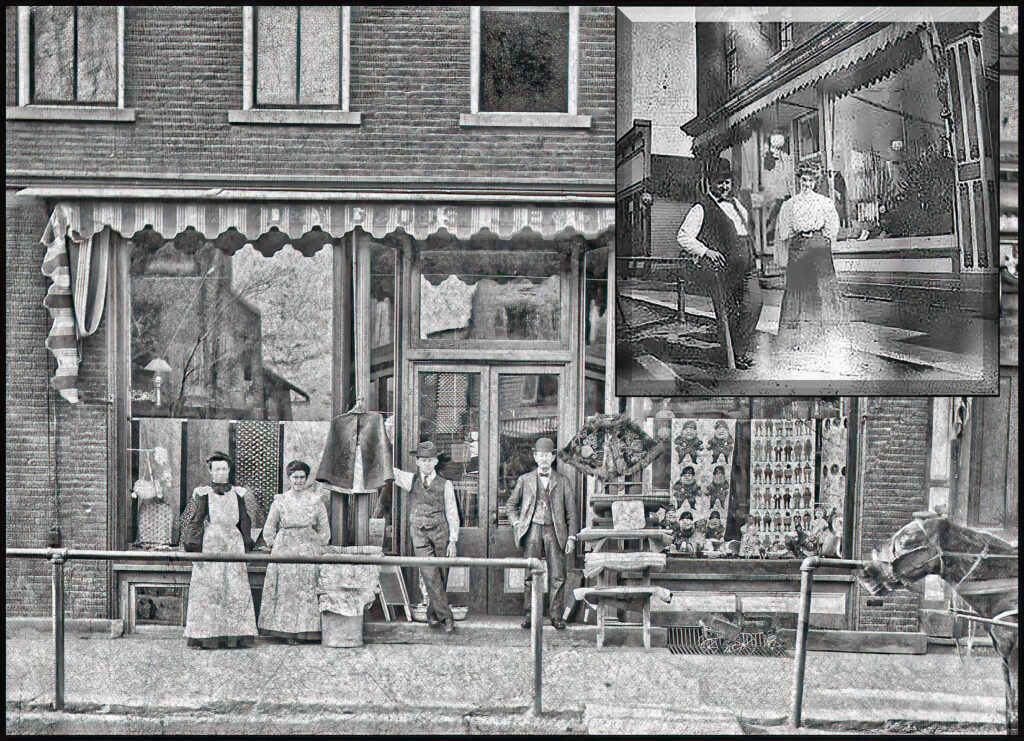
This all began last Thursday when I came across the smaller photograph (upper right) that I’d almost totally forgotten about. To be very brief, it is a portrait of late Vermilion haberdasher Lewis Englebry and his store clerk, Helen Thompson-Tischer. The building behind them is Mr. Englebry’s store on Liberty Avenue. That building currently (2024) houses the Art Seen art gallery. The year is 1906. Coincidentally At 05:12 Pacific Standard Time on Wednesday, April 18, 1906, the coast of Northern California was struck by a major earthquake. It is now remembered to be the deadliest “quake” ever in the U.S.
But moving ahead, this photo moved me to take a closer look at Vermilion’s Jacob Englebry family. Like many German families they had migrated to America in the mid 19th century finally settling in the hamlet of Vermilion. Jacob Englebry / Engelbrecht had apparently found work with Orin Gaylord and Albert Merrill in the dry goods business [Note: That would’ve been located in what is currently Big Ed’s Main Street Soda Grill]. But before too long he went into business for himself in the building (pictured) on the west side of north Division Street – now Main Street – between the railroad and Liberty Ave. Today it is known as Brummer’s Chocolate’s store.
Jacob had three wives. His first wife, Margaret Delker born in Bavaria in 1842 died in 1872. While it wasn’t immediately obvious (to me) it appears that Jacob married Margaret’s younger sister Mary in 1874. Mary and her 10-year-old daughter Bertha were drowned along with 29 other persons when the steamer Western Reserve was lost on the night of August 30, 1892. The ship, sans cargo, was enroute to Two Harbors, Minnesota. The circumstance was particularly tragic because in addition to the vessel’s crew and the Englebrys, those on board included owner Captain Peter G. Minch, his wife, Anna, and their two children. Anna was Mary’s sister.
Now about the small photo that impelled me to discover the previous information. Those pictured, as previously identified, are Lewis Englebry and Helen Thompson-Tischer. Helen was likely a clerk in Lewis’s Dry Goods Store behind them. The few who follow my scribblings and photographs will recall a rather famous photo of Lewis along with Vermilionite C.A. “Charlie” Trinter and aeroplane pioneer Tony Janus. They posed near Janus’s biplane on the beach at Linwood Park around the year 1906. Lewis’s presence is noteworthy because he was a big guy coming in at nearly 400 lbs. When Janus took him for a ride on his plane, he was very likely the heaviest passenger to have ever been flown (anywhere) at the time. And here is where things begin to get a little obtuse.
Lewis was married to Vermilion Lake Captain Bell’s daughter, Carrie. The couple lived with her mother and father in the big house on the northwest corner of Liberty and Perry streets. It had originally been the home of Capt. Henry Delker. Bell had purchased the property following Mr. Delker’s death in 1890 from a wound he had received during the American Civil War. Delker was also Englebry’s (step) uncle. He was the original proprietor of the dry goods store in the smaller photo. Whether Lewis bought or inherited the shop is not known (by me).
Now for the large photo. The is the Jacob Englebry Dry Goods Store that has now morphed into Brummer’s Chocolates on Vermilion’s Main Street. The men outside the shop are two of Jacob’s sons, Frederick and Myron who assumed ownership of the concern following Jacob’s death in 1905. When Fred died in 1943 Myron took over the business. By that time the store had been in operation for 83 years.
Another Englebry son – the oldest named George, operated a shoe franchise just a few doors away from the dry goods store. We have but a single photo of only the sign from that shop in our collection. George drowned in the Vermilion River in July of 1904. He was guiding his naptha launch (i.e. a small motor launch, powered by a naphtha engine) to the dock when he fell, hit his head, and drowned.
Myron died in 1962 in West Palm Beach Florida. So, one can surmise that the business went well for him. When I was a kid (back in the 50s) we still knew the shop as “Englebry’s”. I purchased lots of clothes there – nice sweaters and slacks that I promptly took to a seamstress on Exchange Street. She “pegged” / tapered them at the ankle to 13”. But I never gave much thought about the shop owners or their histories in our town until I came across the little photo that Mary Louise “Tootie” Reisinger gave me many years ago. It took me a long, long time to put all of it into perspective. That’s because of all the tangents – the numerous paths that led me to other names, relationships, events, and places. Perhaps I shall change my name – to “Rich Tangents”.
© RNT April 8, (Eclipse Day) 2024

A WELCOME HOME PLACE
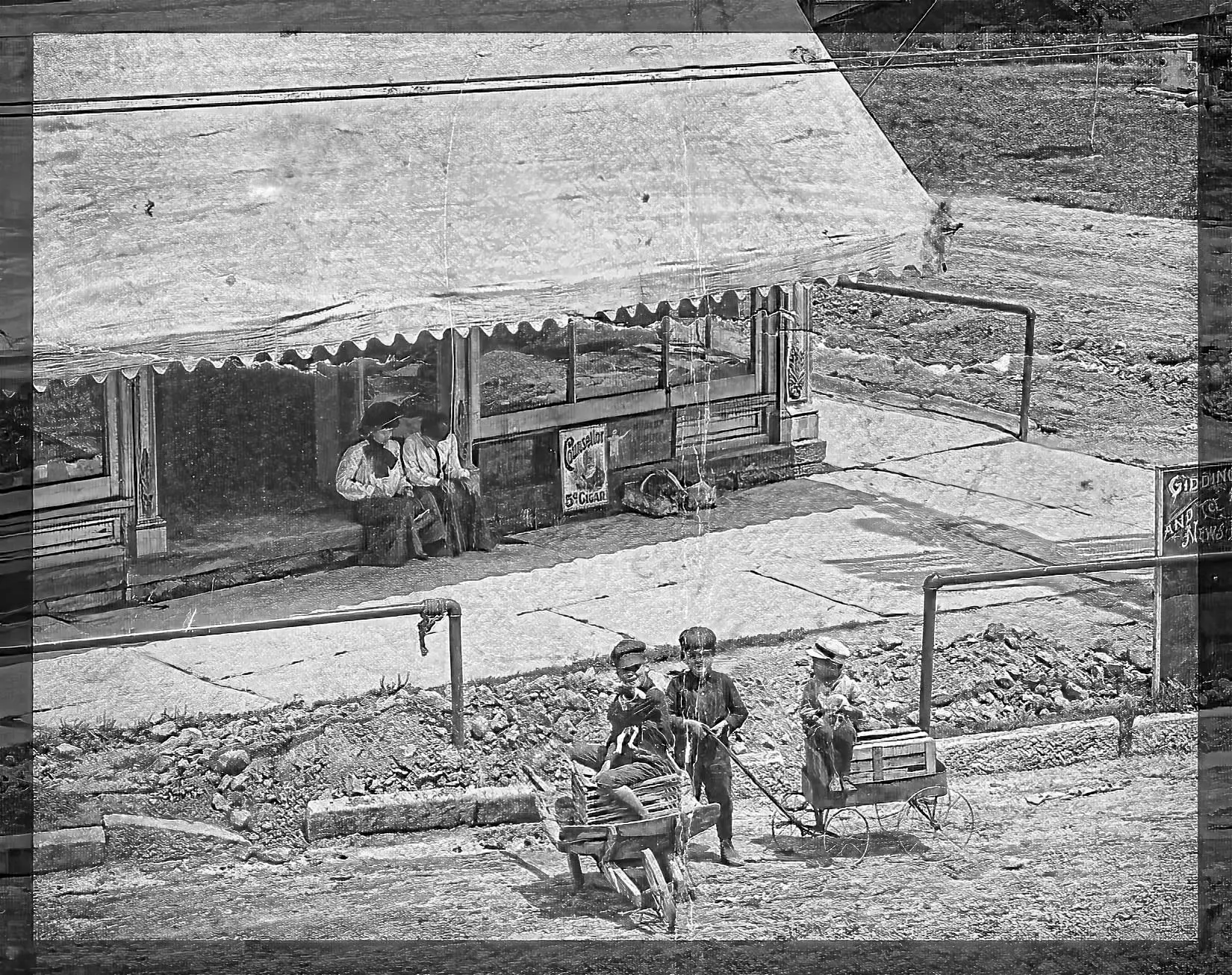
Speaking for myself and some others I will probably forever refer to the site in the accompanying photo as “Hart’s Corner”. It was “The Place” to hang out as a teenager when / if there was nothing else to do in town. I know that I spent many an afternoon and evening (if weather allowed) loitering with my pals on this corner. We, of course, never imagined that a day would come when it wasn’t “Hart’s Corner”.
Back then we were all under the illusion that things would always and forever be the same. I don’t know if youngsters still haunt this corner the way my generation did back in the 1950s. But it certainly appears by this photo that we were hardly the first. It was a place to watch girls as well as all the cool cars owned by some of the high school guys we knew drive by – and drive by again. A place where we laughed, dreamed, and dreamed some more.
We also were, I suppose, a bit of a nuisance. Our presence required folks to wend their way through our ranks and around our bicycles to go in and out of the drugstore. We also succeeded in helping break the big plate glass window on the right side of the entrance. (No one got hurt.) But for whatever reason I don’t recall the owner, Jim Hart, ever getting upset with us. Of course we did frequent the soda fountain, and all our parents did business with the medical and beauty side of the store. But still, one must admire his patience.
Years later I came to know Jim (Hart) much better and found him to be a person with an even temper and an extraordinarily logical mind. His actions often seemed odd to me but were always precise, and well thought out. I’ve often kidded about him saying, “There’s a right way, a wrong way – and then there’s Jim’s way.” He wasn’t wrong about things. He simply saw and approached things differently. This may account for his not becoming angry with our adolescently rude behaviors in front of his drug store. It may also account for his success as a pharmacist. (i.e. He probably, and quite logically understood, that someday we would grow out of it, look back, and not be so much sorry, as truly embarrassed for our stupidity. He was, of course, correct.)
But returning to the photo. It was not Hart’s store, much less a pharmacy when this photo was taken – sometime around the year 1906. These shadows were captured from the 2nd floor of the Pelton-McGraw general store just across the street. The little guys are posing with their wheel barrow and wagon. Two of them are happily holding kittens on their laps, while the women seated at the front step of the store seem to be engaged in serious discussion. At the time I believe the Davis Dry Goods store may have occupied part of the lower floor of the building that had been divided in half. A few years earlier the Wagner Saloon had occupied the section where Davis later located. The other side may have been the Wagner Shoe Shop. I also note the sidewalk sign on the far right advertises “Gidding’s Tobacco and Newspaper Stand”. I’m not sure where it was located.
The original property was owned by Eli S. Barnum, George G. Baker & Nathan G. Sherman as trustees for proprietors of Vermilion Township and was sold on April 1, 1840. A Masonic Lodge building was built in 1868. That building was destroyed by fire in 1870. [NOTE: Judge Eli Barnum was also instrumental in the creation of the first church in the area of Vermilion which eventually became the First Congregational, now the UCC Congregational church],
In 1870 Gaylord & Merrill built the existing building. Over the years it housed many businesses including the post office, the Goodsell Company, the Wagner Shoe Shop and the Miller / Wagner Saloon.
In June of 1920 Albert H. Hart brought the property from John E. Stang of Sandusky, Ohio. It was known as the Warner property and identified as Lots 72-73 & 74. The warranty deed is dated November 3, 1920.
Jim’s father, Albert H. Hart, had gone into business on August 2, 1912, in a store located in the Krapp and Goodsell Building (where Lee’s Landing is today). He then purchased the building in the photo, put in a central heating system, took out the wall that divided the room, and rebuilt the storefront. When the building was ready, he moved his drug store to the site.
The second floor has been occupied by various organizations and businesses at various times: The Masonic Lodge, the Vermilion Boat Club, and from November of 1950 to October of 1981 Dr. Norman T. Andersen DDS occupied the front rooms for his dental practice. A lady by the name of Mitzi Braun had a beauty shop at the north end of the building, and the R.E. Warner Engineering Co. had its start in rooms that were later occupied by Louis Stoffel, CPA.
Over the years the building was leased, re-leased – and eventually sold. Currently it is the home of Big Ed’s Main Street Soda Grill. They sell sandwiches and interestingly enough maintain the old soda fountain. But the day of the 10-cent phosphate and 25-cent ice cream sundae have, like Hart’s Corner Drug Store, been relegated to the yesteryear. Nevertheless, for many long-time and former residents, no matter the name of the business located therein, it’s always going to be “Hart’s Corner”. But no matter the name, it’s always Vermilion’s “Welcome Home” place.
©RNT April 1, 2024

JUST SPENDING / WASTING TIME
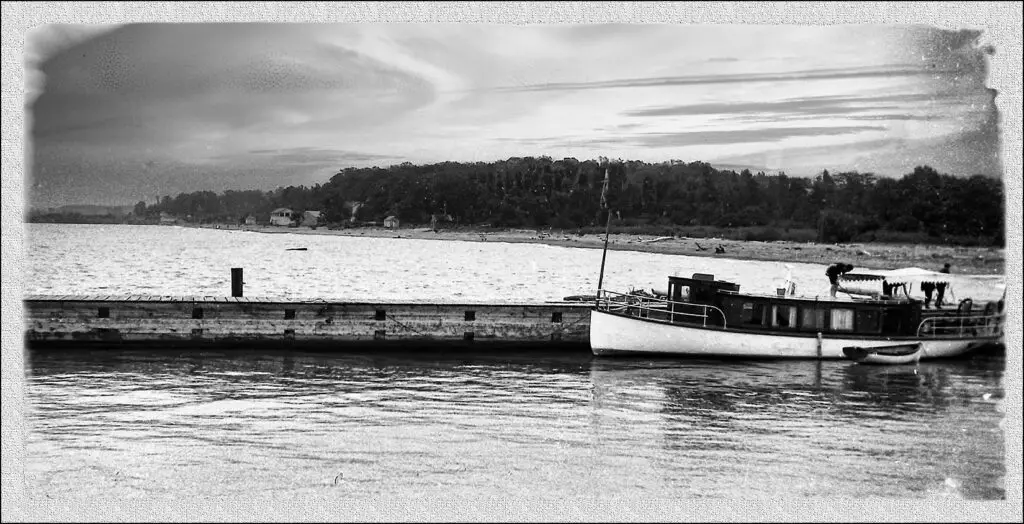
The photo accompanying this week’s essay is not what anyone might consider to be an “ooo and ahhh” photograph. Not by a long shot. But it is unusual. Lately I’ve been meandering through the cache of photographs available to me – not really looking for anything particular – just looking. Few persons (aside from my wife) know how much time I spend / waste [you can fill-in the right word] just looking and thinking on them. Well, anyway I came across this one.
Briefly stated, it’s an old photograph of Vermilion’s east breakwall c. 1930. As is obvious it’s hardly as picturesque as its well-known cousin just across the river to the west. I would guestimate that photographs on, in, or around the west breakwall that once featured the Vermilion’s original lighthouse might run into the thousands. But this one? I have – or have only seen – perhaps a half-dozen. And all of them were taken from the lighthouse side of the stream.
The yacht moored in the photo is very similar to late Vermilionite Commodore Frederick W. Wakefield’s Tobermory I. As it pertains to recognizing most sailing vessels I am quite at sea, so whether that is actually Mr. Wakefield’s boat or not is for someone else to decide. Whatever the case it appears to be a well-appointed yacht that was, perhaps, tied-up along the breakwall for the night. One fella works on setting-up a canopy covering the afterdeck, while two other people walk along the breakwall toward the beach.
It is readily apparent that in this photo the structure on the east side of the river was more pier than breakwall. The difference was for a time imperceptible to most landlubbers like me. A pier, however, is a raised structure constructed from the land into a body of water that could be used as a landing place for vessels. A breakwall on the other hand is a structure built out in a body of water intended to protect the harbor from the force of waves. Today both the east and west sides of the harbor are protected by breakwalls. Precisely when the pier on the eastern side of the harbor was transformed into a breakwall is unknown (to me) at this time.
One might have also noticed that in some older photos of the western breakwall it once had a catwalk that ran along the top that allowed the lightkeeper and others an opportunity to walk from the shore to the light without having to negotiate a safe path among the large stones and other debris that comprised the wall. This eastern pier, while less romantic, was certainly very accessible. Or at least it was for Linwood Park denizens and persons visiting places like “Cloudy” Noel’s ferry and boat livery nearer the beach.
Part of what I personally like about this photograph is the background. The trees, of course, cast cool shadows over the homes and people who frequented Linwood Park. But even in this photo one can imagine the crowds drawn to the wonderful sandy beach on the waterfront of the park back then. The beach house and the small circular building that was, to my understanding, some type of photography concern – as well as a brief glimpse of the old Linwood Hotel – are all there. Pieces of driftwood are scattered along the beach west of the park that would just a few years later witness the magical rise of Cape Cod-like homes from what for centuries had been mosquito infested wetlands.
To be sure this is not an “ooo-and-ahh” photograph. And I suppose visitors will, for years hence, understandably flock to the western breakwall, the beach and replicated light. But setting that all aside, I seriously doubt that Vermilion ever had a better place to fish or just watch traffic come and go in the harbor than from that eastern pier. And though it may very well be gone, it is certainly not forgotten. Especially by like someone like me who spends / wastes a good deal of time meandering through a cache of photographs of people, places, and things of Vermilion’s yesteryear. But, no matter, I love every minute it.
Vermilion resident Rich Tarrant is Curator of the Vermilion History Museum and a son and a grandson of the late proprietors of The Vermilion News (1897-1964). Readers may email him at: rnt@twc.com
RNT March 17, 2023
![]()
"AND THAT'S THE TRUTH"
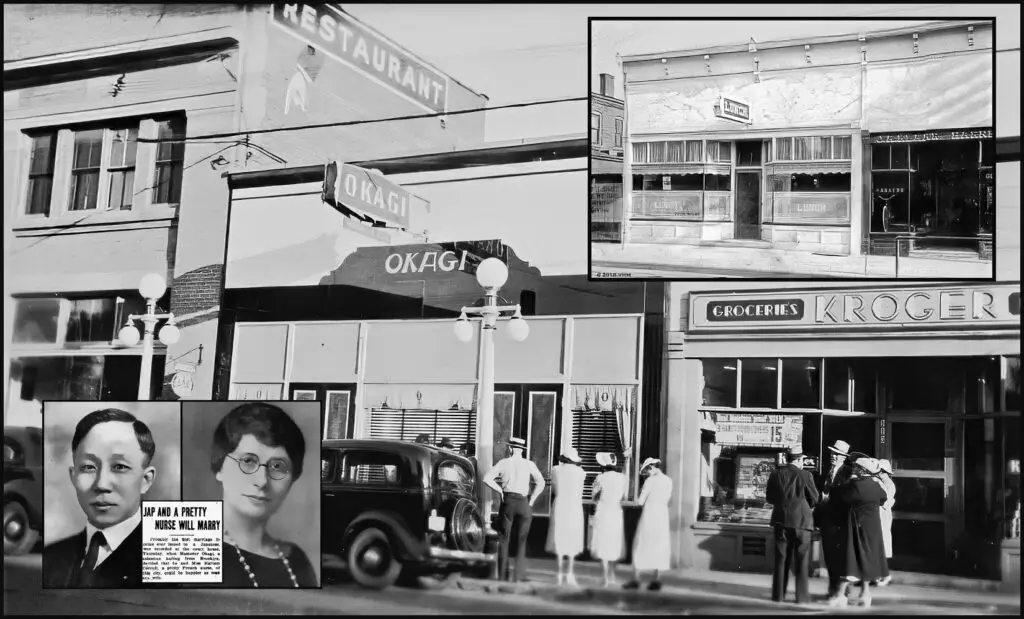
Please don’t fall asleep while reading this. I have written about Vermilion restauranteur Mamarou Okagi numerous times for numerous venues. And yet, folks still have questions about him. So…
Ok, call me “Redundant Rich”. But I can’t help it. When I find a great photograph of Vermilion’s yesteryear I am always compelled to share it. Never mind that the focal point (i.e. the Okagi Restaurant) in this instance has been the subject of previous columns. I likely have more photographs of this local businessman and his cafe than any other that ever existed in our pretty city. The only other eatery that I have numerous photos of in our town is the short-lived “Red Clay On-The-River” from 1999.
There are at least two things that make the particular photo (the larger one) significant. The first is that it affords all a very, very good look at, not only the front of the restaurant as it appeared in the mid to late 1930s, but also gives us a rare look at Vermilion’s first Kroger store next door (currently Jon Clark’s Insurance Agency). Secondly, it serves as a graphic example of the popularity of the spot. The folks milling around in front of the place are not waiting for a bus. They’re waiting for the door of the restaurant to open. Moreover, they’re first in line. Later in the day the queue of souls waiting for their turn to eat at Okagis would easily line the walk down the block. So popular was the restaurant that on most holidays and Sunday’s patrons were given numbered tickets to insure their place in line.
Briefly reiterating the history of the famed restaurant and its owners: In the autumn of 1913 Mamoru Okagi (b. Fukuoka, Japan 1880) and his wife Marie (b. Bordeaux, France 1889) had purchased both a restaurant and a home in the Village of Vermilion, Ohio. Late Vermilion historian Don Englebry wrote in his memoirs; “Okagis opened their first restaurant where the Prague Restaurant is now.” But by 1919 their business had become so successful they found a need to acquire a larger building – the one (pictured upper right) next to the Erie County Bank. The new quarters had a seating capacity of 225.
Despite their ethnicity (i.e. Japanese and French) the restaurant fare was American. The food was served family-style on tables covered with linen tablecloths, set with real linen napkins, silverware, ceramic plates, and glass table settings. Every day fresh flowers were placed in the front window. In short, the food was apparently great, the prices reasonable, and the ambiance extremely pleasant.
Over the years a basement was added to increase work and storage space. And in the spring of 1933 a black and white glass front was added. It was the very first (and only one) of its kind in the village. In addition to that another door was added to the front of the building making access and egress for large numbers of customers much easier.
The couple having no children of their own took in, and raised, two orphan children – a girl and a boy. The girl’s name was Mary Kenik. She eventually married a fellow by the name of Russell Vasbinder. The boy they raised was named George Kominis. He became a pilot in the military during WW2. Afterwards he became a commercial pilot and had a very successful career.
In 1942 Mrs. Okagi, upon discovering that she was terminally ill, took her own life. Some years thereafter Mr. Okagi sold the business to his foster daughter’s husband, Russ Vasbinder, and his brother-in-law, Cecil Thomas. A few years later Mr. Okagi left his adopted town, and the business he had so carefully crafted with his wife – forever.
Mamoru Okagi did not return to Japan but lived out the remainder of his years on the West Coast. He died on December 23, 1956, in Los Angeles. Today no corporeal vestiges of the restaurant that had earned a national reputation remain. It is now dissolved into a storefront shared over the years by several different businesses. But ask around. There is still a person or two who remembers the wonderful Okagi Restaurant.
As a footnote to this story, I offer the following communiqué that I received in August of 2007 after Mr. Okagi’s nephew, Bob Okagi, came across my story(ies) about his uncle on the Internet:
“…being related to the owner of the Okagi Restaurant of yesteryears, it gives me great pleasure to introduce myself as one of his nephews (alive-75 years). And am currently residing in Lacey, WA, although I have not been privileged to visit Vermilion, I have frequently visited and enjoyed Mamoru Okagi’s hospitality during Aug 1955 through Nov 1956 in Los Angeles, CA. during his retirement.
There were many interesting moments of his life that was shared in the short time we spent together while I was attending Northrop Aeronautical Institute in Inglewood, CA. Your website has refreshed many memories of times spent together including his memories of his wife Marie, Mary & John [sic] Vasbinder, Cecil Thomas, and Mary’s son (Jack) that wrote to his pappy routinely, which was cherished and enjoyed by Mamoru…”
In the end, redundant or not, the Okagis and their restaurant earned a place in our local history well worth knowing and remembering whether you live in Vermilion, Los Angeles, or Lacy, WA. As Lily Tomlin’s character, Edith Ann used to say, “And that’s the truth.”
Ref: The Vermilion News; 4/14/33; Ancestry.com; Ohio Deaths 1908-1944 Record; California Death Index 1940-1997; VPJ 09/08/2011.
Vermilion resident Rich Tarrant is Curator of the Vermilion History Museum and a son and a grandson of the late proprietors of The Vermilion News (1897-1964). Readers may email him at: rnt@twc.com
RNT © March 10, 2024
![]()
A BIRTHDAY CELEBRATION - 1937
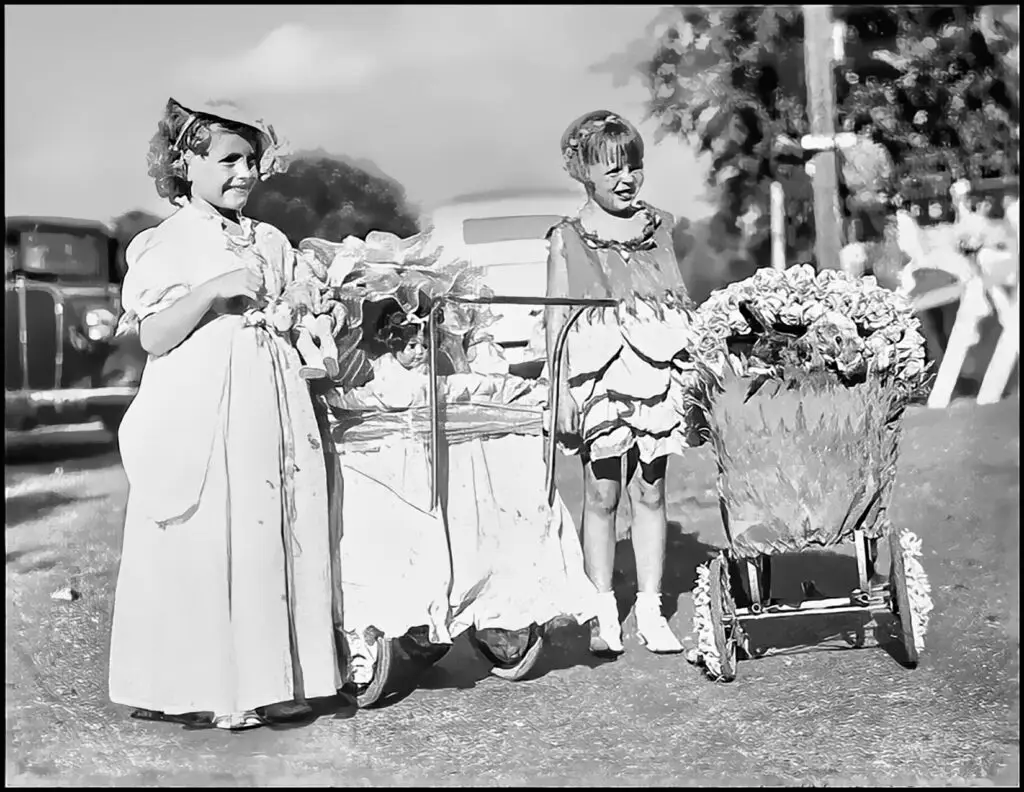
There’s a big stone in Vermilion’s Victory / Liberty Park [NOTE: Victory Park is, by the way, the one next to St. Mary’s church.] that goes largely unnoticed by most everyone save the occasional youngster whose love for climbing upon such things may be as timeless and inexplicable to them as the existence of the rock itself. There is, however, an appreciable reason for the stone being where it is, and the plaque on the stone explains it:
“ERECTED IN MEMORY OF / VERMILION’S FOUNDERS / BY THE CITIZENS OF VERMILION / COMMEMORATING THE 100TH ANNIVERSARY OF THE / FOUNDING OF THE VILLAGE / MARCH 14,1837 / DEDICATED DURING / VERMILION CENTENNIAL / AUG 11 – 15, 1937”.
Surrounding the dedication of this memorial was a swirl of activity. It began on Wednesday with a great parade concluding on Sunday with Homecoming church services followed by power boat races and water sport events held on the river by the waterworks (it was Regatta weekend). In the upper rooms of the Fischer building − “The Hall of Progress” − there was a historical exhibit chaired by (who else?) late Vermilion historian George Wakefield that included an old-time fiddler’s contest. There was a golf tournament and a plethora of other contests: a Centennial window display contest; bathing beauty contest; and a freckle contest. There was a boat parade, doll buggy parade, and a pet parade. There were Midway activities with Bingo, and Candy and Doll wheels. There was a midway barker yelling “See the big fish!” who found it necessary to explain that he was not “the big fish” – that it was in a big box on his platform. And there was a “Guess Your Weight” man who by all reports was a real bad guesser. (Or it could it actually have been the case that he was actually very smart.) There was Vaudeville entertainment, a Street Dance, and a Variety Show.
On Wednesday, Thursday, and Friday nights there was a Historical Pageant held behind the high school (the field behind Vermilion’s old South Street and Decatur Street schools). It featured a cast of 218 Vermilionites including a narrator. This rather ambitious pageant consisted of a 13-act play that started with the Creation of the World, and concluded with a production using the entire cast that symbolized the growth and spirit of America. The play was held on a lighted 218-foot outdoor stage on the athletic field. 1,000 seats were available for each performance. It was estimated that 700 people attended the first performance. Given the fact that the Village of Vermilion consisted of perhaps 2000 souls (or less) in that yesteryear the attendance numbers were especially significant.
Two thousand out-of-town visitors registered their names at “Historical Century Hall” [NOTE: Precisely what site this refers to is unknown. It may have been the Town Hall.] during this celebration. The number excludes all the names of persons from Vermilion, Brownhelm, and Birmingham who registered. All had some ties to Vermilion’s past. Anyway, On Friday afternoon a service was held in Victory / Liberty Park before a large audience as the Founder’s memorial stone was unveiled. A band from the Ohio National Guard’s 112th Engineers played. During the same ceremony descendants of some of those founders were introduced and honored.
The photograph accompanying this essay shows the winners of the “Doll Buggy” contest. They are Carol Trinter (Bechtel-Clutter) and Nancy Tarrant (Emery). And when the band stopped playing, and the crowds retired to their respective communities and homes, as one might imagine – probably with a good deal of confidence –these two girls were likely among the first to climb and play upon the stone. If they did not you can surely bet that one of their friends or relatives did. And that, of course, was alright. After all, it was a birthday party.
Ref: Special Thanks: to Carol Trinter-Bechtel-Clutter; The Vermilion News, August 1937; VPJ, 03/15/12; Rev. 03/03/2024.
©RNT March 3, 2024

EVOLUTION OF A CORNER
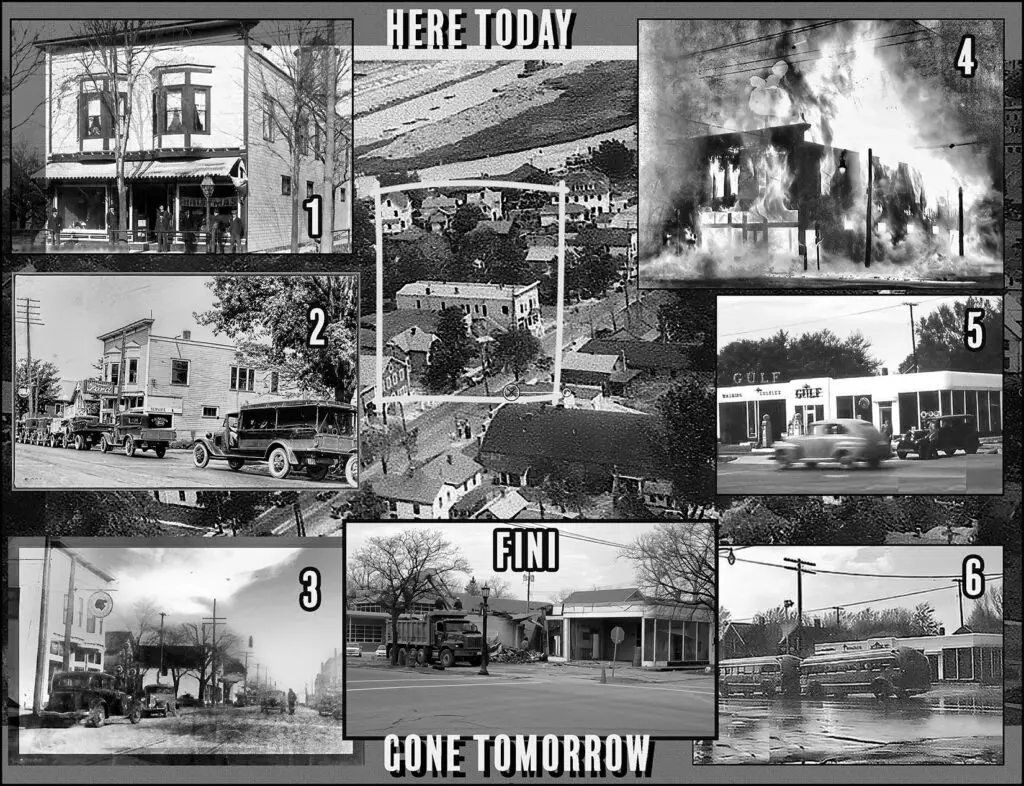
Well, it was Sir Isaac Newton way back in the 17th century who is said to have said it first; “What goes up must come down.” Of course, he was actually talking about his theory of gravity while I am referring to buildings in particular, and places in general. I don’t know about the “must” factor of the theory. “Always” might be a better word. But either way everything changes over time. Including the northwest corner of Liberty and Grand streets in beautiful Vermilion Ohio. The photograph accompanying this week’s essay is a collection of eight pictures taken over a period of a century of the same corner in Vermilion. As is obvious the corner was once an integral part of the village commercial sector. But then things changed.
(1). The first photo is that of the Guy Davis Dry Goods store. The Davis family lived in the apartment above the store. It was not an unusual arrangement in the 19th and early years of the 20 centuries. He later moved to Elyria and opened (I believe) a dance studio, eventually returning to retail sales. Mr. Davis had previously kept his business in the building now (2024) occupied by the Main Street Soda Grill just a block to the east.
(2). At the time the second photo was taken a young man named Frank E. Baker had acquired the Ford automobile franchise and was using the building for his showroom and garage. I believe Baker purchased the franchise from the Dall Brothers. The Dall Brothers had been encouraged to locate in Vermilion by local industrialist F.W. Wakefield. They had initially occupied the building where an organization called Bad Boy, Bait, Tackle & Archery is currently (2024) located. They also kept an Overland auto franchise in a building on Liberty Ave. above the Moes Marine Services and east of the Vermilion Boat Club (2024).
(3). After Frank Baker built his new building on the south side of Liberty near the river bridge (the one now occupied by the Vermilion Deli & Grocery and Edward Jones Financial (2024) – the building became the home of a Pontiac Dealership operated by a popular Vermilion fella named Glenn P. Martin. Martin was a true sports enthusiast and for years coached a semi-pro Vermilion basketball team.
(4). When Vermilion’s “Singing Mayor”, Leonard Osberg was elected to office in 1940 he moved his cosmetic business as well as the municipal office into the rooms over the Martin’s Pontiac garage and dealership. Then on March 11,1940 the building burned to the ground. All of Martin’s automobiles and equipment were lost along with all Osberg’s equipment and materials. But more importantly “all” (not just some) “of the Village records” went up in smoke as well. The records lost in this blaze were invaluable. [Note: I have video of this fire. Ergo, when I wrote “the building burned to the ground” I seriously mean it burned to the ground.]
(5 & 6). Following the 1940 conflagration a new building rose from the ashes (sans the mayor’s office). It was a sleek-looking Gulf service station that for a time doubled as a Kaiser-Frazer (an equally sleek-looking car) dealership for Glenn Martin. I’ve no idea why Mr. Martin no longer had the Pontiac franchise. But it may be that the Kyle family purchased it following the blaze, because by the time the new building rose Kyles had the franchise. Here I’ve grouped these photos together because I don’t know which is older. The busses in the lower photo were those of the Lake Shore line that had replaced the old interurban (i.e. Lake Shore Electric) transportation system that had been dismantled in 1938. In any case, both photos were taken during the early 1940s.
(Fini). The last photograph portrays the end of an era for that corner and the beginning of another in Vermilion. In its final days the service station was being used as a Muni-garage and storage place for various items. Over the years it had been a nice service station. I don’t recall all the persons who operated the place. I do recall that Rich Barthel was among the last. Local resident Larry E. Howell knows more about that than would I.
The area today (2024) is now a pretty park called Friendship. It provides a place where people can learn about some of the town’s old sailors and vessels. It’s also a place where one can sit and talk, watch passing traffic, or quietly read, perhaps, about what once was and dream about what tomorrow will bring.
© RNT February 18, 2024
![]()
WHEN WARS WERE NOBLE
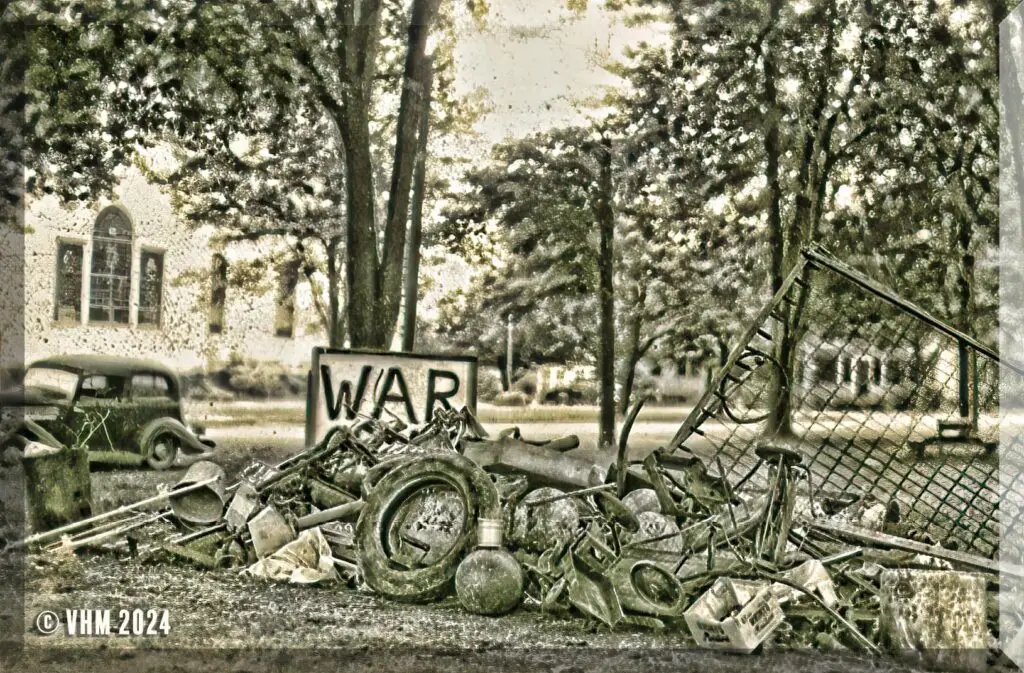
Ok, ok, the snapshot accompanying this monograph may not appeal to one’s sense of beauty. Junk piles seldom do. However, this photograph of a mound of scrap in Vermilion’s Victory Park is, nonetheless, of some historical import. For when these shadows were frozen in a yesteryear – back in 1942 or ’43 – the people of our nation were not, as we are today, embroiled in inane political squabbles. World War II was raging in Europe and the Pacific, and we were fighting for our lives. This meant that everyone – not just those serving in the military – had to pitch in to help. And they, as the “snapshoot” illustrates, did.
Scrap drives to collect metals, rubber, kitchen fat, newspapers, rags, etc. that might be recycled and used in the war effort were organized in 1942 all across the United States. Everyone, including school children and scout troops, participated. And though it was later discovered that many of the collected materials couldn’t readily be recycled few found it necessary to complain.
Salvaged kitchen fat was used to produce glycerin, an ingredient used in both medicines and explosives. Iron and steel were melted down to manufacture munitions. This was especially important because it took time for our nation to prepare American industry for the production of necessary war materials. It has been said that 50% of every tank, ship, submarine, and gun manufactured during the conflict were made of the scrap metal collected by the men, women, and children of our nation.
Among the items in the accompanying snap are bed springs, a reel lawn mower, old tires, license plates, papers, iron pipe, buckets, pails, hubcaps, tin cans, a child’s wagon, a toy truck, a flat clothing iron, curtain rods, metal straps, a cardboard box, and sundry auto parts. Fortunately, Vermilionites didn’t go overboard as they reportedly did in some other parts of the country and rip up streetcar rails, as well as cannons and statures in parks along with church bells, to donate to the cause. [But that’s not, however, to say that it wasn’t suggested.]
The war efforts of the American public were, by and large, rational, serious, and should not be underestimated nor forgotten. When the scrap drives were being conducted the outcome of the war was hardly, as some say, “a given”. People were anxious and, as a consequence, united. It’s interesting to note that one person who has seen this photograph remarked that it was of a time “When wars were noble and supported.” Though I’m not sure that I agree entirely with that observation I do agree with another person who simply said, “We’ll remember.” Methinks that‘s the point.
Ref: Cecil Adams; The Straight Dope, 5/31/2002; Special Thanks to The Vermilion News photo archives.
© RNT 9/25/11
![]()
Whom the Gods Love
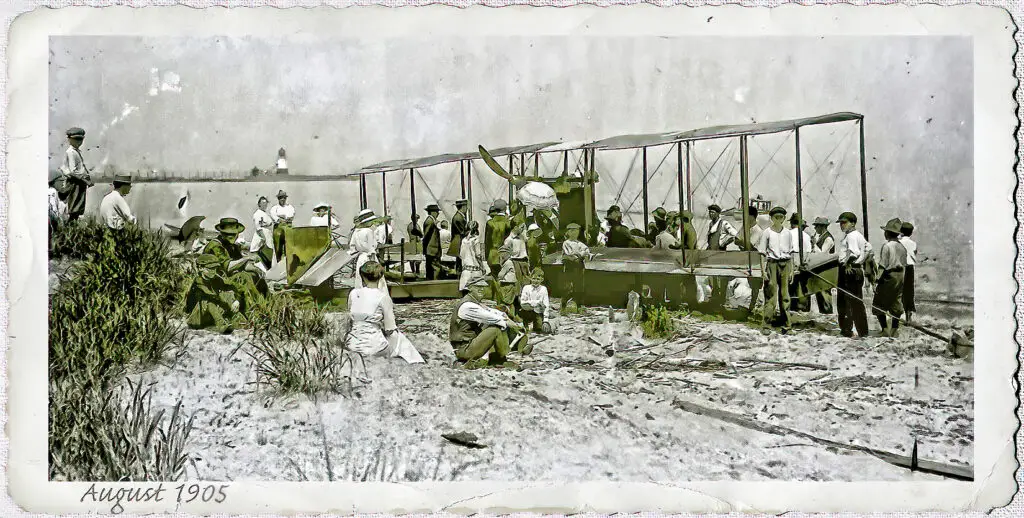
Eighteen years have passed since I initially became acquainted with and wrote about this day in local history. By the looks of things, it must’ve been a nice one. Some miles to the west, at Cedar Point, Ohio, a young flier from Washington D.C. named Anthony “Tony” Jannus (b. 6-22-1889) had been contracted by the manager of the Breakers Hotel to provide airplane rides for guests in his Benoist [ben-owah] Airboat Number 43. He had been working and living there since mid-July. [Note that early aviators were impelled by simple circumstance to use air exhibitions/races and provide persons with rides to help finance their craft, trade, and livelihoods.] Precisely who from Vermilion contacted Mr. Jannus is not known. But it is known that he was contacted and hired to bring his airboat to Vermilion on August 30, 1905, to open the Firemen’s Convention.
The first time I wrote about this event I used a photograph taken by my grandfather showing Mr. Jannus flanked by Vermilion businessman C.A. “Charlie” Trinter and a local haberdasher named Lewis Englebry posing in front of the plane on the beach at Linwood Park. I also have a photo of the plane as it was landing in the lake – and another of the aircraft moored in the river across from the Vermilion Water Treatment plant.
This photo of that event is new to me. I developed it from a glass negative supplied me by Vermilionite Alice Buell. I don’t know where she acquired it. But I’m glad she did. Initially, I didn’t know what was on the negative. And to be honest I was very surprised when I developed it. The identity of the person who captured these shadows is unknown (to me).
The lake appears to be very calm indicating that it was not a windy day. Nonetheless, the plane, facing the lake, is securely tethered to a stake in the sand. The greatest thing about this particular portrait (from my point-of-view) is the crowd that gathered to inspect the craft. There are over thirty people surrounding and inspecting the beached aeroplane. It’s unclear if the pilot is in the crowd. But no matter, it was surely a “significant” event in the lives of all Vermilionites – especially the young boys.
Aside from being a contemporary of Glenn Curtiss (for whom he later worked), the Wright Brothers, and, of course, Tom Benoist (his first employer), Jannus flew the first airplane from which a parachute jump was made, in 1912. He is also recognized as being the very first commercial passenger airline pilot in the world. At exactly 10 a.m. on January 1, 1914, he gave throttle to his Benoist Airboat in the waters of a yacht basin in St. Petersburg, Florida and took off on the first round-trip commercial passenger airflight in history; the St. Petersburg-Tampa Airboat Line was born. He may also be credited with flying the heaviest passenger on a plane at the time when he flew Vermilionite Lewis Englebry (who is said to have weighed nearly 300 lbs.) from the Linwood Beach to Cedar Point on that August day in ‘05. It was a day to remember.
Epilogue: On October 12, 1916, Antony Habbersack Jannus was killed when the Curtiss H Airboat he was testing for the Russian government experienced some mechanical problems and crashed into the Black Sea. His remains were never recovered. He was 27 years old. As the Roman playwright Platus put it, “He whom the gods love dies young.”
© Richard Neale Tarrant – April 16, 2023
![]()
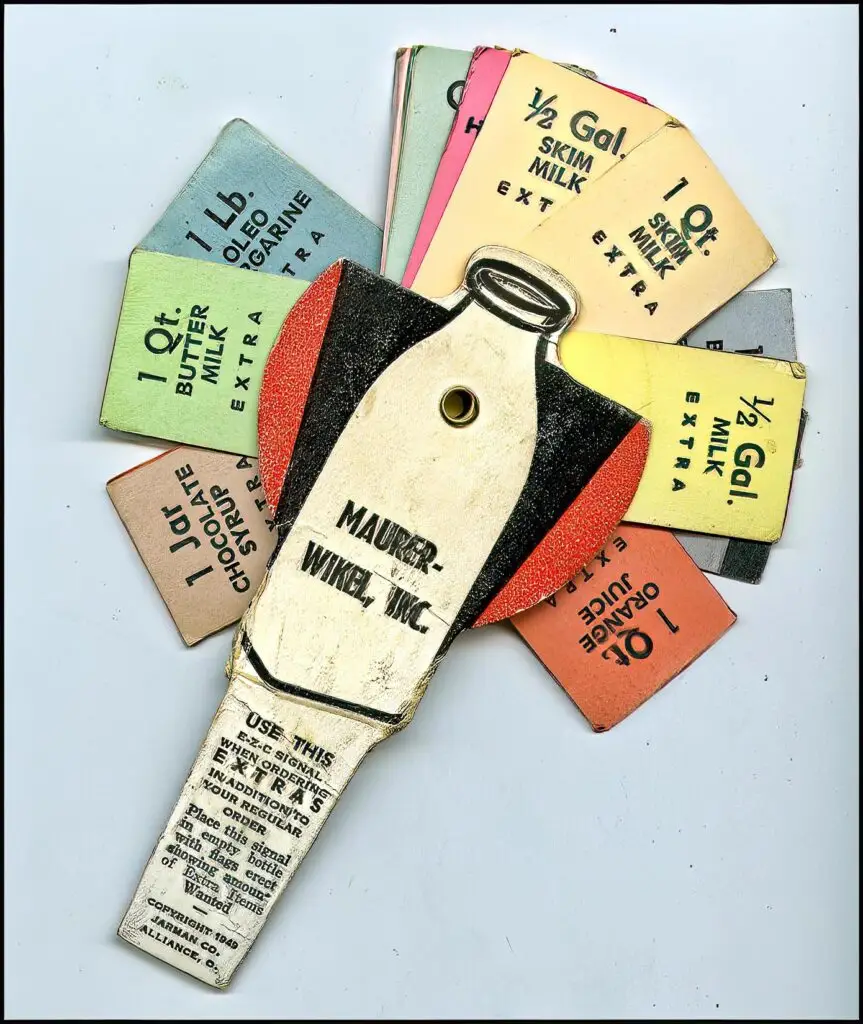
In the yesteryear it used to be an off – but very soft – colored jest to tell a friend “Your daddy was the milkman”. Today the insult likely falls flat for most persons too young to remember the days when milk and sundry other dairy products were actually delivered right to your doorstep fresh from your local dairy. And it wasn’t until Vermilionite Nancy Kneisel-Tate donated the handy-dandy dairy ordering note gadget to the local history museum that I was reminded of those days and just how much things have changed over the last 60 years. Where does the time go?
Years ago, after your (glass) milk bottle was emptied, you’d wash it and set it out on your porch. In the morning the milkman would come by and replace the empty with a full bottle. As one can see, using the little note gadget, you would turn up a product that you wanted to purchase, stick it in the top of the empty bottle and – presto – the milkman would leave it on your porch. There were, however, some drawbacks to this process.
One of the problems with leaving the milk on the porch for any length of time was that prior to the time when most milk was homogenized it was not uncommon to go to pick up a full bottle from the porch to find that the cream had risen to the top forcing the paper cap off the bottle leaving a mess behind. Although homogenizing isn’t done for health reasons; it’s simply a process that shrinks the cream globules and makes them blend in the milk. Some people prefer their milk to have an even texture; it’s a personal preference. Others believe non-homogenized milk tastes better and like the cream top. [My personal preference is homogenized – not chunky – milk.] After a time, (at least in Vermilion) one could acquire a galvanized metal insulated box that would hopefully forestall, or at least delay for a time, the aforementioned mess altogether.
The Maurer-Wikel dairy once located on South Street just east of the old South Street School was the primary source of quality dairy products – commercial and residential – for Vermilion and many other communities in Erie County for at least three decades. There were, of course, other dairies in the area before Maurer’s, but none lasted so long. In the 1960s Ralph Reiter and his son Harold purchased the Maurer operation as well as twenty other small dairies around northern Ohio eventually closing the local business, and another page in local history was turned.
One of my brothers (Al) went to work for the Maurer dairy in his early teens as a “jumper” on the milk delivery trucks. A “jumper” rode in the milk truck with the driver and when they made their stops at homes and businesses, they would help carry the products to the customers and bring the empties back to the truck. Brother Al was a good and very dependable worker. He liked it so much that he continued to work for the dairy throughout the 50s until shortly after Reiter bought it. Just a few names of those that I recall working there years ago were many of the Maurers (of course), John Goolsby, Howard Bogart, Herman Spicer, Dave Wilkes, the Boone brothers Bob, Harold and Wayne, and Ron Millis. (There were more.)
The Maurer dairy was a very cool place, both figuratively and literally. When I was a teen, there were basketball / tennis courts behind South Street school next door where a group of my friends and I used to play half-court basketball during the summer. It was a hot exercise. At some point we’d pool (no pun intended) our funds and have someone go over to the dairy to buy pint bottles of chocolate milk or orange drink. In those days very few places were air conditioned, but the dairy – probably out of necessity – was literally a very cool place. So, buying a cold drink was not only a treat. So was going into the dairy office to buy it.
Now, back to “Your daddy was the milkman”. Because it was the nature of the work for the milkman to visit homes at a very early hour when the lady of the house was alone in the kitchen…well methinks you get my drift. But facts be known there was scarcely time for any amorous rendezvousing. Refrigerated trucks were not made available until about 1954. Prior to that time packed ice kept the products cold. So, in short, time was of the essence when it came to delivering dairy products. At least that’s what my dad always told me.
Ref: Special Thanks: Nancy Kneisel Tate; VPJ 2007; Rev. 2024.
© RNT 2024

VERMILION KIDS
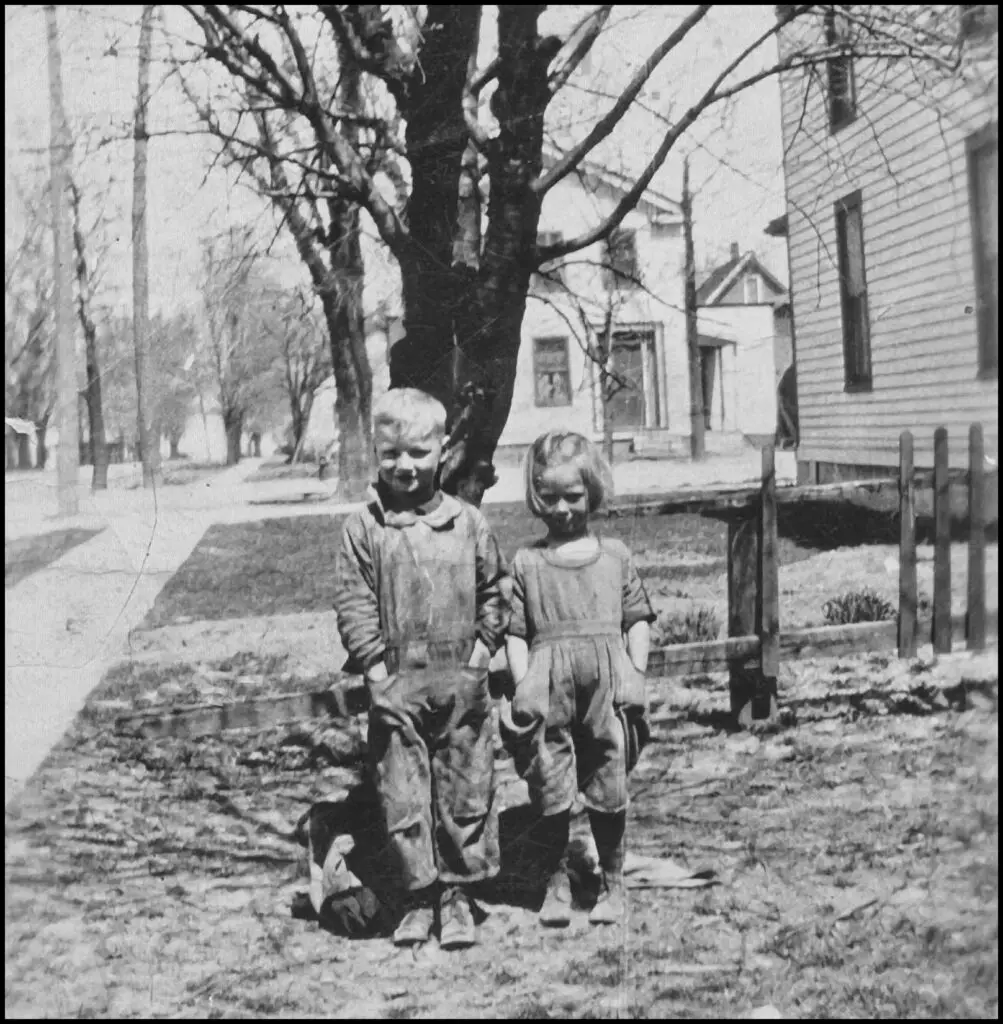
It would be impossible to know what the two rascals in the snapshot subject of this essay were about doing. But you can bet your “kicks” that whatever it was it was fun. By all appearances (i.e. the leafless trees, the absence of leaves on the ground, and the way the youngsters are dressed – as well as their ages) it was perhaps a nice spring day – probably around 1924. Happily standing still (if just momentarily) for their portrait to be captured on the front lawn of their Washington Street home are Bernice and her big brother Fred Fischer Jr.
FAMILY: Their father, also named Fred, was born in Russia the son of Russian parents. The family migrated to America, and to Vermilion at the turn of the 20th century. All Fred’s siblings – 4 brothers and three sisters were very well-known Vermilionites. Fred Sr. who was employed by the B&O Railroad, met a girl named Hattie Johnson while working in the Chicago area. And the rest, as some say, is history. Young Fred and Bernice (pictured) were their oldest children. The couple also had two other children: a boy they named John, and a girl named Mary Jane “Bitsy”.
Fred Sr. was an extremely amiable fellow with a keen interest in seeing that the community of Vermilion, O. would grow and prosper. He served on the village council for many years, and later served several terms as Mayor. His wife, Hattie, was no less amiable. She loved children – both her own and others. For years she played Santa at many Christmas celebrations for Vermilion youngsters. She is also said to have been a wonderful cook and baker. That aspect of her character, no doubt, fit very well with her love for kids. Sadly, in November of 1968 she was struck by a car while crossing the street at the corner of Liberty and Main streets and died of her injuries. Four years later the eldest son, Fred Jr., followed. He was only 55. Bernice married a strapping fellow name Allan Koachway and they had four children: Leroy, Karl, Ellen (O’Hara), and Carolyn (Hill). Bernice died in 1996 and Allan passed in 2001.
“Johnny & Bitsey”: John Fischer later became chief of Vermilion’s Fire Department. He was also known to be a Vermilion historian and as a consequence, was frequently consulted in such matters. He passed away in 2003. His sister, Mary Jane “Bitsey” Laucaitis, passed away in March of last year (2023) at the tender age of 96.
HOUSES: The family home on Washington Street still exists. It is the very first house just south of Liberty Avenue on the east side of the street. The house (a duplex) facing Liberty seen on the right side of the photo just to the north of the Fischer home was razed several years ago. The house, in the background once occupied part of the site where the Ritter Library is today. In the latter part of the 1950s late Vermilionite Melba Knott-Gorbach-Walker purchased the house and had it moved to a new site on the lakeshore behind the place now known (2024) as the Gilchrist House on Huron Street. It, like the former GLHS Maritime Museum that was nearby, has since been eliminated from Vermilion’s landscape. Ironically – or I would not mention it – Melba Walker’s mother, Elsie, was Fred Sr.’s sister.
Well, it’s certainly hard to look at this snapshot of a yesteryear without feeling just a twinge of envy. There – were two children probably having the time of their lives; their futures ahead of them; bright and beautiful. That we know what became of them – good or bad – is irrelevant. In that particular moment they were happy innocents, and all was well with the world. Of course, they were; they were Vermilion kids.
Ref: Special Thanks to: Carolyn Hill and Ellen O’Hara; The Sandusky Register, 1/21/96; U.S. Census statistical data; VPJ 03/25/12; Rev. 01/07/2024.
© RNT January 7, 2024
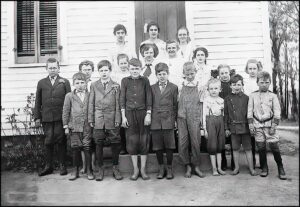
The Year That Leaped
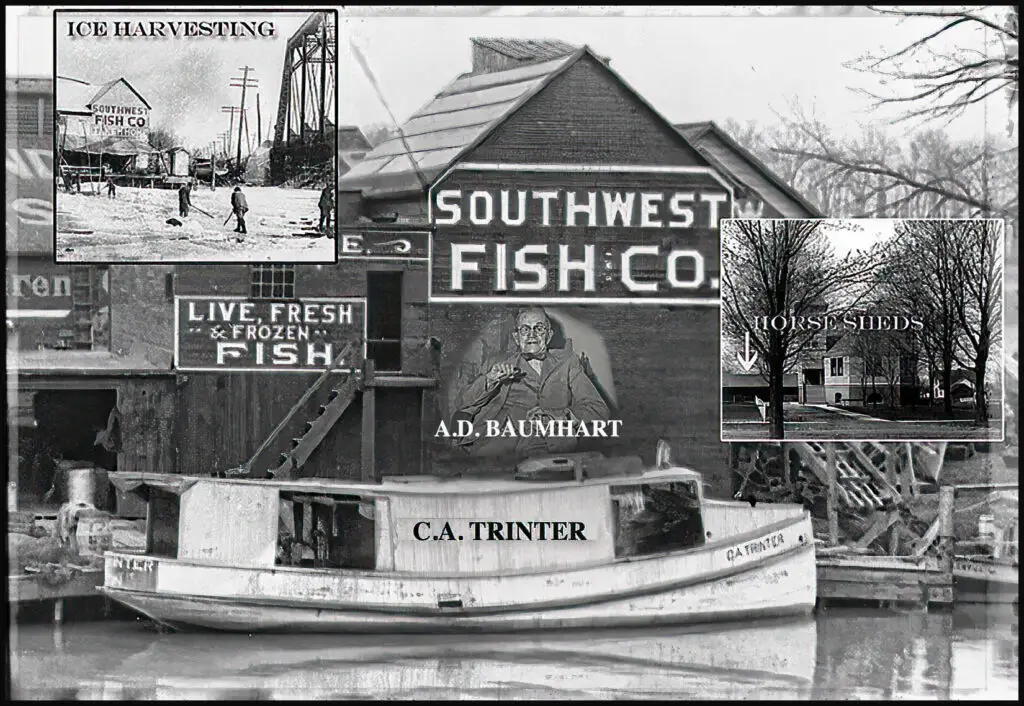
The year 1916, like this year (2024), was a leap year. Most folks may have forgotten but there is actually a tradition started in the British Isles many moons ago that says that during leap years women could propose marriage to men – but only on February 29th. Accordingly, the mid-January edition of The Vermilion News ran an article listing the names, and merits of, about a dozen single men of the village. And though it was intended to be a tongue-in-cheek attempt at matchmaking the information provided about each guy was suspiciously earnest. (Shocking.)
In another report Vermilion Township Trustees discovered that folks were parking their automobiles in the horse stalls in the township sheds at the back of the town hall (pictured) leaving the horses out in the cold. The sardonic report read, “The opinion is that there not half the danger of the automobiles suffering from the inclement weather, and having cases of pneumonia, etc. as with horses so formally give notice that hereafter automobiles should be ‘hitched outside’”. The editor of the News suggested that it was time that either the town or the township find a parking lot. While the problem has been alleviated although 107 years after the fact – the horses, however, are still out of luck.
Just across the railroad tracks on Main / Division Street just a hop, skip, and a jump, north of the town hall local entrepreneur Albert David Baumhart (pictured) had purchased “the lot just south of White’s Shoe Store” on the west side of the street. Workers were busy excavating for a “drain and basement” for a “two-story modern brick building. The ground to be covered will be 28 x 62 feet.” The first floor would house Baumhart’s Drug Store and Ice Cream Parlor. The second floor would be used for offices. “This new building,” said the News, “will be strictly up to date in every particular, and a great improvement to the street as well as to the Village. It will fill the break in the row of buildings.” (The entire block had been destroyed in a fire in December of 1901.)
News then came from Erie, Pa. that the gas tug, Chas. A. Trinter (pictured) owned by Vermilion’s Southwest Fish Company (pictured) had been totally destroyed by fire. It had been removed to Erie for fall fishing and laid up there for the winter. During an early thaw it was carried out into the bay where it mysteriously caught fire. The boat had been built in Vermilion in 1910 and was valued at about $1200. It was insured.
Coincidentally, it was the second boat lost by Southwest Fish in recent months. The Martha W. had been carried out of Vermilion Harbor and wrecked. (It was either a coincidence, or it wasn’t.) Southwest Fish co-owned by “Big” Ed Lampe and Harry Patton was located on the site now the home of Romp’s Marina.
And then there was another report from all the Vermilion fisheries complaining about the terrible ice harvest (pictured). Generally, the fisheries and ice dealer stored from 6500 to 7000 tons of ice. But it was doubtful that any of the ice they had harvested would be stored. Though it was 5 to 8 inches thick it was “very dirty and hardly fit to pack fish in.” Some firms were seriously thinking of destroying the ice, and hoping for it to get cold again that they might acquire a new “clean” harvest.
And that was our Vermilion in early 1916. Things – aside from Baumhart’s new store. The months ahead didn’t like they were going to be brilliant. But it was only January. Yet it was, after all, a Leap Year. February 29th, a day that comes only once every four years was on the horizon. It gave everyone a chance to use the extra day to, perhaps, do something enterprising; to affect a different pattern in their lives. Of course, it did just that. And it still does.
Happy New (Leap) Year!
© Rich Tarrant 2023

WHO'S LEE?
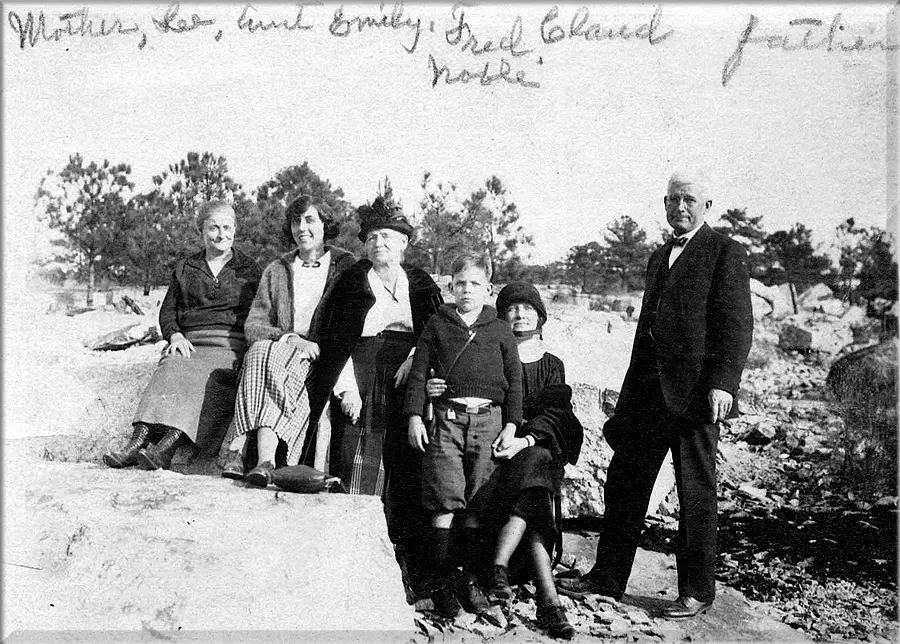
WHO IS LEE (?): “Viewer” Molly Milner sent this great pic of the F.W. Wakefield Family along some time ago with the question:”Do you have any idea who Lee is?
I do not. But she’s a very pretty girl, and I surmise that some “Viewer” might know exactly who she is.
In addition to that I really can’t identify the locale of this photograph. It’s appear to be rather unusual – as if it were near a quarry of some kind. And in the background (just to the left) there appears to be a body of water.
Just guessing – but it may have been taken on one of the islands on the Great Lakes. It should be noted that Molly included the information that tells us that “Claud Noble was a niece of F. W. Wakefield and was visiting from Atlanta“. The name “Claud” is unusual (at least to me).
Hopefully some “Viewer” can shed some light on the identity of “Lee” and the locale of the pic.
© Rich Tarrant 2023

IT HAPPENS (and NOTE: I SHOULD TALK
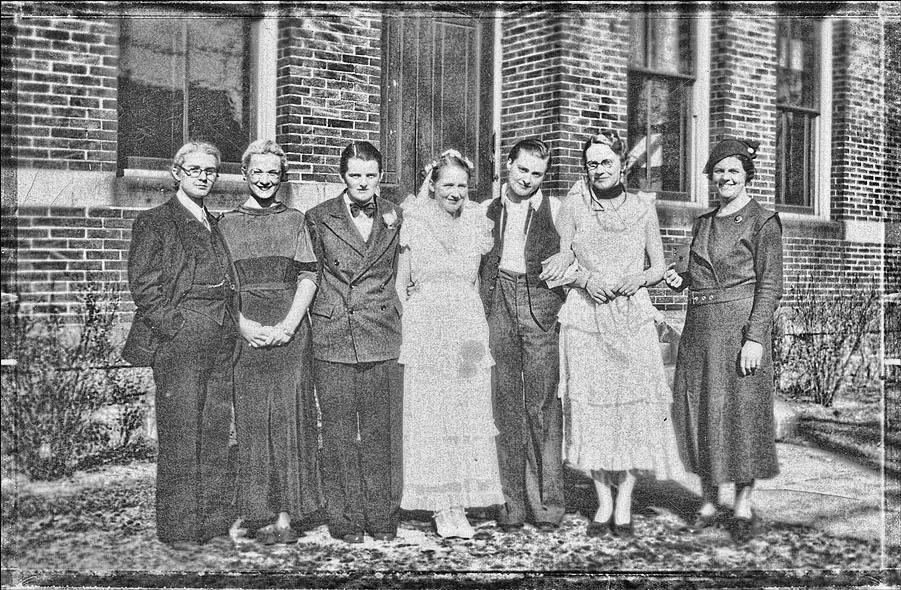
A dozen years ago Vermiionites Leslie and Bud Ennis allowed me to scan a significant number of photos taken by and of members and friends of Leslie’s family (i.e. the George Roberts family) over the years. Among them was the snap accompanying this week’s column.
The photograph was taken on the south side of the Vermilion Township Hall / Opera House around the year 1930. Because I recognized most of the faces of those pictured and I knew that all of those faces were female. But that being said the question that really begs an answer is, “What the heck were they doing?” To be sure, if someone who knew none of these persons looked at the photograph they would more than likely assume that it is the portrait of a wedding party. It ain’t.
Though I am unable to say (at least at this time) the precise name of the dramatic enterprise this group of Vermilion women were presenting to the public at that time it is, more than likely, what they were about doing. What I can say with some confidence is that they were not dressed for Halloween; they were actors in a play being performed on the stage of the Opera House.
From left to right are pictured: Ruby Bogart, Lois Walker, Estelle Smith, Alice Roscoe, Mary Chadwick, Grace Feiszli and Zella English. All were well known Vermilion ladies.
Ruby Bogart Miller was born in 1913 to William and Caroline Bogart who owned and operated a Vermilion dairy farm and dairy on the west side of State Road / Route #60. Vermilion Judge Zak Dolyk currently has a law office on part of the old farm. Many current residents may remember her little sister Nettie Bogart Welch who passed in 2014. Ruby died in 1983.
Lois Walker Eppley was the youngest person in the group. Born in 1916 she lived in a house (now gone) across the street from The Vermilion News on Grand Street with her mother, Pearl, and a younger sister named Audrey. Her father, Claire, was a belated casualty of a freak auto accident near Berlin Heights, Ohio while a passenger in a car driven by local restaurateur M. Okagi. Lois was a secretary for Vermilion’s schools. She died in 1988.
I don’t know a great deal about the gal next to her, Estelle Smith except that she was born in 1913 and passed into the hands of the Lord in 1943.
Alice Roscoe Lindsay was my only aunt. Born in 1911 she attended Ohio State University and came back home to teach Home Economics at VHS. She married a Michigan fella named Ferl Lindsay in 1940. At the time he was first mate on the Great Lakes. A few years thereafter he was promoted to Captain. Alice died in Florida in 2004.
“Miss Mary” Rosalie Chadwick was born in New York State and came to teach in the Vermilion Schools in the 1920s. She was still teaching school when I was a student in the 1960s. As a consequence, she was likely known by more Vermilionites than any of the other women pictured. When she first came to town she boarded with Gladys and Jane Buck on Perry Street. She would later live with her father and sister Annie (also a Vermilion teacher) in a little home on State Street. “Elle a enseigné le français.”
Grace Feiszli Roberts was the youngest child and daughter of Axtel, Ohio farmers John and Grace Blair Feiszli. She married a very popular Vermilion guy named George W. Roberts in the 1930s. George was a successful businessman and was extremely active in the local education system. His sister Emily had married another popular Vermilion fella named Warren G. “Smitty” Smith. Consequently, the family has a long, long history in Vermilion. Her oldest brother, George, was a casualty of the First World War. Grace died in 2003.
The last lady (on the right) is Zella McLaughlin English. A very pretty and kind lady, she was the wife of the longtime minister of Vermilion’s First Congregational Church – Earl Thompson English. She was born in Pennsylvania in 1892 and, I believe, was also a teacher by profession. Her father, John Henry McLaughlin, was a blacksmith. [Amazingly enough I also remember him. And I believe I remember him because I knew he was a blacksmith.] One of my older sisters was given the name “Zella” because my father liked it so much, [My sister, however, did not.] Mrs. English died in 1985.
As I research the backgrounds of those in this group it occurs to me that it may be that they were all working / acting together at that time because they all apparently had some connection to the local school system. I am also struck by the fact that over half of these ladies were 90 or more years of age when they took their leave of this life. Perhaps that tells us something. Perhaps a person evades the ravages of time by working with and for young people. Or perhaps acting in some anonymous drama in a yesteryear is conducive to longevity. Perhaps…
Ref: Special Thanks to: Leslie and Bud Ennis; U.S. Census data 1910 thru 1940; Elyria Chronicle Telegram 12/28/1983; Published in the Vermilion Photojournal 12/10/2015.
© 2015 Richard N. Tarrant
BASIL HENRY - ASSOCIATE EDITOR
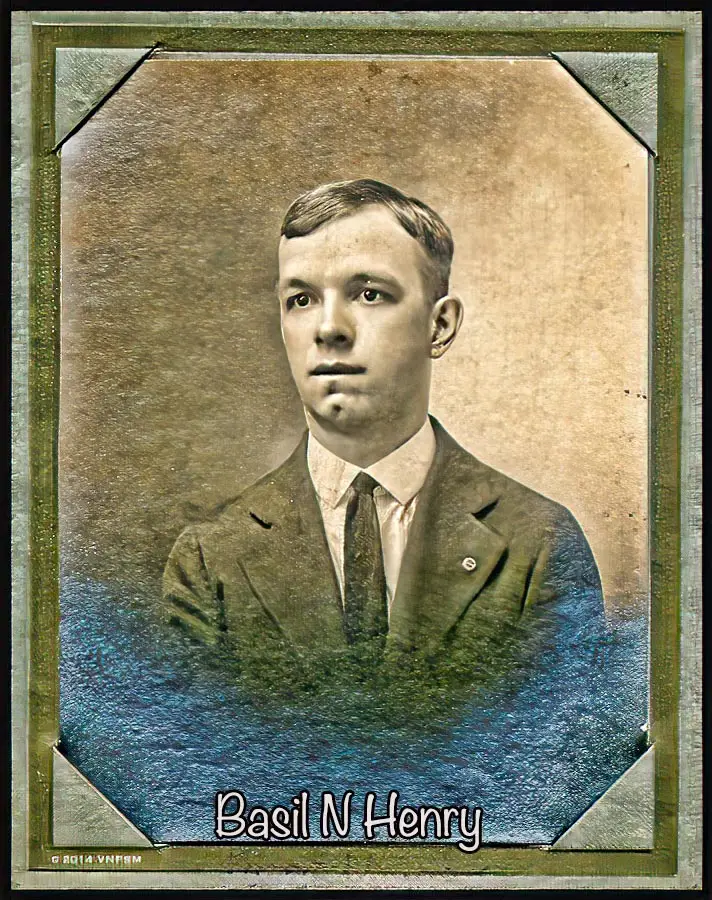
If you go through the micro-files of The News you will find the name Basil Henry listed as “Associate Editor” of The Vermilion News right around 1916-17. So who was this fella?
Mr. Henry was born in Winchester, Virginia, 16 July 1888. I don’t – and probably never will – know how or why he came to be in little Vermilion, but I do know he didn’t stay too long, eventually returning to his home in Williamsburg, Virginia. 1930 found him in Morgantown West Virginia where he was working as a printer in an unidentified print shop. [Perhaps he owned it.] But by 1940 he was back in Williamsburg, Virginia working as printer in a daily newspaper.
His first marriage to a lady name Myrtle Kreme in 1911 apparently failed. But he later married a lady named Lula [ I could not discover her maiden name] and the couple had a son they named Forest, born in 1923.
Basil died January 1, 1966, and was laid to rest in Williamsburg Memorial Park, James City County in Virginia. Lula died in 1998 and is buried at his side.
I’m guessing, of course, but it may be that he was just learning the newspaper trade with Roscoe when he worked for THE NEWS. As indicated, he wasn’t here for any great length of time. I believe he left the NEWS and Vermilion when the U.S. became involved in WW1. I obviously tracked him back to West Virginia following the war, and I know he remained in the printing business for the remainder of his life. I know he married again. And I did communicate with one of his g-grandchildren some years ago. I was looking for a more recent photo. But for some reason none were available. (Maybe someday.)
I came across his pic some time back at the print shop museum – which led me to look for more information about him. We also have his marriage certificate from his first marriage that he probably left behind when he departed Vermilion – on purpose.
© RNT November 25, 2023

The Leaning Light of Vermilion
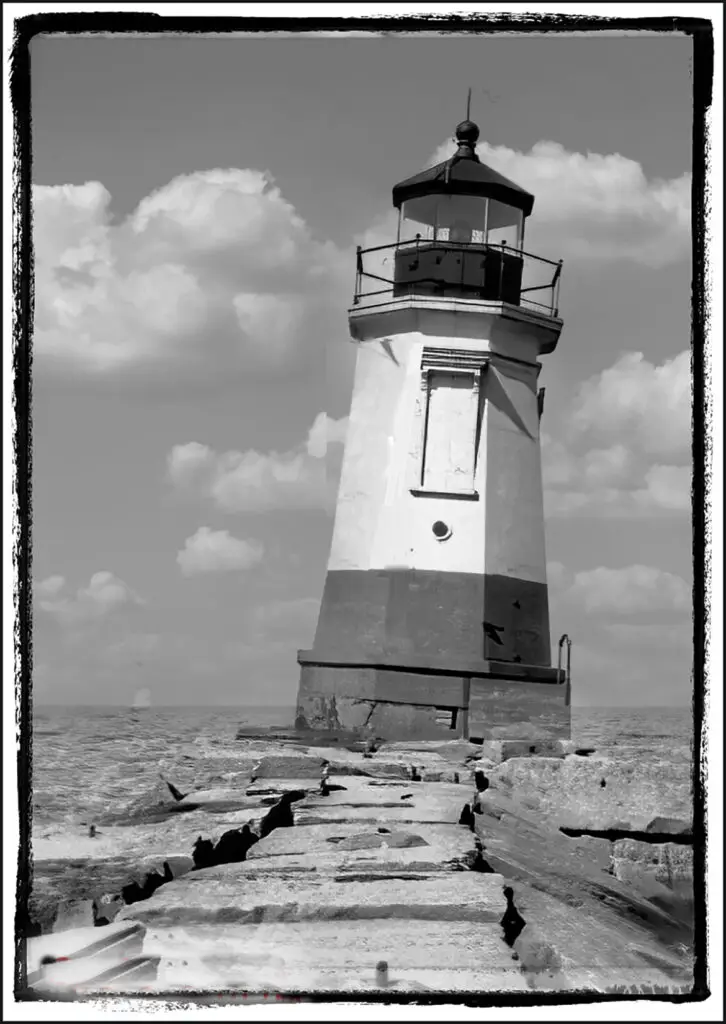
In 1929 a little man with a dash of moustache neath his nose and a big mouth was rising to power in Germany. In the U.S. Calvin Coolidge was handing over the Presidency to Herbert Hoover, and the dark clouds of a great world depression were about to settle over the planet. In Vermilion a new river bridge, situated perhaps 75 feet north of the old, had just been completed at a total cost of about $132,000. A beloved doctor named Morey Jeffery on his way to tend to a patient was killed at the Adams Street rail crossing just after Christmas. Some local boys, Bud Fischer, Nelson Becker, Carl Knott, and Milton Benson mounted an airplane propeller on the back of an old Ford chassis, and with a Ford engine on the back of it claimed the vehicle could run at 55 mph over ice without a problem. And the Roaring 20’s that many believed were destined to go out with a bang did not. It was, in fact and deed, more of a whimper. The face of America was changing (again), and so was that of Vermilion.
In late March young Ted Wakefield, son of local yachtsman and head of the F.W. Wakefield Brass Company, Fred Wakefield, looked across Vermilion’s harbor from the family home just above the Main Street beach, and noticed that the lighthouse at the entrance of the west pier was leaning dangerously to the east toward the river. He immediately informed his father and, consequently, authorities of the problem.
After some seven decades of service to sailors on Lake Erie the stone foundation of the sturdy iron structure had fallen victim to the crashing waves of summer storms, heavy ice floes so common in the late winter thaws and fast-moving spring floods along the waterway. After alerting proper authorities, a decision was made to have the light removed.
As a result, a crew of government workers under the supervisory eyes of O.W. Stevens of Lorain and government engineer, A.J. Savord of Sandusky, dismantled the light. It was moved to Charity Straits on Lake Ontario where it can, by the way, still be seen today. The old Vermilion Light was subsequently replaced by a, then modern, 18-foot skeletal frame tower topped with a light and equipped with a fuel tank. As some persons may already know advances in technology have now made most lighthouses obsolete – including the Vermilion Light on Lake Ontario – and have now been decommissioned.
HISTORY: Vermilion’s Lighthouse was constructed nearly a decade after our little village was incorporated. It was rebuilt twice, once in 1859 and again in 1877. Initially the light sat several yards back from the tip of the west pier. In 1893 it was moved north almost to the end of the stone jetty which formed its base. Aside from its practical service as a guiding light for commercial and pleasure craft whether the great lake slept peacefully or raged on mercilessly during howling storms, it also served as a beacon of romance for young lovers, and as subject matter for many a photographer.
Since about 1919 when acetylene replaced oil as a fuel for the lamp only a part-time lightkeeper had been required to service it. But prior to that time at least six different men had served as full-time keepers of the light. The first in the memory of most locals was a gentleman named Tom Allen. Following him were the Messrs. Miles and Harris. Because this was a government position housing was included as a benefit for these people. Harris may have been the first to live in the government house provided on the southwest corner of Grand and Liberty Streets. When Harris died a Mr. Codding took over until he exchanged positions with Mr. J.H. Burns from Buffalo, New York who held the position until he retired.
TODAY: There may be hundreds – or perhaps even a thousand – different photographs of the original Vermilion Lighthouse in existence. There are easily a dozen in the photo archives at Vermilion History Museum not to mention many more in the collections maintained by the Vermilion Historical Society. Actually, there may now be twice that number of the replica at Main Street (the place many native Vermilionites know as “Wakefield”) Beach. And there will undoubtedly be thousands more in years to come. However, this snapshot may very well be the last – or at least one of the last – of “Leaning Light of Vermilion”. And it’s a gem.
Ref: Thanks to Franklin A. and Mary Lynn Myers Homitz for the “Leaning Light” photograph.
© RNT November 12, 2023

BRIDGE STATION - ERNIE HAYES
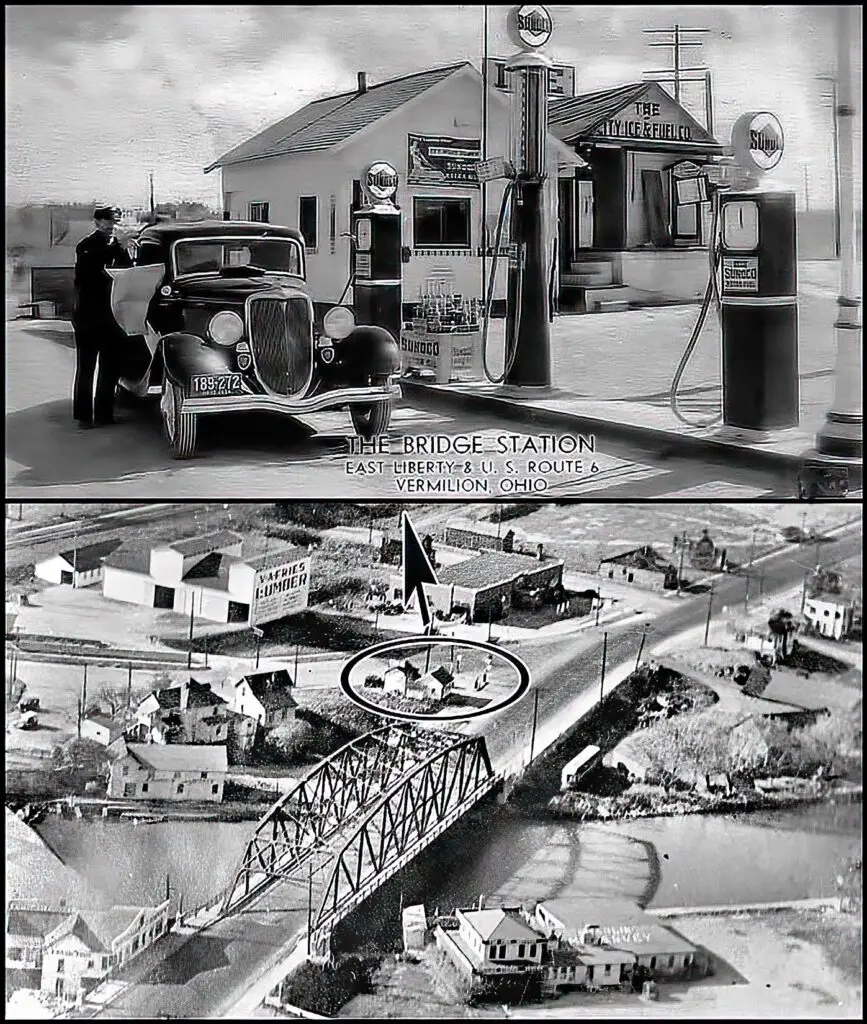
In 1934 – the year the photographs accompanying this week’s essay were captured – America was struggling to emerge from the economic rift now commonly referred to as “The Great Depression”. The average cost of a new house was about $6000; bread was 8 cents a loaf; hamburger 12 cents a pound; a shiny new Studebaker truck ran around $625; a gallon of gas was 10 cents; and the average yearly wage was $1600. But no matter; life in America was bound to move briskly along, and a new guy in town named Ernie Hayes was ready, willing, and able to move right along with it.
Though born in Jewell County, Kansas in July of 1881, Ernest Joel Hayes came of age on a farm in Wakeman, Huron County, Ohio. By 1910 Ernest and another Wakeman fella named Ralph French were lodging in a home owned by one Andrew Ross in St. Paul Minnesota and busy making candy in a candy factory. A decade later found him in Owosso, Michigan working in a sugar factory. By that time, he had married a Michigan gal named Ella Mae Turner, and they were parents of three children – Ross, A. Maxine, and Harry. Ten years later (1930) there was another addition to their family. She was named Evelyn. However, her big brother Harry thought her so precious he nicknamed her “Nuggie” (like the gold nugget). It was a name that never left her.
Meanwhile Ernest had left the sugar business and was working as an automobile mechanic in Owosso. 1930, of course, marked the beginning of the depression years. And though small business opportunities during those years were likely as risky as they were rare, by the mid 30s the Hayes family had returned to Ohio and Mr. Hayes had founded “The Bridge Station / The City Ice and Fuel Co.” selling Sunoco gas in Vermilion.
The station, as much the name implies, was located just west of the Vermilion River bridge on a triangular bit of land between Liberty and Water / West River streets (circled in lower photo). Very few persons about town today (2023) may be aware of the fact that it was originally a Sunoco station. Most remember it as having been a Standard Oil station. Neither are many folks now familiar with the station as it appeared in 1934. At some point in time a new garage was erected on the site. That garage building currently survives under the rather attractive guise of Jerry Pearl’s office for Allen-Thorley-DeLloyd Insurance.
Mr. Hayes was a very hard worker and quickly earned a reputation for being honest, friendly, and kind. He was not unknown to allow credit to persons who were down on their luck. And most returned the kindness. When Ernest passed away in November of 1960 his son, Harry, took over the operation of the garage / service station extending and furthering the same courtesies to his patrons as did his father.
A good deal of water (and ice) has passed under both the proverbial and real bridge aside and behind it since the namesake filling station disappeared from the local landscape. One might say that the world is worse because of these passings, but that would be somewhat short of the truth. For it is certain that the past is the foundation of today whereupon the cornerstone of the future is being set. So, it’s hard not to admire Mr. Hayes and folks like him who forged ahead during the difficulties of that yesteryear. To reincarnate a long-lost Standard Oil Company salutation, “Sohio Everyone.”
Ref: U.S. Census data: 1880, 1900, 1910-20-30-40; Special thanks to Mike and the Hayes Family photo archive; VHM photo archive; VPJ 03/13/14; Rev. 10/27/23.
© RNT October 29, 2023

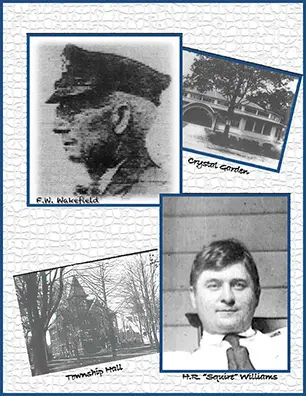
My basic Vermilion research over the last 15 years has thus far has primarily been concerned with the first 15 years of the 20th century. This was shortly after one “el” was removed from the formal name of the village. The “el” was removed by the U.S. Post Office in 1898 to avoid confusion between our community and one with the same name just south of Ashland. Now back to my research.
Our current political environment seems wrought with disagreement, vitriol, misrepresentation, and resentment – not necessarily in that order. It’s annoying. And I blame some of it on social mediums such as Facebook and Twitter – or what have ye. (i.e., allowing people to state things without accountability.)
People often talk about “The Good Ol’ Days” as if nothing like we’re experiencing today ever took place. (At least on a local level.) But that ain’t really the case.
Back in 1912 etc., 1915 there was plenty of that rubbish going on. And folks weren’t really very nice to one another. Even then, some things were being misrepresented.
In 1911 local industrialist F.W. “Fred” Wakefield ran for Mayor. His opponent was the well-known local attorney H.R. “Squire” Williams. At the time Mr. Williams had held the office since 1900.
During Mr. Williams tenure as Mayor things around the village began to change. For one thing Shadduck’s Grove had been purchased by a Lorain man named Calvert, and the relatively benign amusement park expanded, and new rides were purchased to entertain the increasing number of folks who visited.
Now that, I’m sure, was not really a bad thing. More people undoubtedly meant more money for the village. However, problems began to develop with visitors who were ill-mannered. The antics of some ne’er-do-wells kept the local marshal busy. Some of this began to spill over into local saloons and other businesses around town. It became – to a good number of local residents – bothersome.
Mayor Williams was – what I’d term to be – an intelligent, relaxed personage who could and did handle such persons with a good deal of understanding. If he tossed some “Tosser” in the ‘lock-up’ at the back of the town hall there was no one to look over them. But more importantly he realized that many of these fellas had families and making them pay big fines or keep a residence, in jail might very likely cause more harm than good to anyone. As a result, he was inclined to level a small fine and boot them out of town – hopefully forever.
Unfortunately, for everyone things did not seem to get better using this philosophy. And that is where F.W. Wakefield came into play. He was a law-and-order candidate, promising all that he’d go by the “proverbial book” when dealing with these (and all) individuals – and did following his election in 1911.
The laws regarding saloons and liquor sales in town were enforced. At first it didn’t make some folks happy. But following through with administering the laws and other legislation in the village was eventually accepted by townsfolk.
Then in the year 1915 the town was about to take a big step forward. A Sewerage system was to be built. Though Squire Williams had doubts about such a project and was vocal in his opposition the editor of the News answered his objections in an October editorial noting, “there is a difference of opinion, and if those opposed really mean what they say instead of allowing political capital be to be made of it, get down to business and investigate through a committee of reliable citizens.”
I don’t know how many minds were changed (or battered) during the ensuing contest, but the Squire regained the office. To be honest both men served our town in those developmental years with purpose and dignity.
And Vermilion did just fine without the extra “El” in its name.
© RNT October 22, 2023

VERMILION'S WOMAN'S RELIEF CORPS
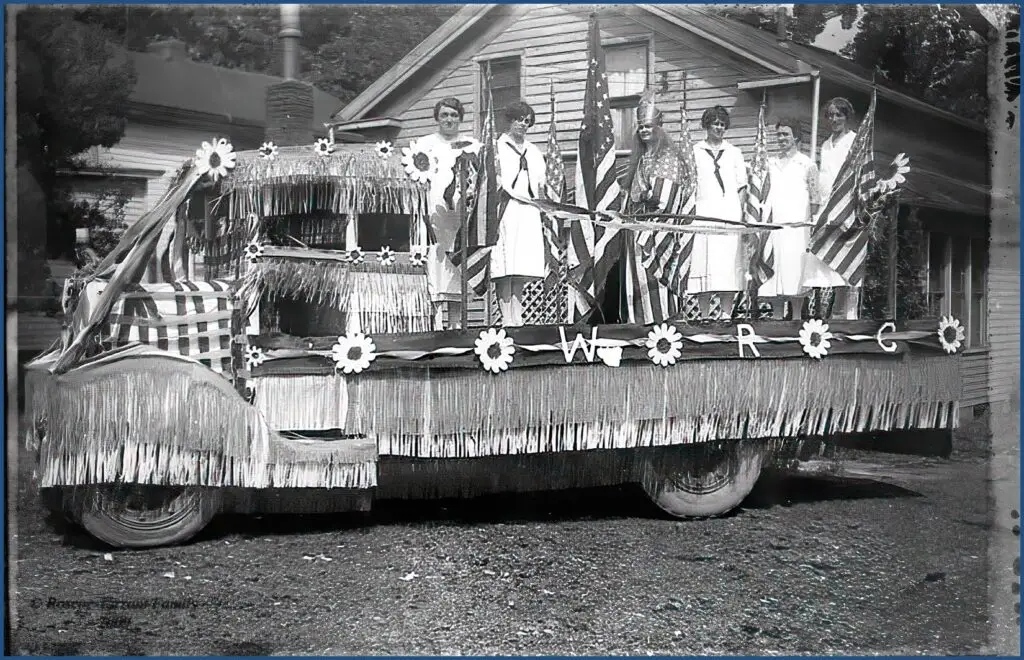
Prior to the American Civil War, the role of women in our society was restricted to home management, bearing and rearing the children, and in rural communities running the family farm. Proper etiquette demanded that no proper lady should leave the house without a gentleman as an escort. When the war broke out those things changed. They had to. With fathers, husbands, sons, and brothers marching off to war women had to adapt to survive although they still could not vote nor sign legal contracts. And while they could not remain “proper ladies” and take up arms they did respond to both the call and the cause as nurses, laundresses, spies, cooks, Sanitary and Christian Commission workers, and writers for newspapers. As the terrible war changed the face of American life so too did it forever alter the role(s) of women in our society.
In essence the Woman’s Relief Corps (WRC) was an auxiliary partner of the organization known as the Grand Army of the Republic, a fraternal organization composed of veterans of the American Civil War. (VPJ 02/19/2004) It was literally, to borrow from a well-worn phrase, “the mother of all U.S. veteran’s auxiliary groups”.
Vermilion’s Chapter of the WRC is purported to be the first. female patriotic organization in the village. The H.G. “Henry” Delker Woman’s Relief Corps, Chapter 328, was organized on May 19, 1910. Some might note that it is the Woman’s, not Women’s, Relief Corps.
Henry Delker was a local dry goods businessman. At one time associated with Mr. Englebry they operated a store in a building that would later house the Liberty Theater [Currently (2023) a business known as the Art Seen]. Delker died on December 26, 1891, from a shoulder wound he received during the war. The musket ball that wounded him had not been removed and “had ruptured the diaphragm…finally resting upon the sacrum…” He was very likely Vermilion’s last Civil War casualty.
The WRC complimented the efforts of the GAR organization by providing food, clothing, and other sources of aid to veterans, their wives, widows, and other members of their families. Locally the group also raised funds to help care for children at the Xenia, Ohio Orphans Home, created an Army and Nurses fund, gave money to the Red Cross, and the Vermilion Drum and Bugle band. They also provided playing cards, cigarettes, candy, and books to the Soldiers and Sailors Home in Sandusky, and sent canned fruit, cookies, and funds to the Madison home for elderly ladies. They provided the school, the All-American Girls, the Village of Vermilion, and Vermilion Girl Scout Troop #1 with silk flags. At Christmas time they distributed boxes of fruit to shut-ins. On Memorial Day they planted geraniums and placed flags on the graves of veterans in Maple Grove, Brownhelm, and Rugby Cemeteries. They also participated in parades on Memorial Day, Flag Day, 4th of July, and the one celebrating Vermilion’s Centennial in 1937 (pictured).
There were 29 charter members of this group. Some older Vermilionites will recognize their names. Hattie Baxtine was the first president. Hattie Cuddeback was the first secretary, and Carrie Boss was treasurer. By the year 1940 only 3 of the charter members remained; Hattie Cuddeback, Marcia Wittmer, and Carrie Boss. By this time all the veterans in Vermilion’s GAR Post had, as remaining WRC members then put it, “passed to the Land of Peace”.
Over the years they remained very true to their chapter’s motto, “We pledge allegiance to the flag for which it (our Republic) stands.” And as if following the lead in a line of an old W.W.I British Army song, “Old soldiers never die / They simply fade away”, both the GAR and WRC just simply “faded away”. Both organizations and members now belong to history, but their spirit still abides in every veteran and veteran’s organization in our pretty little city and, as it remains and has always been, our great nation.
Ref: The Way It Was – Vermilion 1807-1984; Betty Trinter, 1984; The Vermilion News: 6/27/40.
© RNT 10.08.2023

.
The Greatest Train

Would you believe that trains have been running along the Lake Erie shore through Vermilion, Ohio for almost (“almost” being a relative term in this instance) as many years as the town has been officially incorporated? It’s true.
The first steam engine chugged through the village on the Junction Railroad in 1853. The line would later become the LS&M (Lake Shore and Michigan Southern), then the NYC (New York Central), and then CSX/Conrail/Norfolk-Western. Some of the first engines were given affectionate names by the townspeople. One was called the Vermilion. And another, christened Jenny Lind, was brought by water from Buffalo, and hauled to the tracks by a team of oxen. The Nickel Plate rails (those passing through the southern part of town) were laid through the village during the latter part of the 19th century.
Our – the Tarrant – family home was just south of the NYC tracks on Perry Street. Consequently, many of the trains were familiar to us as was the familiar sound of the dishes rattling in our cupboards as they passed. One of them – the very best – was the NYC 20th Century Limited.
The New York Times once reported that rail buffs called the Limited, “…the world’s greatest train.” It was a passenger train that ran between Grand Central Terminal in New York City and LaSalle Street Station in Chicago. Inaugurated on June 17, 1902, for the next 65 years it catered to upper class folk and business travelers and could make the run between the cities in a mere 15.5 hours. Keep in mind that this was 12 years before the very first American commercial air flight. (VPJ, 5-19-05)
Only making station stops between those cities to refresh water and coal supplies it sped along the 800-mile rail course known as the “Water Level Route” at an average speed of 50 mph – though I’d swear it was doing 70 mph when it passed through Vermilion.
Both the locomotive (upper photo) and diesel-electric (lower poster photo) as well as the passenger cars on both were designed in an Art Deco style and carried the blue and gray trademark colors of the NYC. [Note: the steam engines were replaced by diesel-electrics in 1946] Passengers walked to and from the train upon a specially designed plush crimson carpet that was rolled out for them at station stops. And thus (for trivia buffs), the term “red carpet treatment” was borne.
During its peak years it was believed to be the most profitable train of its kind in the world. In 1928 it brought in revenues of some $10 million. Its passengers included former U.S. President Theodore Roosevelt, mega-millionaire banker J.P. Morgan (the elder), Opera singer Enrico Caruso, actress Lillian Russell, and financier “Diamond Jim” Brady.
When I was but a lad, I recall sitting with my family on the front porch of our Perry Street home during many a summer twilight watching the train speed by on its way to the “big city”. I could see the passengers inside the cars sitting, talking, and walking. And I would wonder who they were and where they were headed. I hadn’t heard of many of the folks I’ve previously listed at that time. Anyway, it certainly wouldn’t have occurred to me – nor mattered – that any of them would be among the passengers. What I remember the most is the lighted logo on the back of the train’s observation car as it sped past. It read “20th Century Limited”. It was, in a young boy’s eyes and dreams, a Rocketship from the yesteryear shooting headlong into the future.
Ref: The Way It Was, Book 1; Betty Trinter; VPJ 2/30/06.

A Fishy Story

Back in the 1960s – I worked at a little Vermilion restaurant called the Kountry Kitchen. It occupied rooms where the Old Prague is today (2023). It was a working-class – meat and potatoes – eatery with reasonably priced meals along with a hearty helping of small-town gossip. The food was not just good. It was very good. Like many little diners of that era there was always a daily 99¢ meal – a veritable blue-plate special – that included an entree, choice of potatoes, vegetables, and salad. The beverage was extra. Needless to say, it was a popular place.
In those years Vermilion was then still an active commercial fishing port. As a result, Friday’s special was always a yellow perch dinner. And to say that it was a popular meal is a vast understatement. More often than not there was often a queue of hungry diners out the door. If we ran short the fish were in easy supply just down the street at either the Kishman Fish House on the river or the Dennis Fish Market. The Dennis place was located in the building just above the Moes Marina. It was gastronomic madness. Many of the fish consumed by diners on those crazy Fridays had very literally been swimming in Lake Erie just a few hours earlier.
Although born and raised in our Vermilion I have been exceptionally ignorant when it comes to the commercial fishing industry. My ignorance is embarrassing. If someone had asked me just a few months ago to point out a photo of a Gill Net turtleback tug or a Trap Net boat, I would’ve drawn a blank. All I knew is that both were fish tugs. And this would’ve continued if I’d not found myself frequently sitting in a medical waiting room over the summer.
I normally read maybe 2 novels a month. Fiction is usually the choice of my reading material. In this case I was able to read two books whilst I waited. Neither one was fiction. (It beats staring at the walls.) The first was one written by a Washington D.C. Metro Police Officer named James Fanone describing his January 6th experience defending our Capitol. (It was enlightening.) The second was a book I’ve had sitting around the house for several years intending to read but had not. The book is titled “Lake Erie Fishermen – Work, Tradition and Identity” by Timothy C. Lloyd and Patrick B. Mullen (pictured). Aside from owning the book for years, the main reason I chose this book is because there are people, places, and things in this book with which I am familiar. Moreover, I also have audio recordings – courtesy of local historians Bill and Glenn Cutcher – of the subjects being interviewed for the tome. (This may be the reason I had not yet read the entire book until now.)
Some of those interviewed for the book were late Vermilionites Chester Jackson, his wife Esther, Alva Snell, Ray Full and George Wakefield. And while it certainly touched on their personalities (how could it not?) I also received a fundamental education on commercial fishing past and present. I needed that.
In addition to the fishing business the men interviewed also spoke some about a few of Vermilion’s more colorful mariner personalities such as Morris “Gib” Snider and Captain “Big Ed” Lampe (also pictured). No conversation about Lake Erie fishermen from Vermilion would be complete without mention of at least these two fellas. And it’s interesting to note how the persons interviewed describe these men.
For some “Gib” is a drunken clown with a rowboat. But for others he is a rather slovenly, but nonetheless skilled, fisherman – a loner who was fearless – who thought nothing of navigating a small boat from Vermilion to Fairport Harbor and back by himself. Captain Lampe, on the other hand, is portrayed as a complete opposite of Snider. He is described as larger-than-life hero; a sort of Lake Erie “Paul Bunyan”. Folks did not refer to him as “Big Ed” for nothing.
Well, I’m sorry I didn’t read this book sooner. Every native Vermilionite should know at least a little about commercial fishing as well as something of the sailors who manned the tugs and farmed the watery fields of Lake Erie. After all it was a primary business in the town for at least a century. It was both a hard and often precarious occupation requiring skills not available in textbooks or in a YouTube video. They are skills all these men were obviously proud to have learned, earned, and mastered. And every time I enjoy a fresh perch sandwich or dinner, I’m glad they did.
Vermilion resident Rich Tarrant is Curator of the Vermilion History Museum and a son and a grandson of the late proprietors of The Vermilion News (187-1964). Readers may email him at: rnt@twc.com
© 09.17.2023

Back in the 1960s – I worked at a little Vermilion restaurant called the Kountry Kitchen. It occupied rooms where the Old Prague is today (2023). It was a working-class – meat and potatoes – eatery with reasonably priced meals along with a hearty helping of small-town gossip. The food was not just good. It was very good. Like many little diners of that era there was always a daily 99¢ meal – a veritable blue-plate special – that included an entree, choice of potatoes, vegetables, and salad. The beverage was extra. Needless to say, it was a popular place.
In those years Vermilion was then still an active commercial fishing port. As a result, Friday’s special was always a yellow perch dinner. And to say that it was a popular meal is a vast understatement. More often than not there was often a queue of hungry diners out the door. If we ran short the fish were in easy supply just down the street at either the Kishman Fish House on the river or the Dennis Fish Market. The Dennis place was located in the building just above the Moes Marina. It was gastronomic madness. Many of the fish consumed by diners on those crazy Fridays had very literally been swimming in Lake Erie just a few hours earlier.
Although born and raised in our Vermilion I have been exceptionally ignorant when it comes to the commercial fishing industry. My ignorance is embarrassing. If someone had asked me just a few months ago to point out a photo of a Gill Net turtleback tug or a Trap Net boat, I would’ve drawn a blank. All I knew is that both were fish tugs. And this would’ve continued if I’d not found myself frequently sitting in a medical waiting room over the summer.
I normally read maybe 2 novels a month. Fiction is usually the choice of my reading material. In this case I was able to read two books whilst I waited. Neither one was fiction. (It beats staring at the walls.) The first was one written by a Washington D.C. Metro Police Officer named James Fanone describing his January 6th experience defending our Capitol. (It was enlightening.) The second was a book I’ve had sitting around the house for several years intending to read but had not. The book is titled “Lake Erie Fishermen – Work, Tradition and Identity” by Timothy C. Lloyd and Patrick B. Mullen (pictured). Aside from owning the book for years, the main reason I chose this book is because there are people, places, and things in this book with which I am familiar. Moreover, I also have audio recordings – courtesy of local historians Bill and Glenn Cutcher – of the subjects being interviewed for the tome. (This may be the reason I had not yet read the entire book until now.)
Some of those interviewed for the book were late Vermilionites Chester Jackson, his wife Esther, Alva Snell, Ray Full and George Wakefield. And while it certainly touched on their personalities (how could it not?) I also received a fundamental education on commercial fishing past and present. I needed that.
In addition to the fishing business the men interviewed also spoke some about a few of Vermilion’s more colorful mariner personalities such as Morris “Gib” Snider and Captain “Big Ed” Lampe (also pictured). No conversation about Lake Erie fishermen from Vermilion would be complete without mention of at least these two fellas. And it’s interesting to note how the persons interviewed describe these men.
For some “Gib” is a drunken clown with a rowboat. But for others he is a rather slovenly, but nonetheless skilled, fisherman – a loner who was fearless – who thought nothing of navigating a small boat from Vermilion to Fairport Harbor and back by himself. Captain Lampe, on the other hand, is portrayed as a complete opposite of Snider. He is described as larger-than-life hero; a sort of Lake Erie “Paul Bunyan”. Folks did not refer to him as “Big Ed” for nothing.
Well, I’m sorry I didn’t read this book sooner. Every native Vermilionite should know at least a little about commercial fishing as well as something of the sailors who manned the tugs and farmed the watery fields of Lake Erie. After all it was a primary business in the town for at least a century. It was both a hard and often precarious occupation requiring skills not available in textbooks or in a YouTube video. They are skills all these men were obviously proud to have learned, earned, and mastered. And every time I enjoy a fresh perch sandwich or dinner, I’m glad they did.
Vermilion resident Rich Tarrant is Curator of the Vermilion History Museum and a son and a grandson of the late proprietors of The Vermilion News (187-1964). Readers may email him at: rnt@twc.com
© RNT September 17, 2023

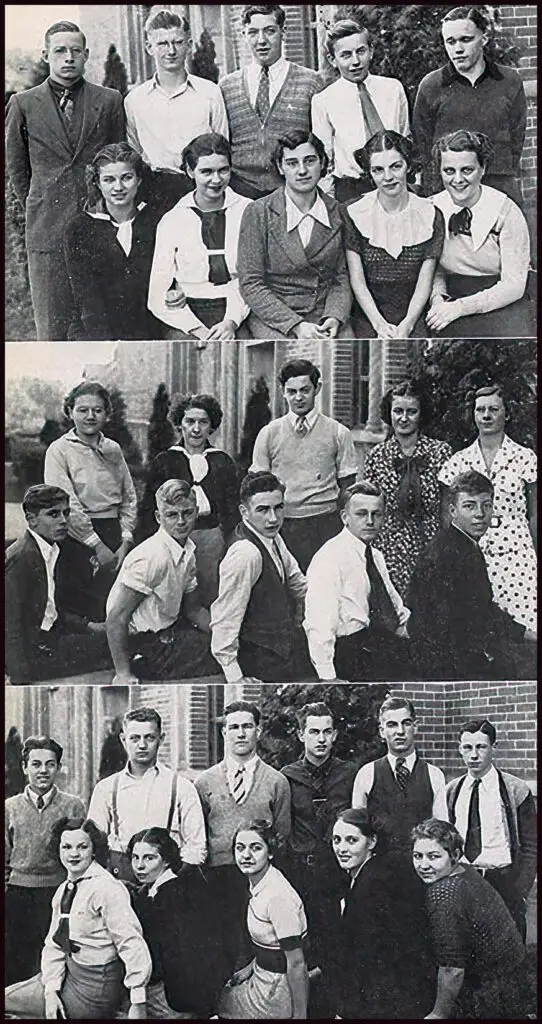
Like many of the photos acquired for these weekly essays the histories of how they’ve been obtained – and from whom – are often as fascinating as the photos themselves. Although the portrait accompanying these words this week is hardly rare – one could easily find a copy at the Ritter Library – the path leading to this particular reproduction was a tad more convoluted. But first it might be wise to date and place some names with faces of persons in the photographs.
Pictured is the Junior Class of Vermilion High School (at South Street school) in 1937. Beginning with the top photo, L-R, are Charles Gegenheimer, Earl Beiner, Paul. Becker, Elton Bachman, and Theodore Collit. Sitting: Gayle Furgason, Virginia Fischer, Mary Grego, Kathryn Eastman, and Helen Friday.
In the middle photo are Adele Kovanic, Edna Hoffman, George Kominis, Anna Matas, and Mary Lezak. Sitting are: Carl Kuhl, Donald Kishman, Albert “Jim” Hart, Richard Gorbach, and Harvey “Buck” Rodgers.
In the bottom photo are James Sennhenn, Dan Schisler, Robert West, Richard Walker, Robert Weigel, and Gordon Sprigg. Sitting are: Audrey Walker, Madeline Wallace, Joan Nieding, Berdina Stokes, and Betty Jane Sylvester.
Now – to describe the roundabout path that brought this photo to my attention. About 18 years ago a person named Bobbi (aka “Roberta) Neller-Riley who lives in Santa Maria, California contacted me offering to send me some photographs from her family album. Bobbi, as it turned out, is the granddaughter of late Vermilionites Ruth (Goodsell) and Elton Fischer. [Note: The family operated a thriving lumber company along the river; owned the Maud-Elton Hotel; and built the Fischer building on the southeast corner of Liberty and Main streets.]
In any case, I eagerly accepted those photographs. Many of them have appeared in past issues of the VPJ. And over the years – although we’ve never really met – Bobbi and I have kept in touch. So, in November (2010) when she wrote asking if I would – or if I knew anyone who would – be interested in acquiring a VHS tape documenting the 50th reunion of the Vermilion High School Class of 1938 I readily accepted for the local history archives. Her mother Virginia, now gone, was a member of the class. The video is hardly professional. It was the work of a class member’s (Mary Gregor) husband. Nonetheless it’s a rare document of significant historical value – locally. The reunion was held in October of 1988 at the (now gone but not forgotten) Great Lakes Maritime Museum at the foot of Main Street. Late teachers, Willis Gebhardt and “Miss Mary” Chadwick also attended the reunion and appear in the video.
As nice as this video is I looked through my files to see if I had the high school annual “Hi-Times” book from 1938 that would help me better identify folks in the video. [Note: the VHS annual was not titled “The Log” until after WW2.] In any case I didn’t have that particular tome. What I did have is the 1937 book from whence the accompanying portrait was derived. And though it was helpful only the initials of the first names of students appear in that publication. Offhand I knew the first names of only eight of the thirty-one students pictured.
After openly grousing about not having a 1938 Log book at my disposal Vermilion expatriate, Wade Rodgers, now living in Michigan noted my complaint and was kind enough send me a copy. It belonged to his late father Harvey “Buck” Rodgers who was also a member of this class. Aside from allowing me to better identify folks in either the video or the 1937 book, the ‘38 publication also contains many autographs of both teachers and students.
In retrospect, there were several other ways that I might have acquired the full names of all the members of this class of a yesteryear. Several of them would have been easier, and probably much faster. But none – absolutely none of them – would have been as much fun.
Ref: Special thanks to Bobbi Riley and Wade Rodgers; Published in the VPJ 1/27/11; Rev. 09/10/23.
Vermilion resident Rich Tarrant is Curator of the Vermilion History Museum and a son and a grandson of the late proprietors of The Vermilion News (187-1964). Readers may email him at: rnt@twc.com
© RNT September 10, 2023

The Reason We Need Newspapers
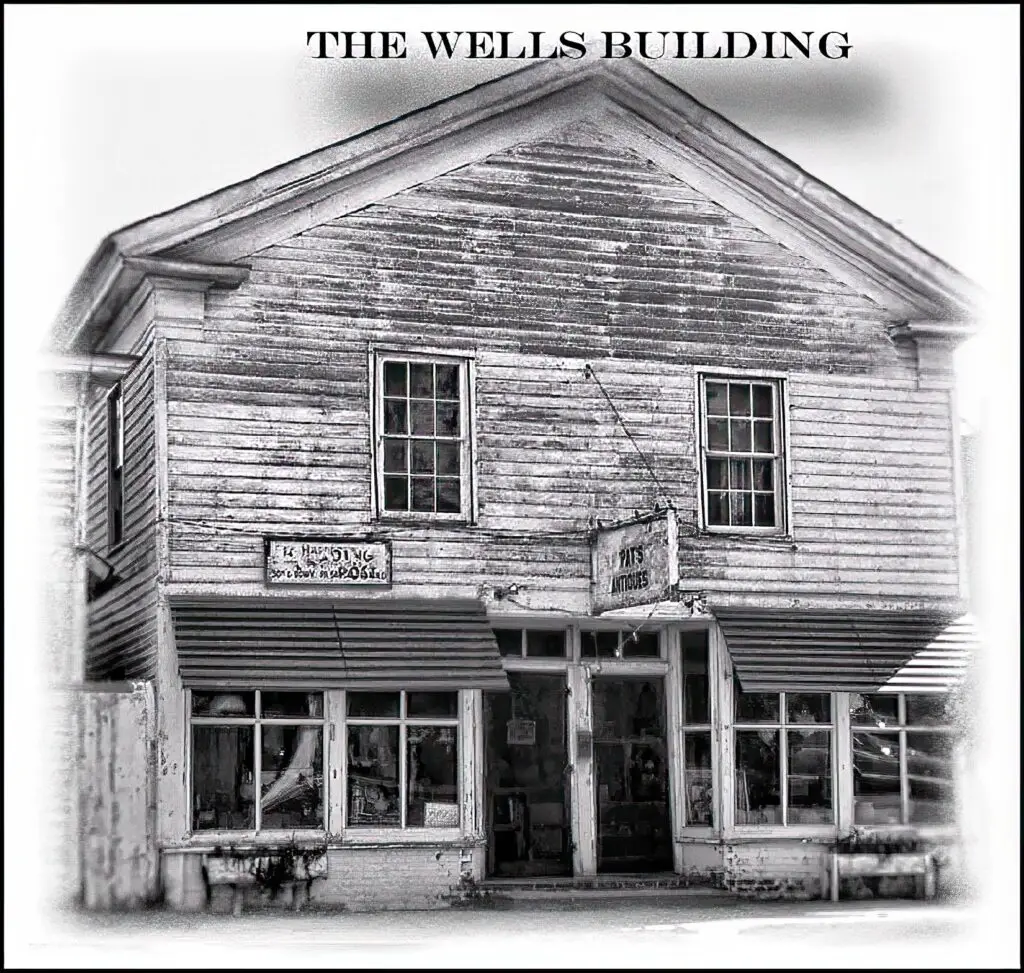
It is difficult (at least it is for me) to believe that in August of 2023 64 years have passed since the first edition of the Vermilion Photojournal appeared in our pretty city. The Vermilion News – the predominant weekly prior to the establishment of the journal – was published for only 67 years when it was put to bed. Time most certainly does fly – when you’re having fun.
Many persons who visit our local history museum where The Vermilion News was published note that newspapers, as we know them, are rapidly nearing extinction. They, as well as I, believe that newspapers play an important role in the life of our community and our nation. As the late Jerry Coleman, former Major League Baseball second baseman and former play-by-play announcer for the San Diego Padres, put it, “A Day without newspapers is like walking around without your pants on.” I’d say that’s pretty important.
The people of the community of Vermilion, Ohio have sought to keep their drawers on since about 1876 when the “Vermillion Bugle” became their primary news source. That sheet was printed by the Amherst (Ohio) Free Press. Another weekly said to have been published by a Mr. Ruggles called “The Vermillion Times” may have also helped secure the trousers of local citizens. That was between the demise of the “Bugle” in 1879 and the first publication of “The Vermillion News” in 1897. And thanks to the “News” and the “Photojournal” the metaphorical trousers of the community have remained safely hitched for over a century now without a hitch [pun intended].
The fellow who started this 126-year-old journalistic indulgence came to Vermilion from Greensprings, Ohio in 1897. His name was Robert Whitmore. He set up his press in a building known as the “Wells Building” on the east side of Grand Street just north of the railroad tracks. It was located next to (north of) the brick building currently (2023) housing the “Jail Bed and Breakfast” facility. The Wells building disappeared from the local landscape sometime in the 1960’s.
By November of 1898 Robert grew tired of the business and his father George who had been drawn to Vermilion because of the glowing recommendations of his son – took over the operation. For whatever reason George naming one H.A. Haven the publisher. “H.A. Haven” – a rather distinguished looking and sounding name – was actually George’s mother Hattie. Whether she actually participated in the day-to-day work of the paper is unknown. But no matter.
At the very beginning of the 20th century Whitmore sold the business to a newly married couple, Pearl, and Elizabeth “Bessie” Roscoe, for just a few hundred dollars. Mr. Roscoe had started his career printing at the Laning Printing company in Norwalk, later moving an Oberlin weekly, and then to the Lorain Times-Herald. At the Herald he worked as printing foreman. Bessie had taught school in a one-room school house for the Berlin-Milan education system.
Initially the newspaper was printed in a room on the 2nd floor of the Wells building. It was a simple five column 8-page sheet. Four pages consisting of state and national news were printed in Cleveland. The other four, with local news, were printed on a “Gorden Jobber” press in Vermilion. (Note: A “jobber” is a platen press that aside from the paper was used to produced items such as, stationary, handbills, etc.)
In September of 1904 the Roscoes purchased a property a few doors south of the tracks on Grand Street, and in November moved the business to a new building on that lot. The Roscoes and later their eldest daughter’s family, the Tarrant’s, kept the ink and information flowing until 1964 when the family shut the lights off and retired the presses. Fortunately, local citizens did not find themselves without any local news resource altogether. Thanks to the existence of the Photojournal Vermilionites were rescued from the prospect walking about – as the aforementioned Jerry Cole intimated – without breeches.
Well, the internet may very well be a wonderful invention / resource. But more than a few people will agree that there’s just nothing like sitting down in your favorite chair with a cup of coffee to read the local newspaper. If the power goes out, you can still read it – if only by sunlight or candlelight. (Trousers are optional.)
Ref: VPJ, 4/16/09; Rev. 09/03/23.
Vermilion resident Rich Tarrant is Curator of the Vermilion History Museum and a son and a grandson of the late proprietors of The Vermilion News (1897-1964). Readers may email him at: rnt@twc.com
© RNT September 3, 2023

.
Little Changes Can Mean a Lot
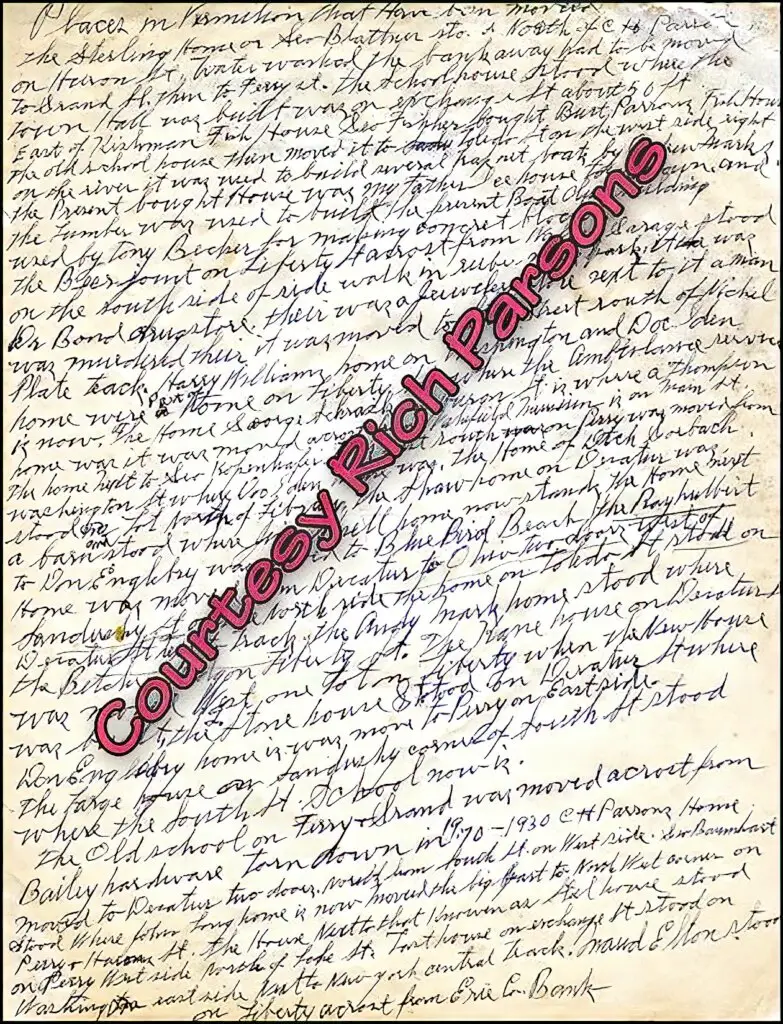
Over the years I have wished that someone in the past had had the foresight to make an accurate map of the town as it was way back when. As the saying goes, “Wish in one hand and etc.…” But sometimes we have to take what we can get. So, when at the end of June in 2008, late Vermilionite Rich Parsons visited the local history museum with a document that was apparently composed by his grandfather, Clifford, describing where things had once been, I was very pleased. It is a one-page piece, handwritten in pencil, on an unlined sheet of paper and tentatively titled, “Places in Vermilion That Have Been Moved”.
To be clear this is not an essay. It “is not” and “was not” intended to be anything more than an outline for a more formal document. It appears that Mr. Parsons simply wanted to create a document that accurately details some of the places in our town that were moved from one site to another. I tried my best to precisely transcribe the document as written (pictured). But some things still escaped me. So please excuse my errors.
Some of the relocations described are well known to longtime residents. But there are also a few surprises. So, take a close look. Bear in mind that what follows is the document essentially as I found it:
“The Sterling home or Geo. Blattner’s stood North of C. (Clifford) H. Parsons on Huron St. (until) water washed the bank away – (it) had to be moved to Grand St. then to Ferry St. [This home is on the south side of Ferry Street between Grand and Main streets.]
The school house stood where the Town Hall was built – was on Exchange St. about 50 ft. East of Kishman Fish House. Geo. Fischer bought Burt Parsons Fish House – the old school house [was] then moved to Toledo St. on the west side right on the river – it was used to build several trap net boats by Andrew Marks. The Present “bought” [sic] house was my father’s house torn down and the lumber was used to build the present Boat Club building – used by Tony Becker for making concrete blocks.
The Beer joint on Liberty St. “acrost” [sic] from Walker’s garage [currently Rudy’s Café] stood on the south side of the sidewalk in [Exchange] “rubberneck” [sic] park. It was Dr. Bond’s drug store. Their[sic] was a jewelry store next to it – a man was murdered their [sic] (in 1877) – it was moved to State Street south of Nickel Plate track.
Harry Williams home on Washington and Doc Iden (‘s) home were part of home on Liberty St. where the Ambulance service is now. [Both homes still exist on Washington Street.] The Home [of] George Schrack on Huron St. is where a Thompson home was – it was moved acrost[sic] from Wakefield Museum is[sic] on Main St. The home next to Geo. Kopenhaber’s just south on Perry was moved from Washington St. where Doc Iden home was. The Home of Dick Gorbach stood one Lot North of Library. [The Gorbach home was moved to the lake shore behind the Gilchrist house] The Shaw home on Decatur was a barn and stood where Jim Snell home now stands. [The “Shaw Home” is on the west side of Decatur Street next to the railroad tracks. Jim Snell’s home is on Decatur Street behind the old Pelton home on Liberty.] The Home next to Don Englebry was moved to Bluebird Beach – the Roy Hurlbut home was moved from Decatur to Ohio two doors west of Sandusky St. on the north side – the home on Toledo St. stood on Decatur St. next to track – the Andy Marks home stood where the Bettcher Bldg. on Liberty St. [The “Bettcher Bldg.” is next / west of Rudy’s Café.]
The Kane house on Decatur was moved West one lot on Liberty when the New House was built – the Stone house stood on Decatur St. – where Don Englebry home is, was moved to Perry on East side. [This home is gone.] The Large house on Sandusky corner of South St. stood were the South St. School now is. [This is the big yellow house on the northwest corner of South and Sandusky streets.]
The Old school on Ferry & Grand was moved acrost[sic] from Bailey hardware – Torn down in 1970 [This was the “Wells” building on the east side of Grand street in the area north / next to the Jail Bed and Breakfast.] – 1930 C.H. Parsons Home moved to Decatur two doors North from South St. on West side. Geo. Baumhart [home] Stood where John Long home is now – moved the big part (?) to North West corner on Perry & Huron St. – the house Next to that known as Stal [sic] house stood on Perry West side north of Lake St. Last house on exchange St. stood on Washington east side next to New York central track. Maud Elton [currently on the northwest corner of Liberty and Exchange streets] stood on Liberty acrost[sic] from Erie Co. Bank.”
Again, I apologize to readers for the difficult nature of my transcription. However, it certainly emphasizes the importance of learning and interpreting cursive writing. While some comments were added in brackets to hopefully clarify things, they’re not really “big” changes. But then again, some little changes can mean a lot.
Vermilion resident Rich Tarrant is Curator of the Vermilion History Museum and a son and a grandson of the late proprietors of The Vermilion News (1897-1964). Readers may email him at: rnt@twc.com
© RNT August 27, 2023

WHEN OLD SAILORS RETURN TO VERMILION
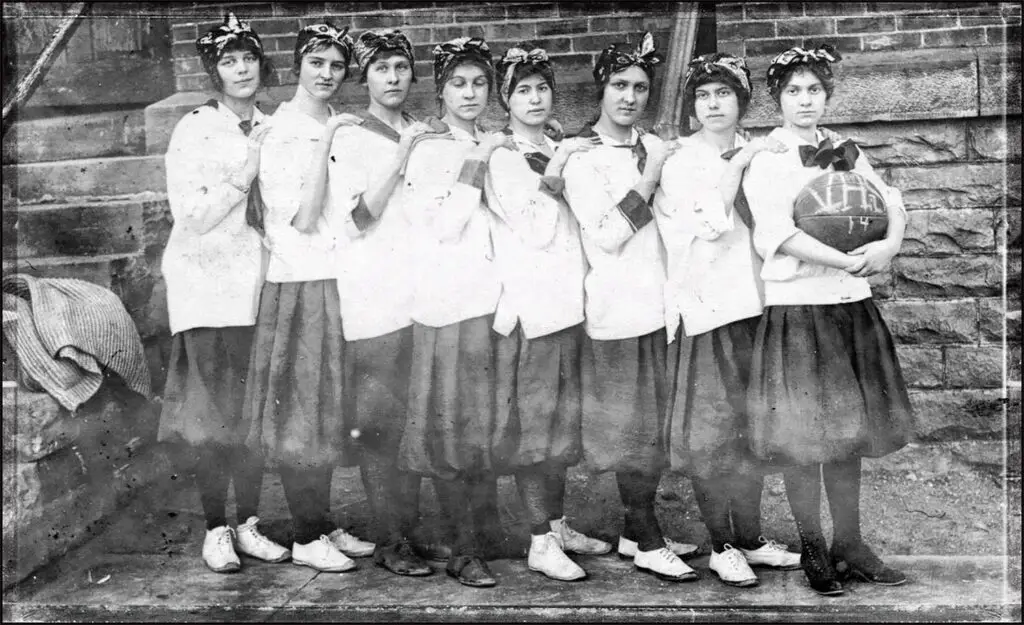
Swallows come back to Capistrano in the spring and in the summer old Sailors return to Vermilion. (VHS Sailors that is.). In July the VHS Class of 1959 held their 64th reunion in town and last week the VHS Class if 1973 celebrated their 50th. Some of these kids (because, like it or not, that’s what they really are – at least for a few days) visit the Vermilion History Museum. Almost all leave something of themselves in the way of memories of their yesteryears here before they return to their homes. And some, like Bill Hlavin (’59), Janet Reifert-Van Vleck (’59), and Jim Wall (’73)…ad infinitum contribute even more.
Hlavin and Wall have been collecting Vermilion artifacts for decades. At times they were even at odds (no pun intended) because both vied for the same object. In any case, over the years both men amassed wonderful collections of photographs, postcards, letters, and sundry other items related to their old home town. Now, many of these items have been contributed to the Vermilion Museum. The photograph that accompanies this week’s essay is an example of one of those things.
The museum has many photographs similar to the one shown because from 1919 to WW2 the Vermilion News print shop printed the VHS Annual / Yearbook, originally called the “Hi-Times”, for the local school. This particular picture, however, predates the museum’s collection. While that’s significant it’s not the only reason that it’s an important acquisition.
One of the most annoying things about the old annuals – at least from a historian’s point-of-view – is that in the case of similar group photographs few to none of the persons pictured are named. I account for this exasperating oversight by bearing in mind that Vermilion in those years was not a “big” town. Consequently, everybody knew everybody, so providing names to every face pictured wasn’t deemed necessary. The editor(s) of these books apparently never dreamed that a century later people might want to know “who is who”.
That which makes this particular artifact more significant than most like it is the fact that some soul with great foresight added most of the names of the girls on the back of it. [I have added married names.] The members of the VHS basketball team of 1914 are L-R: Marion Krapp-Murray, Unknown, Alta Leidheiser-Baumhart, Mary Baumhart-Emmerich, Mary Parsons-Wakefield, Gladys Risden, Hazel Dike-Nuhn, and Emily Dean-Lawrence.
The girls were photographed just outside the State Street School. Their uniforms are quite interesting. The sailor blouses and bloomers were actually common female basketball team uniforms in 1914. But the matching hair pieces – head scarves are unique to this team. The shoes seem to vary a bit.
By the way, those who wonder about playing ball in those uniforms need understand that basketball in 1914 is unlike the game played today. There were 13 rules – such as, “a player cannot run with the ball, the player must throw it from the spot on which he catches it, allowance to be made for a man who catches the ball when running at good speed. The ball must be held in or between the hands, the arms or body must not be used for holding it”, etc. These rules certainly slowed the game and made for very low scoring. But whatever the rules, and whatever one had to wear in those days, it was apparently still fun.
I was surprised to also discover in this case that I actually knew one of the girls; Gladys Risden. I recall that Miss Risden was thought to be the consummate school teacher who, after retiring, worked as an excellent tutor of children in need of tutling. For several years she also kept a rooming house on West Ohio Street between Perry and Decatur streets. That home caught fire in the 1960s taking the life of one man and critically burning my uncle. She later lived in a smaller home on Exchange Street just behind the former Fire Hall. She was a well-known and a highly respected educator and Vermilionite.
Anyway, if anyone ever wonders how or where our local museum acquires much its knowledge and artifacts, wonder no more. It comes from thee. And like the accompanying photo, it also comes from “Old Sailors” when they return to Vermilion each summer.
Vermilion resident Rich Tarrant is Curator of the Vermilion History Museum and a son and a grandson of the late proprietors of The Vermilion News (1897-1964). Readers may email him at: rnt@twc.com
© RICH TARRANT – August 20, 2023

THAT'S ENTERTAINMENT
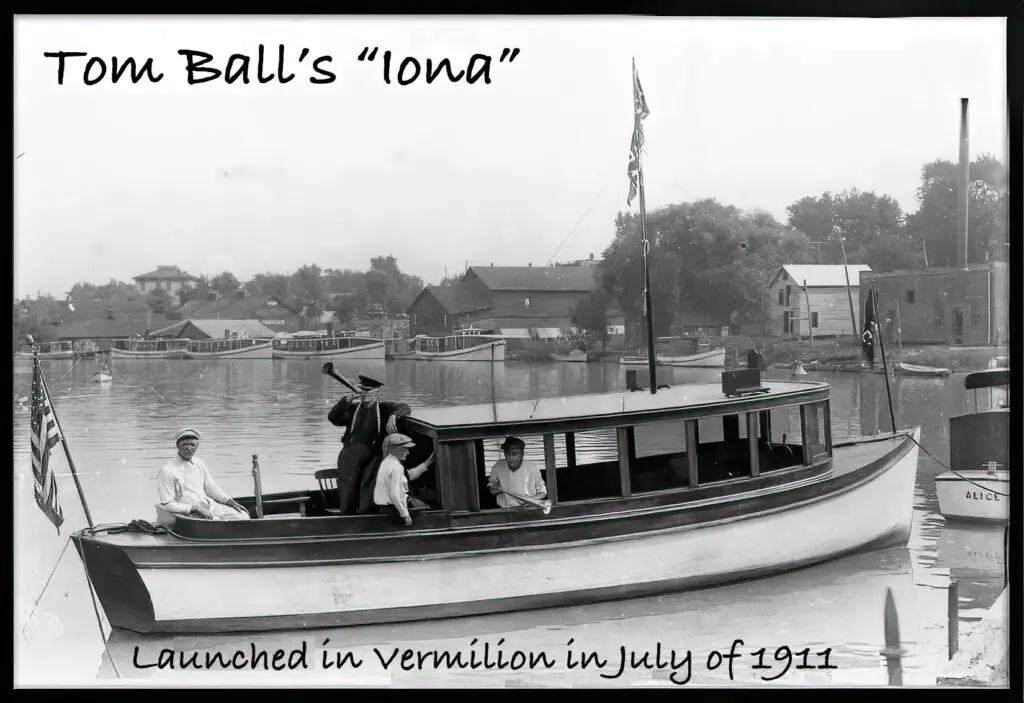
A hundred years from now people will (hopefully) be able to look back at our lives as they appeared in some aged yellow pages of the VPJ and get a laugh or two out of our behaviors. Or if they don’t get a laugh at least be as positively entertained with our failings and achievements as we are with those of our forebears. What follows are sampling of events that took place in our area during the summer of 1911.
The Vermilion News, Thursday, July 13, 1911 – “WARNING: It has been reported to us that a number of adults are acquiring the habit of running around our streets in near-to-nature garb. Common decency demands that those wishing to bathe should provide themselves with some wrap covering such as a rain coat while on their way to and from the lake beach. It is also reported that if this practice is not stopped other means than mere warnings will be used.” [Imagine how things would’ve played out “if” cell phones existed back then.]
“Broke Grade Record: Thomas H. Bottomley, member of the class of 1907 of V.H S. passed the recent state examination in pharmacy with an average grade of 97½%, the highest yet attained in the state. The previous highest grade reached is 95.” [The VHS Class of 1907, of only seven students, was the very first to complete a full 4-year curriculum. Four of these students became teachers, one became a commercial fisherman, and Bottomley became a pharmacist. Another student, Ralph Gegenheimer, died in 1909. Bottomley, by the way, also earned a law degree while working as a pharmacist in Cleveland.]
“In Amherst: Rev. Charles F. English and his son Leland, of Amherst, were discharged from custody by Justice Neiding, Thursday afternoon, there not being sufficient evidence produced at their hearing to warrant the court binding them over to the grand jury on a charge of assaulting Dr. George Quigley, with intent to kill. Rev. English who is an evangelist, admitted that he slapped Quigley, his brother-in-law, in the face, but that he was justified in his action as a result of the epithets applied to him by Quigley. It also developed that Leland English did beat the doctor with a baseball bat, but it was when he feared Quigley would kill his father whom he had down on the ground beating him with his fists.” [This is among the oddest pieces I’ve seen in the old paper. What happened to “turn the other cheek?’]
“No More Woman Calligrapher’s for Ohio: I.N. Miller, Cincinnati, district commercial superintendent of the Western Union Telegraph Co., has sent out a notice which means that there will be no more women telegraph operators employed in Ohio. They will be replaced as fast as possible on account of the passage of the Green nine-hour law for women.” [The “Green Nine-Hour Law” provided that no woman over 18 years of age should work for more than 10 hours in any one day or for 54 hours in any one week.]
“A Good Show: The people are promised a good show for Thursday, Friday, and Saturday evening this week at the Opera House. The Great Haines, dramatic soprano and Benedict, the Man of Mystery also the Human Fish, Guy M. Dailey, will appear as the attractions.” [The “Human Fish”? I’m sorry I missed that one. And, by the way, Benedict was a Mind Reader. I guess it was freak show night in Vermilion.]
“Junk Thieves Caught: Two men were caught and jailed Friday for stealing lead and brass from L. S. & M. S. Ry. Several hundred pounds of lead was recovered. When Marshal Gross went to the jail to take them to dinner, he found the doors open and the “birds” flown. The thieves had taken an iron bar from a bunk and by diligent work succeeded in prying the lock off the cell door. It was then easy enough to get out of the building. There was no evidence of outside assistance as was at first reported. It was fortunate for them that they escaped as they did for a L. S. & M. S. Detective came to town shortly afterward. Care will be taken hereafter that the locks are more securely placed. [The jail at the time was at the back of the Town Hall. Perhaps the “Human Fish” helped them give the Marshal the slip.]
One Issue Later – Thursday, July 20, 1911: “The fine new launch built by T.J. Ball was launched in the presence of a small crowd and made a trial trip on the lake. She was christened Iona and is one of the finest gasoline launches ever built. Mr. Ball has orders for two more boats which will be started at once.” [Tom Ball’s “Iona” (pictured) built in a shanty just below the west breakwall would eventually become one of the town’s most recognizable pleasure boats on the Vermilion River,]
Now that’s Entertainment.
©RNT August 13, 2023

It Happened One Spring
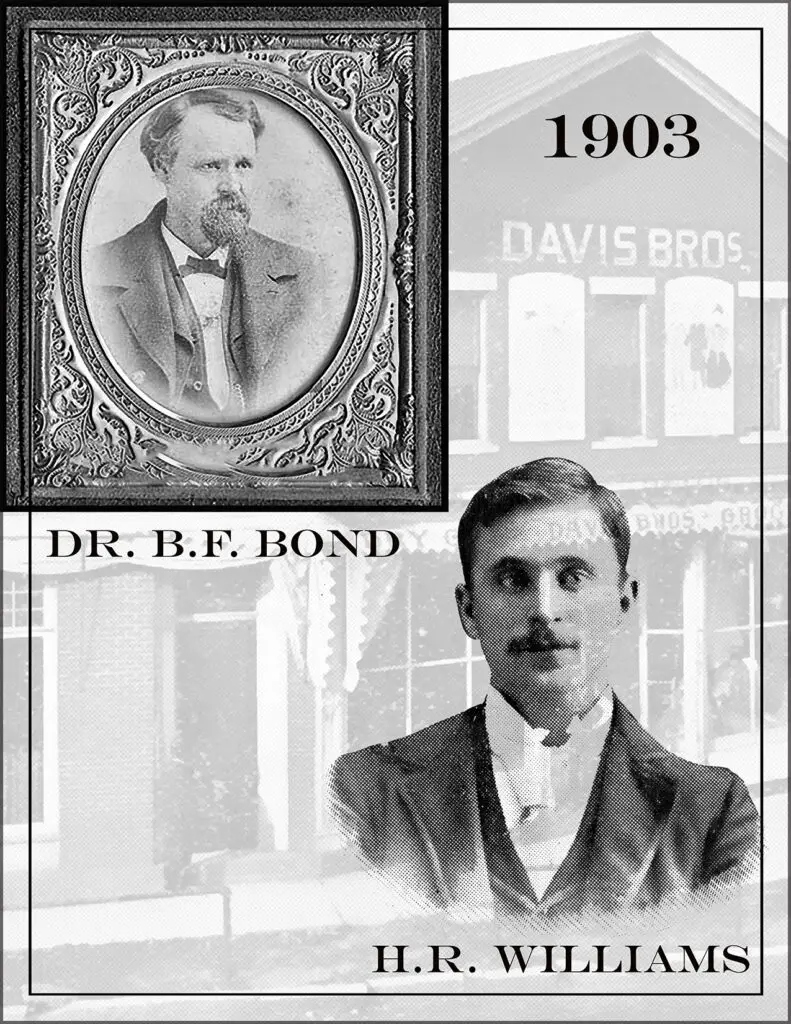
It was in late May of 1903. Linwood Park was about to open for the summer. Trot-line fishermen had been bringing in some good catches. Work on construction of the new stove factory on the west side of town was moving along. The Twentieth Century Limited made a record run between Cleveland and Toledo passing through town in a blur. A.D. Baumhart was busy moving his drug store / insurance office on Division [now Main] street four doors north of Englebry’s Dry Goods Store [now Brummer’s Candy store]. The first picnic of the season was about to be held at Shadduck’s Grove [a.k.a. Crystal Beach amusement park] the coming Saturday. Local farmers had received just enough rain for their crops during the week. The Vermilion High School commencement was set for June 5th at the Township Hall Opera House. So, all in all, it looked like it was going to be another pleasant and busy summer season in the little village of Vermilion, O. when a young man named Orville Brooks came home feeling a bit under the weather. The poor guy was running a fever; had a slight rash; and less than 24 hours later the whole town was on the brink of panic. Orville was found to be suffering with smallpox.
To digress momentarily, it might be helpful to understand that smallpox is a potentially fatal contagion that emerged in human populations thousands of years ago. Human beings are its only known natural hosts. It is generally spread by direct, prolonged face-to-face contact with an infected individual and / or direct contact with infected bodily fluids or objects contaminated by sufferers. The name is derived from the Latin word for “spotted” referring to the raised bumps that eventually appear on the face and body of the infected person. Thank heaven, and modern medicine, it has now been eradicated from our planet. The last known case is said to have been in Somalia in 1977.
Now back to Vermilion in May and June of 1903. The homes of Brooks’s parents and grandparents were immediately quarantined and guarded. School was dismissed and the building fumigated. By June 4th Commencement proceedings, church services, and all public gatherings were cancelled until further notice. As more persons came down with the disease a “Pest House”, a clinic for treating persons with contagious diseases, was set up along West River Road. Mention of this “Pest House” and smallpox epidemic was made in a 1960s tape recorded interview made by Vermilionite Betty Reffner with aged Vermilionite, Harvey Krapp. In that recording Mr. Krapp indicated that the clinic was located somewhere on the property where the F.W. Wakefield Brass Lighting Company was later built. Currently (2023) it is the site of the Cleveland Stone Company.
In the days that followed every house in the village was fumigated with formaldehyde that was being freely used for that purpose. Inoculations for the virus were started immediately; and by June 5th Vermilion Mayor H.R. Williams reported that there were only five persons left in the town who had not been vaccinated. Here it is interesting to observe that Vermilion’s veteran Dr. Bond, who was tasked with treating some of the infected persons, refused to be vaccinated. He, consequently, did suffer with a mild attack of the disease, but fortunately did recover.
By mid-July the siege of smallpox had come to an end. City leaders, responding to the immediate needs of residents, had had to borrow $1500 (about $50,000 today) to address those needs. Nonetheless there were still four casualties: Orville Brooks; his sister Mabel; their uncle William; and a three-year-old boy named Myron Krapp (Harvey’s baby brother). But five others; Ada and Ethel Brooks (Orville’s sisters), Mrs. Guy Davis, Ozzie Shaffer, and Henry Ries survived the ordeal. But whatever the cost had been to stem the spread of the virus, it had been well worth it.
On August 1st a celebration was held at Shadduck’s Grove and Linwood Park. Everything was free. Two bands, one from North Amherst, and one from Norwalk, entertained town folks. And, in the true spirit of America, a baseball game was played. Who won that game in that yesteryear really didn’t matter. What mattered was that “the end of the scourge” in Vermilion had come, and the people were happy once again.
Ref: The Vermilion News, May to August 1903; Sandusky Evening Star, 6/05/, 6/20/; 7/18/1903; U.S. Census, 1870 and 1900; VPJ; 06/16/2011; Rev. 08/05/23.
© RNTAugust 5, 2023

The Life and Death of the American Eagle
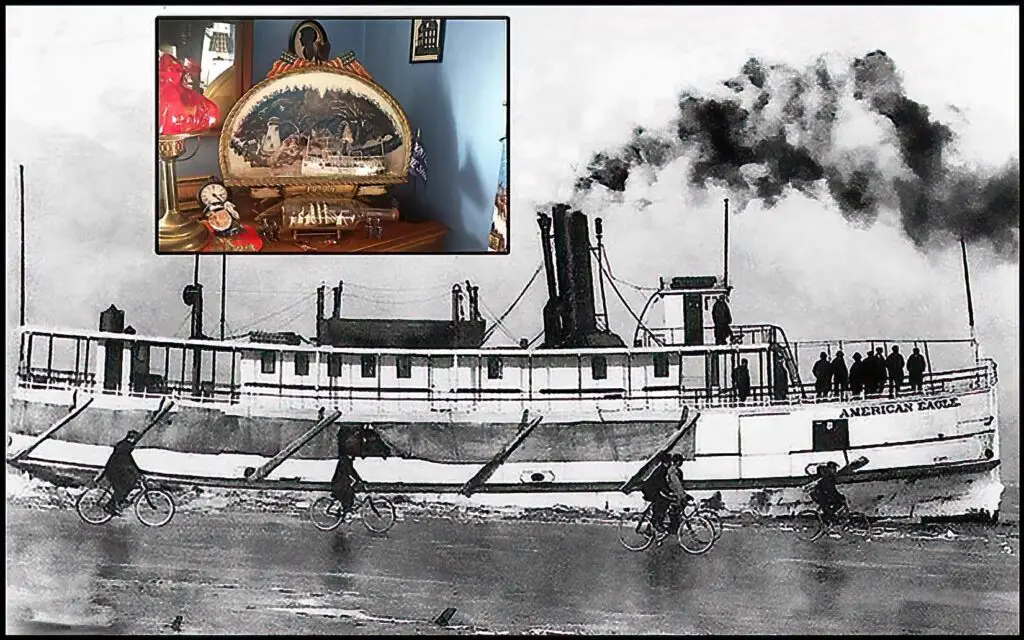
After a story about the “Eagle” appeared on these pages in January of 2017 a Vermilionite named Rick Van Den Bossche phoned me and told me that he had a great-uncle who worked as a boiler man on this vessel. It was, of course, after a boiler explosion (explained below) – but nonetheless it was a surprise. Normally I don’t write too much about things outside local history. But in this particular case I found the story about the lake steamer American Eagle so compelling I thought to pass it on. Anyway, one of the other things Rick told me was that his family has a diorama of the vessel. He also provided a snapshot of it (inset).
Initially, Birmingham resident / Interurban historian, Dennis Lamont sent me the larger photo of the tourist steam vessel / icebreaker with the racing bicyclists. It’s really an interesting image and it, of course, attracted my attention. Looking about I discovered that the Eagle was a rather well-known lake vessel with a very storied and intriguing past.
In the year 1880 a “gent” named John Monk built the American Eagle for Middle Bass winery owners Wehrle and Work in Sandusky, Ohio. The vessel was sheathed with iron capable of breaking at least 8 inches of ice, and breaking ice she did. In fact, she was capable of busting through 2 feet of frozen lake ice.
In the spring of 1882, she left Sandusky with three other boats at 3 o’clock in the afternoon transporting a group of sport fishermen to Pelee Island. During the journey she entered into a race with the steamer “Jay Cooke.” Forty minutes later – somewhere between Cedar Point and Carpenter’s Point on Kelley’s Island, “Eagle’s” boiler exploded.
The engineer, J.W. Johnson, was terribly scalded. Frank Bittel, fireman and Frank Walter, deck hand, were killed instantly. John Lutes. Mrs. Lutes, Miss Lutes, of Middle Bass; J.W. Gilbert, Wm. Dilger, James Fulton, Charles Kramer, B. Carstensen, Lorenz Neilson, were also badly scalded. Two of the group were expected to die.
Before engineer Johnson died, he was heard to say that he was carrying 110 pounds of steam. (They were allowed only 106.) Though he initially denied being involved in a race, he later admitted that five minutes before the explosion Eagle’s Captain Magle had told him to, “…stop and let the COOKE go by, and then go on.” Johnson responded by saying, “Well I’ll check her down in a few minutes.” That was, of course, too late. Following the explosion, the tug “Mystic” towed the disabled craft back to Sandusky, where her boiler was later rebuilt.
In 1884, during an excursion run from Lakeside to Put-in-Bay, she struck a reef about 1 1/2 miles west of Kelley’s Island. That shoal, by the way, still carries the vessel’s name. And after being repaired at a Detroit dry dock, she was chartered by T. F. Newman for the “fruit run” from the Lake Erie islands to Toledo and Cleveland. Throughout the 1880s the “Eagle” transported tons of peaches across the lake. During the summer months, she continued to run excursions. Then in June of 1891 she collided with the tug “Alvah” 2 miles off Cleveland and sank. Fortunately, the entire crew was saved. She was later refloated and rebuilt.
During the winter of 1892, sixty people were skating on the Sandusky Bay when the ice broke loose and began drifting out into Lake Erie. Captain Fred Magle and the “Eagle” came “to the rescue. The “Eagle” succeeded in getting alongside the ice field and then put a line on the field and towed them back to the Bay while the skaters continued to skate all the way home. (My-o-my, what a sight that must have been.)
Alas, in 1907 she burned in Toledo, Ohio off Riverside Drive. In 1910 she was to be rebuilt at Wallaceburg, Ontario to be used as a Canadian tug or passenger vessel. But the work was never finished. Finally, in 1944 she was broke up at Wallaceburg. And that, in a nutshell, is the story of the steamer known as the American Eagle on Lake Erie.
Vermilion resident Rich Tarrant is Curator of the Vermilion History Museum and a son and a grandson of the late proprietors of The Vermilion News (187-1964). Readers may email him at: rnt@twc.com
© RNT July 23, 2023

WHEN VERMILION BECAME VERMILION
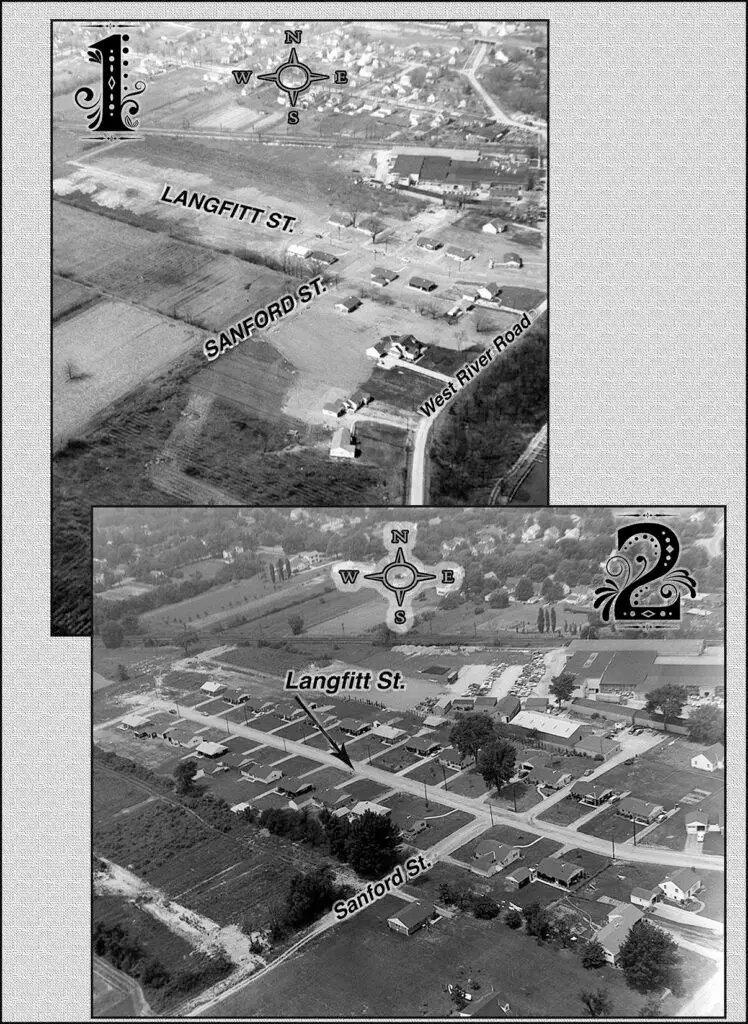
In the years immediately following World War II many persons thought that the sharp decline of military expenditures the nation would return to the dark times they experienced during the Great Depression. But they were mistaken. Americans were anxious to move on with their lives and what followed was exceptionally strong economic growth.
The automobile industry, for instance, easily returned to the manufacture of reasonably priced vehicles and newer industries in aviation and electronics exploded. America’s gross national product rose from about $200,000 million in 1940 to $300,000 million in 1950 and to more than $500,000 million by 1960. At the same time, the jump in post-war births, known as the “baby boom” invariably led to the increase of consumers. And just like that, more and more Americans joined the middle class. Military personnel returning home from the war found easily affordable mortgages readily available and did not hesitate to take advantage.
In Vermilion the post war housing boom had begun somewhat slowly. It began on the fringes of what was then “Vermilion proper” in homes that had traditionally been considered to be vacation, or summer, residences. These were rather utilitarian cottages located in areas with fanciful names like Elberta Beach, Vermilion-on-the-Lake, Sunnyside, Nokomis, Bluebird Beach, and Orchard Beach. Suddenly, but with great purpose, these summer homes were converted into year-round homes.
By the late 1940s when it became clear that a demand for more homes – new homes – in Vermilion existed a number of local persons such as Linn Creel, “Bud” Burkhardt, Sam Langfitt and Jim Sanford responding to this need acquired a tract of land just south of what was then the F.W. Wakefield Lighting plant. And Vermilion’s housing boom began in earnest. [Photo 1.]
These homes were known as Gunnison Homes. This firm manufactured thousands of prefabricated homes and sold them through dealers across the nation. They could be purchased for $2,800 to $5,000, depending on which options were chosen. The homes were built as panelized homes and were screwed together on-site, usually on a slab. Foster Gunnison, the owner, publicly acknowledged his dream of becoming “the Henry Ford of housing”, utilizing mass-production techniques in his factory to create his patented stressed-skin panels that when put together would create a home with a very short amount of time-on-site.
Within perhaps a span of four years these new homes sprang up along Langfitt and Sanford Streets. And just as fast as they went up, they were purchased and occupied. [Photo 2.] Vermilion old timers, scoffed at the quality of the homes nicknaming the subdivision “Plywood Plaza”. The connotation was that the homes would not stand the test of time. But that judgement not only proved to be both premature, but it was also wrong.
Some of the names of families that once lived in the homes along Langfitt and Sanford Streets were and remain well-known in Vermilion: Martinek, Bricker, Cutcher Langfitt, Hallet, Diehl, Maiden, Davis, Lane, Sanford, Wendell and Moeller. And this was just the beginning.
By the early 1960s at least two more streets, Devon and Sweetbriar Drives, with more homes had been added to the development. And then the Ford Motor Company entered the scene and that which had been a post-war housing boom turned into an explosion. The Valley View subdivision eclipsed all and every former housing development in the history of the town. And Vermilion ceased being the Vermilion of a yesteryear and became VERMILION.
Ref: Special Thanks: to the Creel Family and Greg Trocchia.
© RNT July 16, 2023

PRETTY MAIDS ON A ROCK
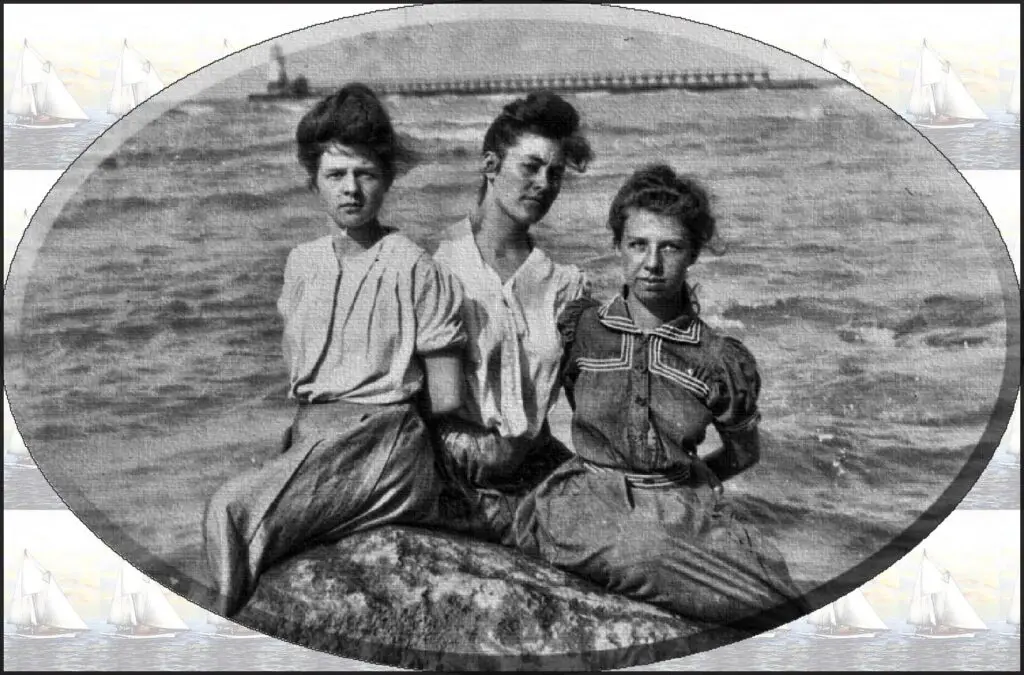
This is a photograph that could stand alone; no further interpretation required. It is simply a nice picture of three pretty ladies sitting on a rock (c.1910). At least that is what I was content to believe for most of the six or seven years after I first saw it in my grandfather’s photo collection.
He, Pearl Roscoe, took a lot of pictures. And although he was a newspaper editor/ publisher many were never published. Consequently, the girls were not to my knowledge identified anywhere. That’s not an unusual happenstance among photographers – professional or amateur. But, historically speaking (for myself), it certainly is annoying.
Several years ago, I chose to use this picture for practice using some digital photograph enhancement software on my computer. Other than my wanting to use a black and white / gray scale photo, and that it should have at least one person in it, my choice was purely arbitrary. The intent was to begin to develop some skill in the colorization of gray scale photographs.
I so impressed myself with my initial work (which is not, incidentally, hard for me to do) that I decided to show it on one of my webpages so that others might admire my finesse as a digital photo finisher. And, while I must admit with some chagrin that that was not to be – something else – something a great deal more pleasing happened. It came from persons in Pennsylvania, Virginia, Florida, and Illinois. The ladies were identified.
The pretty ladies on the rock are (L-R): Alice A. Parsons Baldridge, Grace B. Parsons Ming, and Clara Wakefield Hofrichter.
Alice and Grace Parsons were sisters. To put some of this into context their father was Burdette Nelson Parsons and their older brother’s name was Cliff. Clifford would be Vermilionite Don Parsons g-grandfather. Clara, of course, would be a daughter of the late Vermilion businessman and inventor F.W. Wakefield. Alice was the late Vermilion historian George Wakefield’s mother-in-law.
Now all of that is nice to know but there is one other little thing. It has to do with the rock upon which the girls are seated. It’s not just any old rock. ‘Tis a rock that legions of youngsters who grew up in Vermilion, Ohio are quite familiar. The rock is so famous among current and former members of the community who have spent time in the waters just off “Wakefield’s Main Street Beach” that it has a name. It is the “Table Rock”.
As my late friend, John Paul “Stu’” White, once observed: “I’m not sure why we called it Table Rock since it was a little tricky to stand on because it was slanted some and usually underwater. Because of this we devised some rudimental sort of triangulation method of finding it. One of the objects was a double ended brick cooking grill on the shore. I think we also aligned a certain electric pole on the west pier with a big picture window in a house on the east side of the river.” But back to the photo.
How I initially missed perceiving that the rock on which the girls were seated was, indeed, the “Table Rock” until my friend Stu mentioned it to me surprised me. [NOTE: The photograph is somewhat deceptive making it appear that the stone is nearer the shore than it is.] It was, after all, the very reason, I taught myself to swim as a lad. I suppose I had forgotten because it’s been (mostly) underwater for years, and also because I’d not frequented those waters for some time. But no matter. Due to my interest in learning how to use the technology of our times I inadvertently “rediscovered” the rock, and as a bonus, the identities of the pretty ladies who on it posed for their portrait in a yesteryear.
Ref: U.S. Census; 1900; Vermilion Historical Society archives; Special Thanks to the Stu White Family, Molly Wakefield Milner, Mary Wakefield Buxton, and Fred Wakefield; VPJ 5/22./06; Revised 07/09/23.
Vermilion resident Rich Tarrant is Curator of the Vermilion History Museum and a son and a grandson of the late proprietors of The Vermilion News (1897-1964). Readers may email him at: rnt@twc.com
© RNT July 9, 2023

Fun & Foolishness

Just for the heck of it I began reading through the pages of the old Vermilion weekly – The News – that were published during the 1930s. I was interested in gaining some insights into life in our community during the era known as The Great Depression as well as the latter years of Prohibition. And though I certainly did acquire insights into those specific things, they were not what I expected. I actually came away with much more.
First of all, this did not appear to be (at least in our town) an especially gloomy time. People seem to have been able to adjust to the conditions of the era calmly and wisely. In fact, those weekly editions were probably “the best” in the newspaper’s entire history. The stories made terrific reading then – and still do.
Among all that reading material I found a weekly column called “Heresay and Heresy” by Jove. The column consisted of a number of items that could range from teacher qualifications to Prohibition to personal stories of Vermilion history, etc. Sometimes Jove’s comments would earn the ire of the local citizenry. So, the title of the column seems to have been quite appropriate.
But setting that aside, one of the stories that caught my attention appears in the February 9, 1933, edition. The name of the person who told the story was not provided. But that’s not really important. And though the following account is not verbatim it is essentially what he told Jove:
“Before Crystal Beach there was a picnic and outing park at that same place called Shadduck’s Grove. When Shadduck’s Grove was there excursion trains would stop at the East River Road (now Vermilion Road) crossing where park patrons loaded and unloaded. At times I have seen as many as five trains waiting at the end of the day to take folks home.
Anyway, when the trains loaded up at night to take passengers home a number of us town boys would jump on at the last minute and see just how far we could ride before jumping off. Sometimes we would be able to hang on until we reached the bridge at Highbridge Road (above the tracks that lead east to Amherst). But when we jumped off and landed – Zowie! – it was all heads, feet, and dirt.
It should go without saying that it was dangerous sport. But as much as our parents warned us about the dangers of the game, we boys promptly ignored them. As a result, council passed a local ordinance prohibiting the jumping on railroad trains. And, again, we boys promptly ignored it too.
One day the local station agent who knew all us boys took down our names and handed the list to the town marshal. The marshal didn’t immediately search the town for us. He didn’t have to. All he had to do was wait. And one day he found all of us together playing a game of “Cat and Dog”. And into jail we went one and all.
The jail was located in a shed where the Kishman Fish coal shed was later located. But being in jail was “just a lark” to us. We still had our sticks, so we proceeded to continue our game of “Cat and Dog” in the lockup. Soon after we were taken before the Mayor, C.C. Baumhart, and fine $1.00. But even that didn’t stop us boys from jumping on the trains. But one day a leg did [meaning someone lost a leg] – and our sport ended.”
While the story is by itself a good one there are several things in it that some persons might be interested in learning more about, such as when this incident occurred, the game of “Dog and Cat” and the site of the jail.
First: Mayor C.C. Baumhart served the village between 1894 and 1895. Second: The “Dog and Cat” game (or “Cat and Dog”), was a game that likely originated in Scotland. In it a small piece of wood called a cat is thrown at a hole in the ground while another player defends the hole with a stick (a dog). In some cases, there were two holes and, after hitting the cat, the batter would run between them while fielders would try to put the runner out by putting the ball in the hole before the runner got to it. The game resembled cricket. [Note: I’ve no idea how they might have played the game in a shed.] And last of all: The jail would have been located somewhere in the area we now know as Exchange Park. The lockup is mentioned in one of the stories written by late Vermilion historian George Wakefield in his book “Lure of the Lakes”.
Jove’s intent was obviously to emphasize the fact that there’s often a fine line between fun and foolishness. And that remains a truth for all of us – both today and in the yesteryear.
Vermilion resident Rich Tarrant is Curator of the Vermilion History Museum and a son and a grandson of the late proprietors of The Vermilion News (1897-1964). Readers may email him at: rnt@twc.com
© RNT July 2, 2023

Add Your Heading Text Here
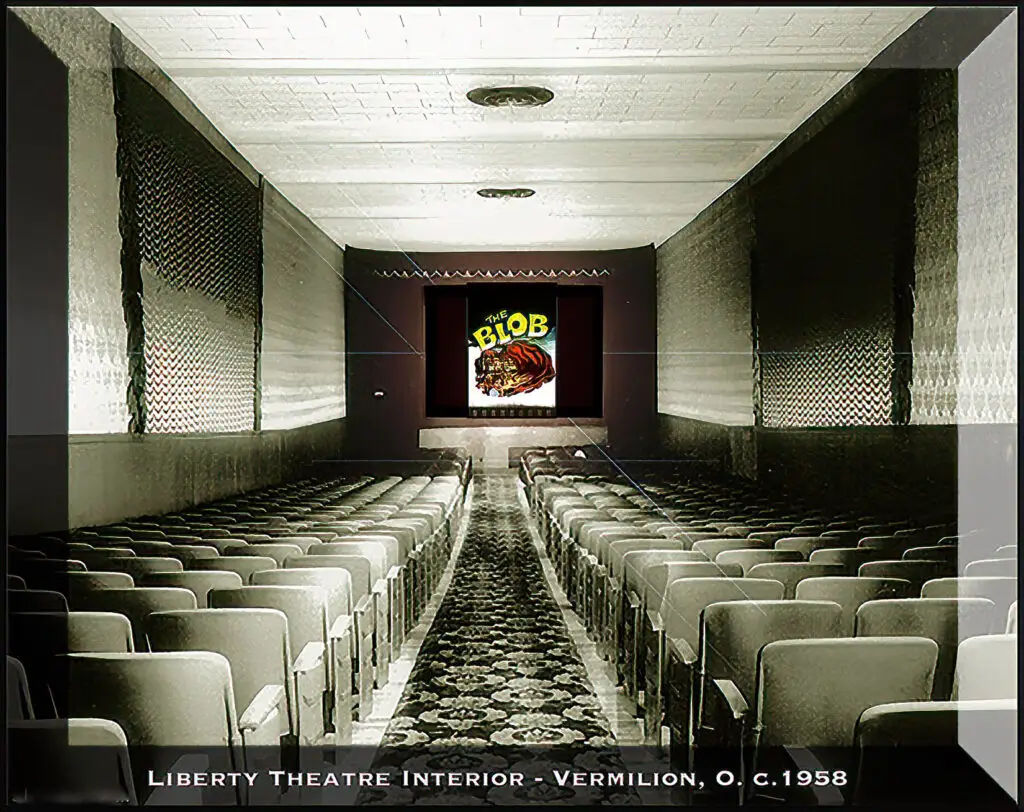
Coming of age in the mid-1950s was a time when there wasn’t a whole bunch of stuff for Vermilion teenagers to do on Friday nights if there weren’t any events taking place at school. Consequently, many youngsters, me included, turned to the local picture show [most folks refer to them now a cinema or movie] at the Liberty Theatre for entertainment. The Liberty for “Newvies” (new Vermilion residents) was located where the art gallery called “Art Seen” is situated today on the south side of Liberty Avenue just a hop, skip and jump east of Grand Street right next to the new parking area (2023).
The building housing the theatre had, in the 19th century, been a haberdashery. First operated by Civil War veteran, Captain Henry Delker. After his death in 1890 another local guy named Lewis Englebry took over the business. Sometime after Englebry’s death in 1920 the building was transformed into a rather nice movie theatre. But I digress.
As one might guess I had been going to this picture show since I was about five years old. In those years my big brother “Albie” took me there on Sunday afternoons. My mother would give me a quarter. Admission was a dime. Another dime provided a box of popcorn. And the nickel bought a box of Jujyfruits or Good & Plenty candy. But by the mid-50s the price of admission, ever subject to inflation, had increased to 50 cents and popcorn was a quarter. Fortunately, the wages earned from my paper route easily covered these expenses, with enough left-over for a burger and a coke at the Goody-Goody Soda Bar next door after the show.
Unlike big city theaters the Liberty was only open on weekends in those days. So, on the days in between one had to be satisfied with various radio shows and some, very lackluster, black-and-white television programs that ended each broadcasting day at midnight by playing the National Anthem followed by a “test-pattern”. [FYI: Early TV test patterns were actually physical cards at which a television camera was pointed when no programs were being broadcast.] Thus, Friday night at the movies when I was in my early teens was, to say the very least, something I along with many other Vermilion kids eagerly anticipated all week long.
Before every movie there was always music playing in the theatre. Some songs I remember to this day. There was always a piece called Feudin’ and Fightin’. One line went: “Grandma, poor ol grandma / Why’d they have to shoot poor ol’ grandma / She lies ‘neath the clover / Someone caught her bending over / Picking up a daisy.” And then the curtains opened, and the magic began.
It always started with a cartoon. One of my favorites was Mr. Magoo. But then there was Sylvester, Tweety Bird, Bugs and of course Porky and many more. On some occasions there was a “short” comedy series starring a character called Joe McDoakes (who tried, but never quite succeeded at anything). There were the Three Stooges, and now and then there were the “Our Gang” films with Spanky, Alfalfa, Darlene, and their dog Petey. And then – after all that came the prime attractions. The ones we had waited for all week.
My friends and I witnessed film history on the big screen at the Liberty watching the greats like Marilyn Monroe, Humphry Bogart, Doris Day, Dean Martin and Jerry Lewis, Jimmy Stewart, Kirk Douglas, Marlon Brando, James Dean, Cary Grant, James Mason, John Wayne. ad infinitum. We saw great films like Bridge Over the River Kwai, Rebel Without a Cause, High Noon, War of the Worlds, and the list goes on. It was wonderful. But the best ones in the eyes of a teenager were the horror films. Things that would never get close to winning an Academy Award.
There was “The Creature from the Black Lagoon” series that caught our interest partly because we had our own lagoons right here in Vermilion. [Who knew what might happen?] Among them was also the “Invasion of the Body Snatchers”, “The Thing”, “Them (i.e., Terror, Horror, Excitement, Mystery)”, and the first make of “War of the Worlds”. Many of these particular films were low budget movies and because of that were usually black and white films. But one produced in color that became an unintentional hit was a thing called “The Blob”. It starred a relatively unknown 28-year-old actor named Steve McQueen. The film’s tongue-in-cheek title song, “Beware of The Blob” became a nationwide hit. It was written by two fellas that were also relatively unknown at that time: Burt Bacharach with brothers Hal and Mack David.
I suppose it doesn’t seem like much to folks today who can turn on their smart televisions, tablets and even their phones and be entertained – as some say, 24-7. That’s nice. But in truth there is no experience comparable to those “Friday Nights at the Movies” at the Liberty Theatre in good ol’ Vermilion in a yesteryear.
Vermilion resident Rich Tarrant is Curator of the Vermilion History Museum and a son and a grandson of the late proprietors of The Vermilion News (1897-1964). Readers may email him at: rnt@twc.com
© RNT June 25, 2023

HELPING BUILD VERMILION
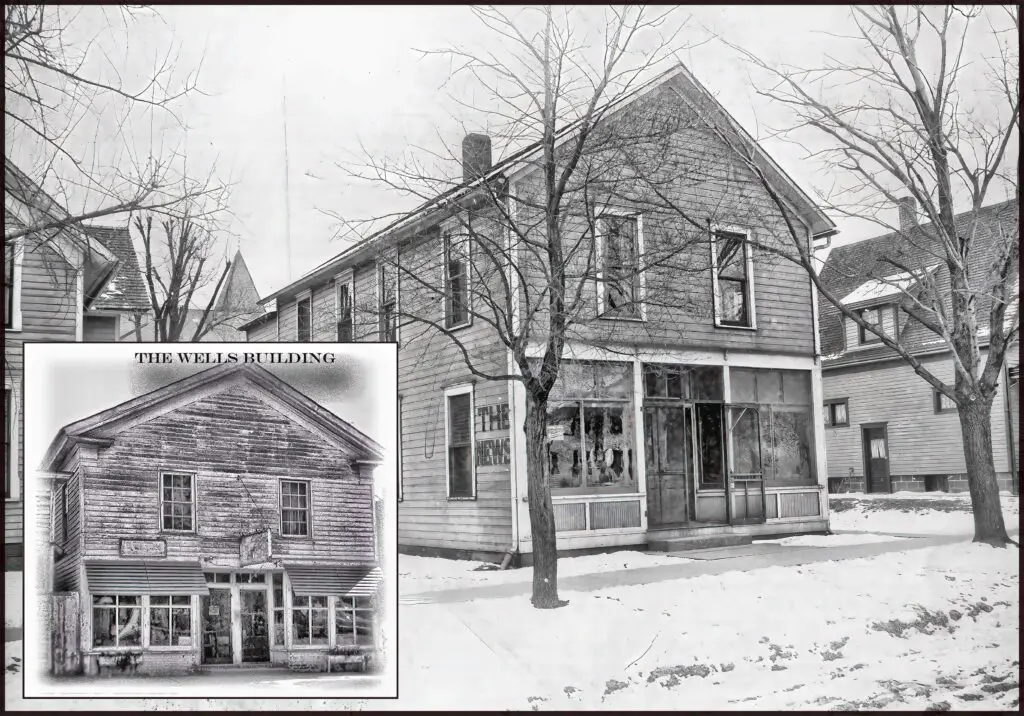
In early June one hundred twenty-seven years ago (in 1896) a weekly paper known as The Vermilion News was born on the second floor of the Wells Building on Grand Street. The publisher was one Robert M. Whitmore who brought the printing equipment here from his home in Green Springs, Ohio. It was an eight-page newspaper with five columns on each sheet. Four of the pages (with national and state news) were printed in Cleveland, and the other four pages of local news were printed on a Gordon jobber press in the local plant.
From its columns folks learned that F. E. Englebry was the village mayor, Jay. A. Clark, clerk, D. H. Stevens, Marshal, John Wagner, Postmaster. The doctors were Englebry, Quigley; Bond and Beckwith, with E.S. Horton, Health Officer, looking after the welfare of the community. The Reverends Kaley, Lewis, and Pretzer were in charge of the Congregational, Methodist and Reform churches respectively. Professor C. W. Sloan was the Superintendent of schools. The Lake House a popular hotel was located on the site where the Fischer block was eventually built was under the management of one John Krapp. And the local Livery was run by Decker & Company.
Around the year 1897 the plant was nearly destroyed by fire and a number of files were lost together with some equipment. On November 10, 1898, the paper was again issued and December of the same year one George. L. Brown undertook its management. While these early files are missing it is known that in March of 1899 the name of George E. Whitmore appeared as Editor and publisher. He continued in that capacity until May 23, 1901, when Pearl and Bessie Roscoe purchased the business. On June 5, 1902, E. T. Bottomley of Milan purchased a 1/2 interest, and the NEWS was published under the name of the News Printing Company until May 1st, 1904, when the Roscoes became sole proprietors again.
On February 12, 1903, the office was moved downstairs to the north room of the Wells building. On September 17th of the same year a Taylor drum cylinder press was installed, and the newspaper then appeared as a six column, eight-page paper. In the autumn of 1904, Roscoes purchased an empty lot further south on Grand Street. On November 17th of that same year the newspaper was issued from a newly constructed building on that site. As in the past, only one half of the paper was printed on the home press. The other half was printed at Cleveland.
In the belief that the best interests of the village demanded an “all home” paper Roscoe took another step forward and a Simplex Typesetter was installed. On February 2nd, 1905, the NEWS premiered as an “all home” six column eight-page paper and had gathered so much material the editor was often obliged to either issue one or two extra pages or omit interesting news or advertising. In 1908 the Simplex was replaced by the Typograph that was used until 1916 when they purchased a Linotype state-of-the-art type setting machine. Then in September 1914 the old Taylor drum cylinder newspaper press was replaced by a Stonemetz, two revolution press. That press, as well as the Linotype typesetter, was still being used when the newspaper closed in 1964.
During those early years the NEWS was proud to have been able to report and help promote numerous positive changes in the village as it moved into the 20th century: The Lake Shore Electric interurban that ran down the middle of Liberty Avenue; the Water Treatment plant, sanitary sewers, electric lighting, the public comfort station; street, sidewalk, and harbor improvements. And last but hardly least a wonderful 32 instrument Grand Army of the Republic (G.A.R.) Band.
In those years a newspaper was considered to be one of the most valuable assets in any town. It was its greatest booster and probably did more for the general public than any other institution. In the19th anniversary edition of the NEWS in 1915 Editor Roscoe wrote, “In kind with humanity we have made our mistakes – [but] of the head, not of the heart. We have and will continue to stand for Vermilion first – for what we honestly believe to be her best interests.” Few could have asked for more.
Vermilion resident Rich Tarrant is Curator of the Vermilion History Museum and a son and a grandson of the late proprietors of The Vermilion News (1897-1964). Readers may email him at: rnt@twc.com
© RNT 6/11/2023

Shipwrecked in Vermilion
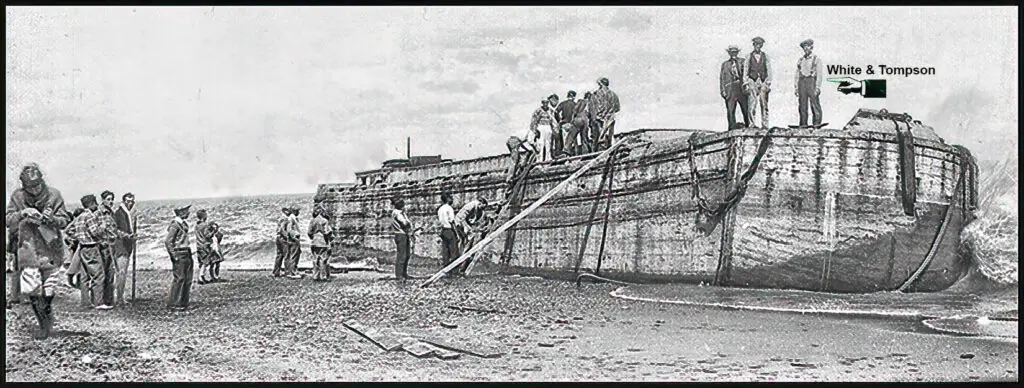
In 1927, Jerome Kern and lyricist Oscar Hammerstein II completed Show Boat, a milestone in the development of musical comedy. It told the story of life on the Mississippi River from the late 1880’s to 1927 and was based on the novel Show Boat (1926) by American writer Edna Ferber. The reason this show was so unique was that the music was integrated into the stories more realistically (were that actually possible) than the typical musical shows of the era.
During midsummer of this same year one Charles White, 62, of Buffalo and New York City (if that, too, were possible), and another fellow, George Thompson, 35, (who was just from Buffalo) were working as deck hands on the tug Henry Stokes out of Chatham, Ontario, Canada. The Captain of the Stokes was one E.J. Cadotte of Windsor. All were employed by a concern named the Dennison Sugar Company.
On Monday August 1st Captain Cadotte, White, and Thompson were in the process of towing two canal barges, the Hattie L. Kill, and the Charles Hawley, from Buffalo to Chatham. Around 11 p.m. the wind changed – blowing hard out of the northeast, and the barges were torn away from the tug. Or at least most of the barges were. The forward part of the Kill attached to the tug still remained. And the good Captain Cadotte sailed on.
Unfortunately, White and Thompson were not on the tug. They were on the Hattie L. Kill. And, just as unfortunately, they were not on the part of the barge that Cadotte continued to tow through the raging seas toward homeport. ‘Twere their fortune / misfortune to have found themselves on the part that broke away – and consequently – sank.
If this was a musical comedy this would have been the part where the two beleaguered deckhands might have broken into song. But this was, understandably, far from being either a comedy or, much less, a musical comedy. For the next 5 1/2 hours the two men clung for dear life to the wreckage of the Kill.
Around 4:30 the following morning the Vermilion fish tug Potter captained by George Leidheiser, and his crew; Jim Wenling, Harry Ruddy, Harold Tischer, Dave Neiding, and Vern Leidheiser came across the water-clogged pair and plucked them from the drink.
In the meantime, Captain Cadotte, who had happily made port shortly before midnight on Monday, was aghast when he discovered that not only had he lost a barge and a half but had also lost Charles White and George Thompson as well. He promptly notified authorities. Upon receiving the news, the U.S. Coast Guard in Lorain, Ohio quickly dispatched a search/rescue team. Their initial efforts proving unsuccessful, they took-up a command post in Vermilion Harbor and met the Potter when she steamed into port with the shipwrecked sailors.
When the sun rose on Tuesday morning early risers along the beach at Main Street found the wreckage from the Hattie L. Kill strewn across the sands by the waves still being churned by the northeaster blow. And still further east near the beach at Nokomis Park the great hulk of the canal barge Charles Hawley lay lifeless in the shallows near the shore.
Later, as sightseers gathered and clambered aboard White (left) and Thompson (right) posed atop the barge for Vermilion News Editor Roscoe’s Graflex camera. I suppose in the world of the musical comedy it would have been time for another song. If so, it would have very likely have been more in the way of a psalm.
Ref: The Vermilion News; 8-4-1927: Through These Gates; Karen and Ray Boas; 1984, Linwood Press; Vermilion Area Archival Society; VPJ 10/22/2006; Rev. 06/04/23.
Vermilion resident Rich Tarrant is Curator of the Vermilion History Museum and a son and a grandson of the late proprietors of The Vermilion News (1897-1964). Readers may email him at: rnt@twc.com
© RNT June 4, 2023

REUTENER
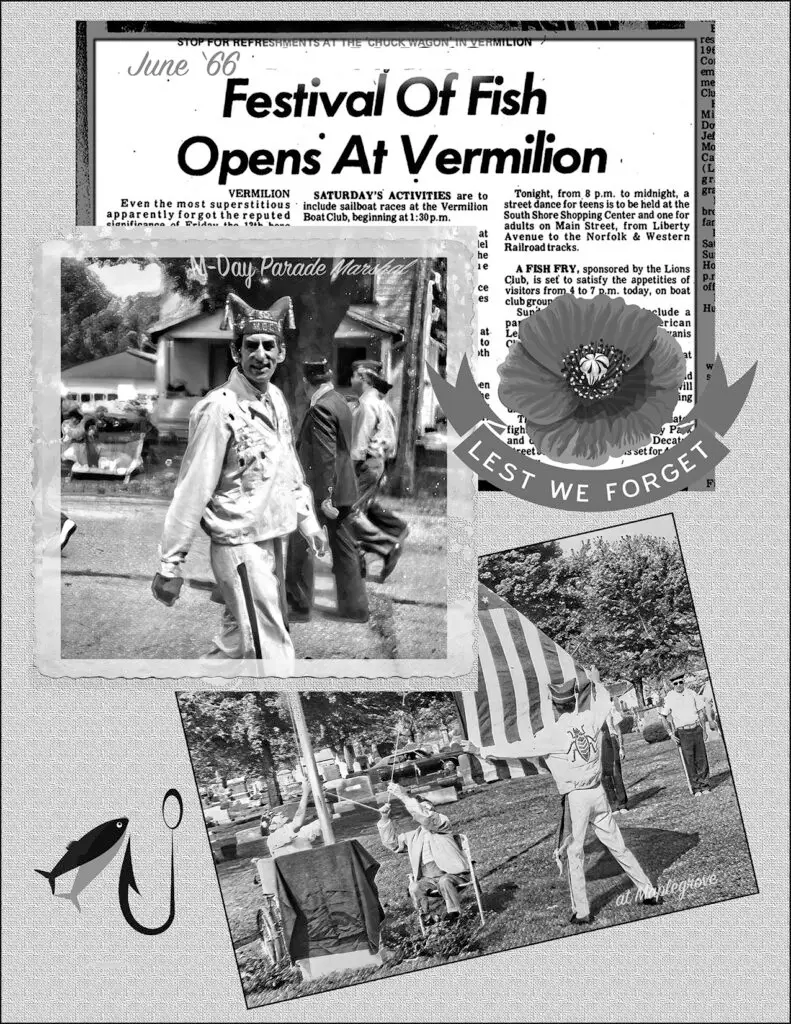
I believe that back in the ‘60s, 70’s, and probably into the 80s it is likely that thousands of people took note of his presence at Vermilion Memorial Day and Festival of the Fish parades. Ironically few of those persons really “saw” him at all. They were busy being entertained by the marching bands, colorfully decorated floats sponsored by various organizations, drill teams, scout troops, notable personalities in convertibles and sundry other things that make up American parades. What most folks saw when he walked past was a tall dark-haired man wearing a white jacket, white trousers with a red stripe on each leg sporting a very strange – a “jester-like” red cap – with two red horn-like “thingies” on each end that were topped off with gold tassels. Few in the crowds would have missed seeing him. But only a handful of those spectators recognized him. He really wasn’t part of those parades. He was the person who made it happen.
His name was David Paul Reutener. He was born in Cleveland in 1929 and had been transplanted at an early age with his family to Vermilion (Heidelberg Beach) where his father worked as a gardener for the Ruetenik family’s agribusiness at Mitawanga. After his graduation from VHS and Bowling Green University Dave served with the U.S Army in the Philippines from 1952 to 1954 during the Korean Conflict. Following his service, he worked as a sales representative for Vermilion’s Kyle Motors as he quickly became active in local civic, fraternal, and military veteran groups. For his active participation with the local Council for Exceptional Children (among other things) he, along with Vermilionite Bob Liljegren, received the “Man / Men of the Year” award in January of 1964.
In 1958 Dave, who was a member of both the American Legion and the VFW assumed the task of Vermilion’s Memorial Day parade marshal. Prior to that time the town had always had someone give a Memorial Day address, but there was not “always” a real parade. Often those who gave the address were not local persons. To Dave’s thinking a parade would allow more Vermilion people the opportunity to participate in honoring the men and women who freely gave their lives for our nation. Ergo the town reincarnated our annual Memorial Day parades. And Dave, as said, became Parade Marshal.
Persons who watch parades don’t generally consider the work required to organize and arrange not only the time and route of the march, but who and how many units will participate, when and where they will be expected to stage, and also arrange for their safety. Bear in mind that this was a volunteer task. Then, in 1966, when the Festival of the Fish was being planned by the Chamber of Commerce, it was noted that Dave had very successfully put together eight Memorial Day parades. Ergo: Who was better prepared to marshal a parade for the event than Dave? And that he did, well into the decade that followed.
Anyway, back to the man in while clothes and the funny hat. He not only directed parades – he marched in them as well as seen in the accompanying photographs. His attire identified him as a ”Cootie” (not the bug). Cootie, or plural Cooties was the name of a service association of the Veterans of Foreign Wars (VFW) that provides social support and entertainment to veterans and their families. The name “cootie” is a reference to the lice that plagued soldiers in WW1. Cooties (believe it or not) were credited with keeping soldiers’ heads down in the trenches. It is an honor degree in the VFW. Both President Harry Truman and George Herbert Walker Bush were members. And whether as a Cootie, a member of the American Legion, a Mason, a member of the local E&R church, or just an American he visited hospitalized veterans, supported homes and scholarships for the children of deceased veterans, and actively supported programs for handicapped children as well.
So, the lanky guy in the white clothes with red stripes on his trousers and funny red hat with gold tassels was not just another participant in our local parades. It was Dave Reutener who believed all Americans need a good parade.
Ref: Special Thanks To: The Reutener Family.
Vermilion resident Rich Tarrant is Curator of the Vermilion History Museum and a son and a grandson of the late proprietors of The Vermilion News (1897-1964). Readers may email him at: rnt@twc.com
©RNT May 29, 2023

Gold Stars & Cod Liver Oil

A number of years ago, I began looking into Vermilion’s war casualties of a yesteryear at the behest of late Vermilionite John Vargo. While I am a war veteran (or rather because of it) it’s highly unlikely that I’d have pursued the subject on my own – because war is an ugly business any way you cut it. Nonetheless, I’m glad Mr. Vargo asked for the information because these things didn’t happen to someone else. They happened to us. And we would do well to know, remember, and never forget it. Consider it to be a little dose of “cod liver oil for the hometown soul”.
All in all, there were over 26 persons included in this survey. Not all of them were residents but are included because they either married a native Vermilionite or spent a good deal of time in the town during, what in many cases were, their short lifetimes. As a good nurse would not have anyone drink the entire bottle of cod liver oil in one sitting this brief extract of local history is just a single dose. But others may appear in the “Yesteryear” when and if deemed appropriate or (Heaven forbid) necessary.
GOLD STARS IN VERMILION: During the First World War, American mothers that had family members serving their country in the military wore a blue star on their left arm. As the conflict progressed and the number of dead escalated, mothers wanted to express their loss. A suggestion was made of sewing a gold star over the blue star. The idea was presented to President Woodrow Wilson and the practice was adopted in 1918.
A bold headline in the February 6, 1919, edition of The Vermilion News reporting the death of Private First Class George Feiszli in France read, “VERMILION’S FIFTH GOLD STAR”. The count, at that time, included another WW1 casualty, Archie Birch, as well as Vermilion’s Civil War casualties. But as generous as it was to include the men lost in the Civil War (albeit retroactively) for gold star status it was in error. For, in fact, PFC Feiszli was Vermilion’s seventh.
The first was Private Eugene Frankenberg. He was but 20 years old when he became a part of the 72nd Ohio Infantry. A member of the family told me, “The sad truth is that he did not want to serve in the army and ran away and was caught in Port Clinton and sent to Mississippi (to fight) where he was captured on 11 June 1864.” He was interred at Andersonville Prison Camp in Ripley, Missouri. Starving and suffering with a terrible case of diarrhea he died on 28 September 1864. He was only 21.
The second star was Private John Riblet (Note: In some places he is erroneously listed as being a Major). Private Riblet enlisted in the Union Army on 5 August 1862 at the age of 26. He was killed at Utoy Creek, Georgia on 6 August 1864. Utoy Creek was part of the Atlanta Campaign.
The third star was Captain Henry Delker (VPJ 05/25/06). Capt. Delker was a member of the 41st Regiment of the Ohio Volunteer Infantry. During the last minutes of the Battle of Nashville (December 12 through 16, 1864) he was seriously wounded in the left arm and side. Though he survived the war the bullet that wounded him on the battlefield had never been removed. It finally felled him in late December 1890. While he was originally an Amherst / Brownhelm native, after the war he lived in, and operated a popular dry goods store, in Vermilion where the Art Scene Gallery is currently (2023) located. The local chapter of the G.A.R. veterans’ organization became the Delker Chapter in honor of his service.
The fourth star was an 18-year-old Army Private by the name of Michael Delker whose home was in Brownhelm. Michael enlisted in the Union Army on 26 February 1864. He was the second oldest son in a family of nine. Like his older brother, Henry (above), he also joined the Army. Michael never lived to be 19. He was killed at Pickett’s Mills, Georgia on 27 May 1864.
The fifth star, also a Brownhelm native, was Private Thomas Gallaudet Wells who enlisted in the Union Army as a Private on 11 June 1861 at the age of 20 years. He was killed on 14 September 1862 at South Mountain, Maryland. The Battle of South Mountain was fought on the mountain at Crampton’s, Fox, and Turner’s gaps during the Maryland Campaign in 1862 leading up to the deadliest battle of the war at Antietam Creek just three days later.
Well, I believe that’s quite enough literal cod liver oil for now. Keep in mind that these snippets do not reflect the enormity of the sacrifices made by these men, their families, nor of those who experienced similar fates – not by a long shot (no pun intended). However, we need understand that it is both foolish and wrong to mourn those who have died in the service of our nation. We need rather to honor them by thanking God that they lived.
Ref: Ancestry.com; American Civil War Soldiers data base; The Vermilion News, 11/18/1918 and 02/06/1919; Special Thanks to John Vargo; VPJ, 08/09/2012; Rev. 05/21/23.
Vermilion resident Rich Tarrant is Curator of the Vermilion History Museum and a son and a grandson of the late proprietors of The Vermilion News (1897-1964). Readers may email him at: rnt@twc.com
© RNT May 21, 2023

The Day They Burned Down the Pop Factory
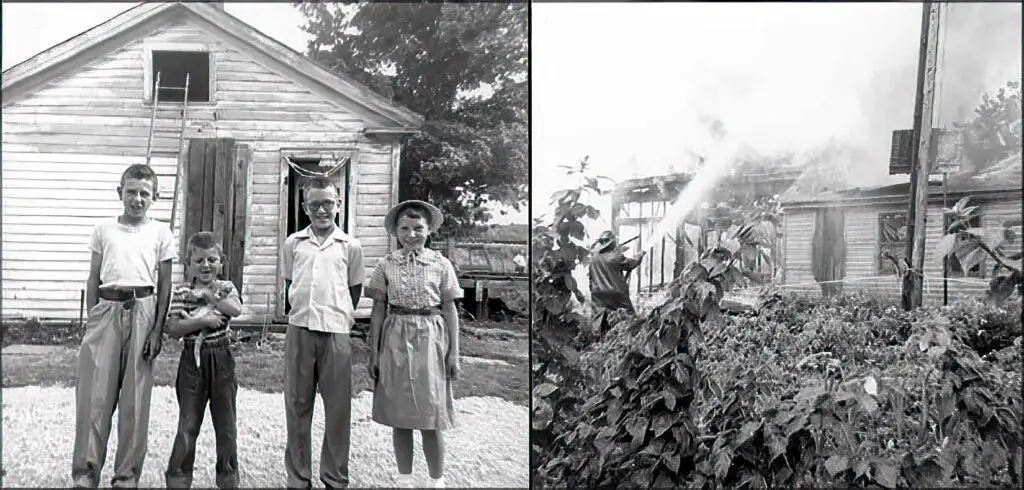
Several years back I was afforded the rare opportunity and pleasure to introduce 2 young brothers (4 and 5.75 years old) to Hostess Twinkies. There are zero words which describe the look on their faces as they bit into the “store bought” pastries for their very first time. And ignoring for the moment that the eclair-like delicacies are considered by some to be unfit for man or beast; the youngsters most certainly enjoyed them.
This experience took me back 67 years (or so) when I was 10 years old – a time when the Village of Vermilion, Ohio was my playground. It took me back to the amazing glass candy display case, smudged by dozens of children’s noses, in Baumhart’s Drug Store on Division Street; to the 5 cent cherry cokes that could be had at Jim Hart’s wonderful Corner Drugstore; to icy mugs of Hires Root Beer fresh from the barrel that stood at the end of the tiny soda counter in Litman’s Newsstand next to Hart’s; and to the icy cold bottles of pop that could be had for only one thin dime from chest-type coolers commonly found at numerous gas stations and garages scattered about town. How wonderful those times were.
But the best thing of all was knowing that just down the street behind and east of St. Mary’s Church – in the middle of the lane called Columbus Street that runs between Division/Main Street to the west and Sandusky Street to the east – Vermilion had its very own pop factory. What more could anyone (let alone a young boy or girl) ask for?
The Hi-Top Beverage Company / Vermilion Bottling Company was established sometime in 1910. Precisely who established the company is presently unknown (to me). What is known is that sometime during the 1950’s a local entrepreneur, Larry Shafts, purchased the plant from the Feldcamp Family. And whilst there be a great deal of merit in the ownership and operation of any small business there are also numerous legal, financial requirements and demands that must be met in order to be successful. In America during the 50’s corporate soft drink companies had a great deal of capital at their command; a fact that, consequently, made competing for the market impossible for the small bottling companies. And, thus, did Vermilion’s pop factory fall victim to those changing times.
Were that story not gloomy enough (for any youngster) in the summer of 1954 Mr. Shafts volunteered the property to be used by the North Central (Ohio) Fireman’s Association in an exercise as “an up-to-date fire test on indirect application of water on interior fires”. And on a bright Sunday afternoon, August 1, 1954, a crowd of over 1500 persons watched as the Vermilion Fire Department, under the direction of then State Fire Marshal, Charles R. Scott, staged the practice session – and burned Vermilion’s pop factory to the ground.
Three of Mr. Shaft’s nephews and a niece (Pictured R-L: David, Dale, and Larry Hohler and Cindy Shafts) posed for their picture outside the plant that just a few minutes later (also pictured) was in the process of being hotly consigned to the yesteryear. It was an experience, like the first time a youngster tastes a “Twinkie”, that would never be completely recalled; but never be entirely forgotten: The day they burned down the pop factory.
Ref: The Vermilion News, 8-12-1954; The Lorain Journal, 7-29-1954; Special Thanks to: Dale Hohler in Memory of his brother Larry; VPJ, 1/31/08; Rev. 04/14/23.
Vermilion resident Rich Tarrant is Curator of the Vermilion History Museum and a son and a grandson of the late proprietors of The Vermilion News (1897-1964). Readers may email him at: rnt@twc.com
© RNT May 14, 2023

Vistors & Visions (of Yesteryear)
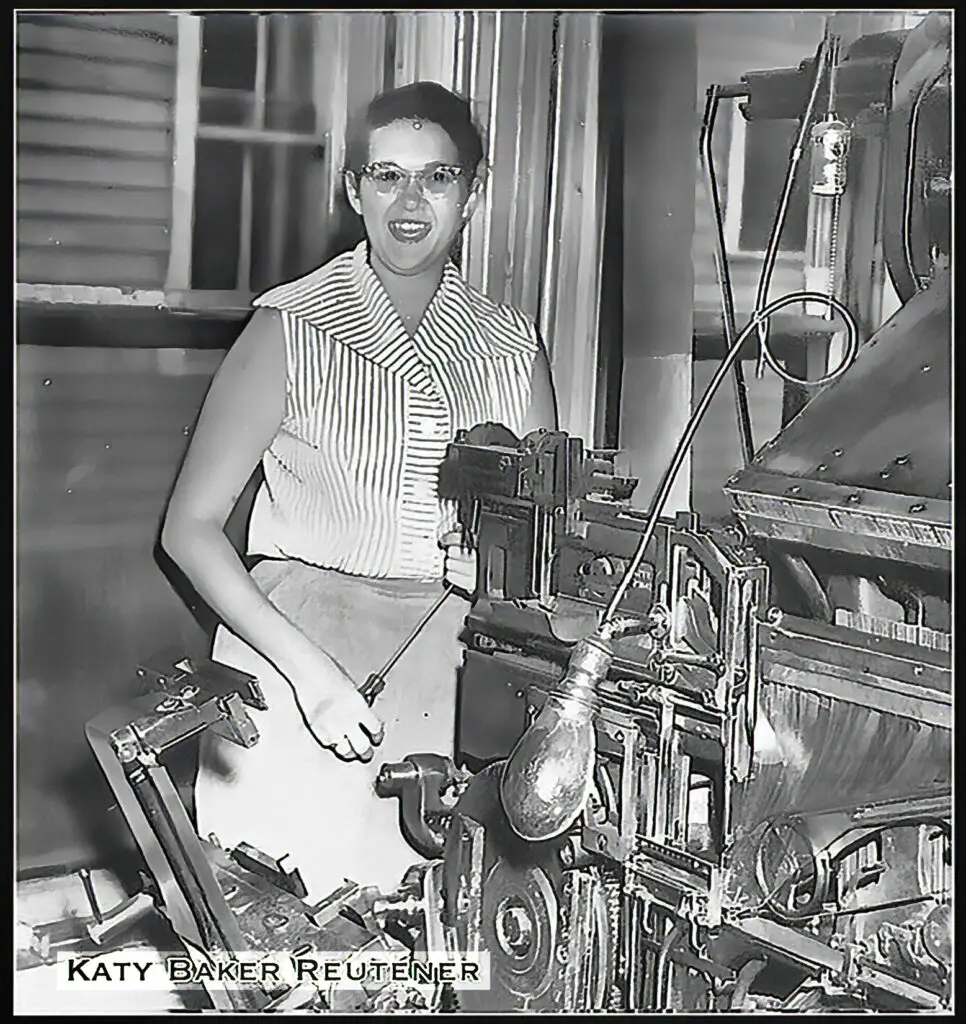
“There are a many interesting things in museums. But the most interesting – I have found – are the people who come to visit.” – Rich Tarrant
Vermilion expatriate Earl Lee Tischer stopped in at the Museum one Friday in 2014 for a spell. I’d not seen him for several years. After he retired from Ford in Sandusky, he and his wife Margorie Jean moved to Crystal River, Florida. [Marge passed away in 2012]. Some Vermilionites may recall that among other things Earl served as a member of Vermilion’s council for several years. Older residents will, of course, have no trouble remembering Earl or his family.
Earl’s grandfather was William Adam “Dad” Tischer (1860-1945) and his grandmother was Hilda “Alice” Moulton Tischer (1863-1941). Dad Tischer was a volunteer fireman in Vermilion for 54 years. As chief of the department, he brought it into the 20th century when he advised town council to purchase its first motorized fire vehicle back in the early years of the 20th century. He was a building contractor. Among his many works was Vermilion’s first brick library built during the Great Depression years. Earl indicated that he wanted to send me additional information about his family. And he did – or at least his daughter Trudy did – following his demise.
Walking through the museum looking at equipment and pictures the elder Vermilion statesman began to reminisce about some of the people he knew growing up in town. He talked a bit about photographer Rudy Moc – going out to Moc’s house on Darrow Road on Monday nights with one of my brothers, Phil, to watch professional wrestling on Moc’s big screen television. [“Big” being a relative term. Instead of it being a 10-inch screen, common in those days, it was probably a 14 incher.] Not many families had televisions back in the 1940s.
He also spun a few anecdotes about George Roberts, Alfred Smith, and Hank Ries who only did interior painting, but never painted when it rained. (Go figure). All good stories. He then spoke of late Vermilion school superintendent C.K. DeWitt.
Mr. DeWitt was a very meticulous person. He and his wife owned the Lustron “all steel” home on Jefferson Street. (Some said he trimmed his lawn with a comb and a pair of scissors.) Earl told me that Mr. DeWitt was very particular about his dress as well – especially his shoes. They were always highly shined. This so inspired Earl and a friend that the boys habitually began to brush and polish their shoes and put a real gloss on them. One day at school Mr. DeWitt came in his classroom for some reason or another. Noticing Earl’s shoes, he sidled up to him and said, under his breath, that he really admired the shine on his shoes.
Before leaving the museum that day Earl told me that he probably would not be coming back to town again while a resident of this world. Earl passed on in 2017. And methinks we’re all poorer for that.
The following day Vermilionite Katie Baker Reutener stopped into the museum with her granddaughter Sara. Katie still lives in town. Most folks probably know her better as the lady who worked behind the counter at the old Lake Erie Lanes bowling alley. I’ve known her most of my life. In fact, after graduating from Vermilion High she worked at the print shop for nine years (1954 to about 1963-64) until her oldest child was born. Katy was a linotype operator in the shop. The photo accompanying this essay shows Kate by “her machine” taken during those years.
Her great-grandfather, Dr. Benjamin F. Bond (b.1840), practiced medicine in the Vermilion area from about 1872 until his death in 1926. Kate donated his account book to the museum wherein he recorded his horse and buggy appointments about the region. She said he charged more for the birth of boys than girls – and was sometimes paid with a “pound of butter” etc. He apparently was a very sage businessman as well. A family member told her that he used to take mud and roll it into little pill-like things. Miraculously, the earth born medications seemed to cure all sorts of ailments.
Kate’s grandfather, Frank “Bunny” Bond ran a café. I guess that’s a nice way of saying he ran a beer joint that also served food – and I don’t mean that to be a derogatory observation. The place still exists today (2023), but with a new name. It’s called Rudy’s Bar and Grill. Frank’s only son and Katy’s uncle, Bill (VPJ 05/09/13), lost his life in France during WWII.
Looking around the shop Kate remembered how working with the lead “pigs” / ingots and lifting the magazines (both items used for the linotype machines) made her stronger. She also recalled my father (she always called him “Mister Tarrant”). “He was the most intelligent person I ever knew.” Because of that she seldom asked him a question. She said, “If I asked him about something he’d go back to the Stone Age (i.e., the beginning of things) to answer. He read encyclopedias in his spare time.” And turning to her granddaughter she said, “You learned how to read upside down working here.” That was because it is the way the words / letters for letterpress printing are set – upside down and backwards.
Every now and then people ask how I think of things to write for this column. Well, It’s not really all that hard. Not with all the pictures and other items surrounding me at the museum. But what really makes it easy are all the wonderful people like Earl and Kate, ad infinitum, who take a few minutes to visit – and leave me with a wealth of visions of their lives in Vermilion and elsewhere of yesteryear. Who could ask for more?
Vermilion resident Rich Tarrant is Curator of the Vermilion History Museum and a son and a grandson of the late proprietors of The Vermilion News (1897-1964). Readers may email him at: rnt@twc.com
© RNT May. 7, 2023

OLD NEWS CAN BE FUN NEWS
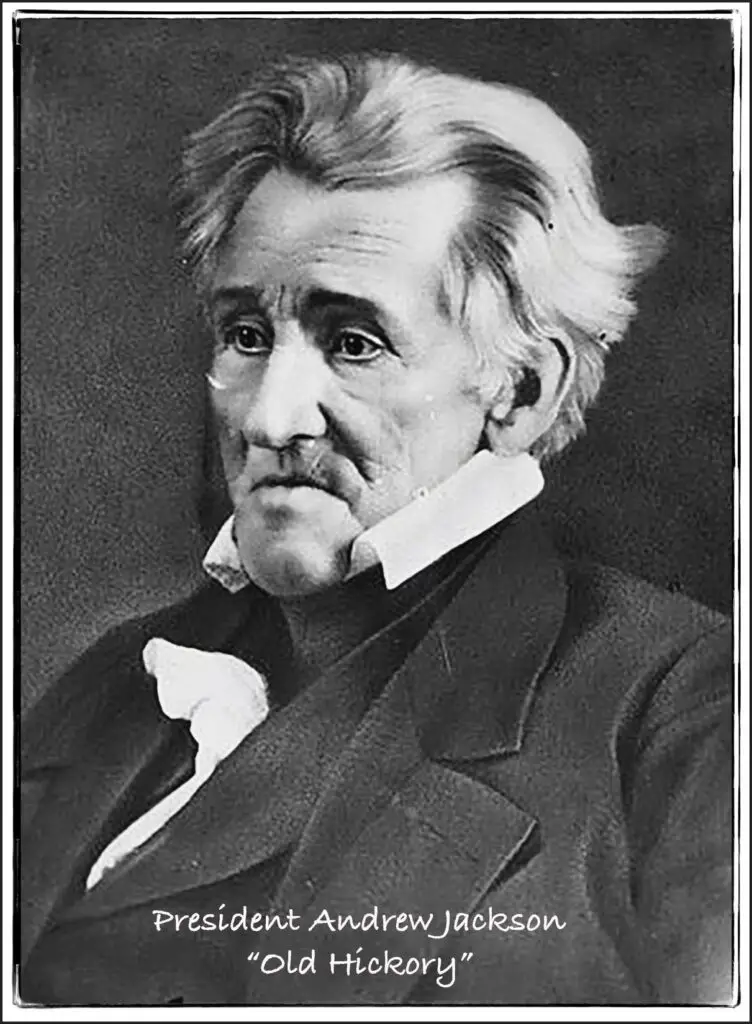
And so, I begin this essay with an ominous title. But it’s a deserving one. I recently featured a photograph of the soon to be demolished State Street School building on the social media platform known as Facebook and was surprised to discover how many persons seemed distressed about the soon to be permanently dismissed old building. As an amateur historian I don’t like to see these old landmarks disappear either. But even given my very limited knowledge of the structural integrity of any building it seems to me that the aged school is probably well beyond repair. I seriously doubt that funds for renovation might have been easily found. Moreover, I am very surprised that the funds to raze it were realized. Neither operation could be cheap. Ergo, we must bid adieu to yet another local landmark. Like it or not.
As I thought about this I very, coincidentally, came across the accompanying photograph. I realize that few persons other than myself may understand the reason I refer to this as a coincidence. It’s because the two homes in the photo were situated next to –north of – the aforementioned State Street School. The photo is a tad hard to decipher (understand) for several reasons. 1.) the large house on the left is gone, and 2.) the open front porch on the house on the right (south) has been altered.
I acquired this photo from Nancy Kneisel-Tate who, until just a few years ago, lived in the smaller home. It was that of her grandparents John and Martha Nieding-Walper. Their daughter Margaret married Andrew Kneisel. Nancy’s father, Roy, was their son.
The original home owner, John Simon Walper with his “team of grays”, distributed oil products for the Standard Oil company throughout the countryside surrounding Vermilion. In the early years of the 20th century Mr. W. and his trusty horses also made themselves available to the local volunteer fire department when the need arose. There are probably very few families in Vermilion who can say they, or their kin, occupied the same home for nearly a century as did the Walper-Kneisel family. But back to the photograph.
The house – the grand-looking house – next door to the Walper home was (in my younger days) the Halloran home. Initially, it was the home of Katherine Hahn-Raver. But eventually it became the home of Katherine’s daughter Mable Raver-Halloran. She remained in the home after she and her husband, James, parted ways sometime between 1910 and ’20. Their daughter Beatrice Daisey Kiplinger inherited the house after her death. And when she passed her youngest son Jim took up residence in the home. Due to his declining health the home fell to ruin. By the time he expired in 1999 the once very attractive residence was so far beyond salvation it had to be demolished.
If you pass the site of this photograph today (as many do) it is unlikely that you will notice, let alone, recognize it. But for me, and maybe a few others, it’s still all there: It’s akin to the way heat rises from a paved road on a sweltering summer day. A ghostly chimera of that yesteryear seems to rise and ripple in thin air before dissipating – into the shape of today and, (for some) tomorrow.
Vermilion resident Rich Tarrant is Curator of the Vermilion History Museum and a son and a grandson of the late proprietors of The Vermilion News (1897-1964). Readers may email him at: rnt@twc.com
© RNT April 23, 2023

A GHOSTLY CHIMERA
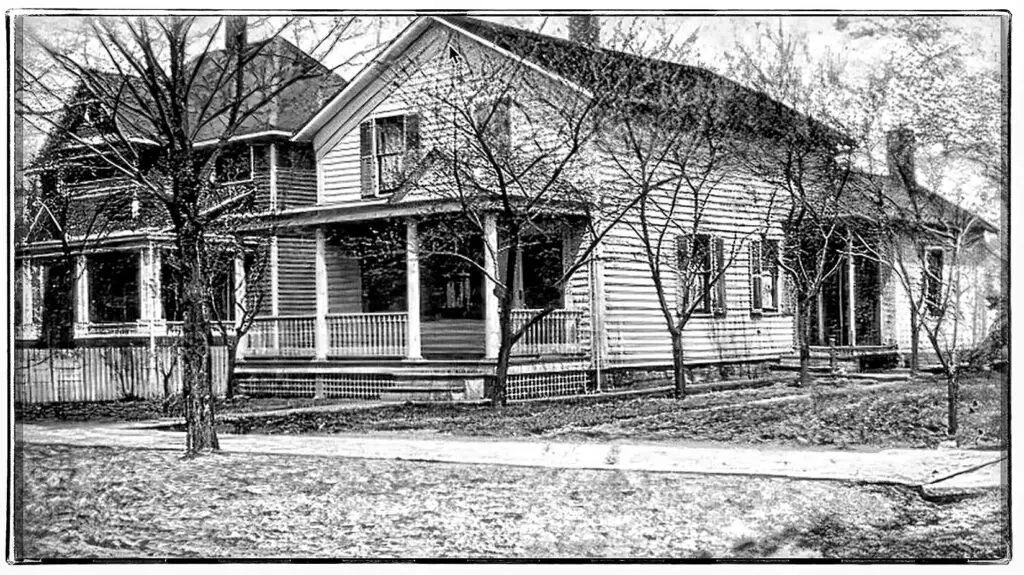
And so, I begin this essay with an ominous title. But it’s a deserving one. I recently featured a photograph of the soon to be demolished State Street School building on the social media platform known as Facebook and was surprised to discover how many persons seemed distressed about the soon to be permanently dismissed old building. As an amateur historian I don’t like to see these old landmarks disappear either. But even given my very limited knowledge of the structural integrity of any building it seems to me that the aged school is probably well beyond repair. I seriously doubt that funds for renovation might have been easily found. Moreover, I am very surprised that the funds to raze it were realized. Neither operation could be cheap. Ergo, we must bid adieu to yet another local landmark. Like it or not.
As I thought about this I very, coincidentally, came across the accompanying photograph. I realize that few persons other than myself may understand the reason I refer to this as a coincidence. It’s because the two homes in the photo were situated next to –north of – the aforementioned State Street School. The photo is a tad hard to decipher (understand) for several reasons. 1.) the large house on the left is gone, and 2.) the open front porch on the house on the right (south) has been altered.
I acquired this photo from Nancy Kneisel-Tate who, until just a few years ago, lived in the smaller home. It was that of her grandparents John and Martha Nieding-Walper. Their daughter Margaret married Andrew Kneisel. Nancy’s father, Roy, was their son.
The original home owner, John Simon Walper with his “team of grays”, distributed oil products for the Standard Oil company throughout the countryside surrounding Vermilion. In the early years of the 20th century Mr. W. and his trusty horses also made themselves available to the local volunteer fire department when the need arose. There are probably very few families in Vermilion who can say they, or their kin, occupied the same home for nearly a century as did the Walper-Kneisel family. But back to the photograph.
The house – the grand-looking house – next door to the Walper home was (in my younger days) the Halloran home. Initially, it was the home of Katherine Hahn-Raver. But eventually it became the home of Katherine’s daughter Mable Raver-Halloran. She remained in the home after she and her husband, James, parted ways sometime between 1910 and ’20. Their daughter Beatrice Daisey Kiplinger inherited the house after her death. And when she passed her youngest son Jim took up residence in the home. Due to his declining health the home fell to ruin. By the time he expired in 1999 the once very attractive residence was so far beyond salvation it had to be demolished.
If you pass the site of this photograph today (as many do) it is unlikely that you will notice, let alone, recognize it. But for me, and maybe a few others, it’s still all there: It’s akin to the way heat rises from a paved road on a sweltering summer day. A ghostly chimera of that yesteryear seems to rise and ripple in thin air before dissipating – into the shape of today and, (for some) tomorrow.
Vermilion resident Rich Tarrant is Curator of the Vermilion History Museum and a son and a grandson of the late proprietors of The Vermilion News (1897-1964). Readers may email him at: rnt@twc.com
© RNT April 23, 2023

WHOM THE GODS LOVE
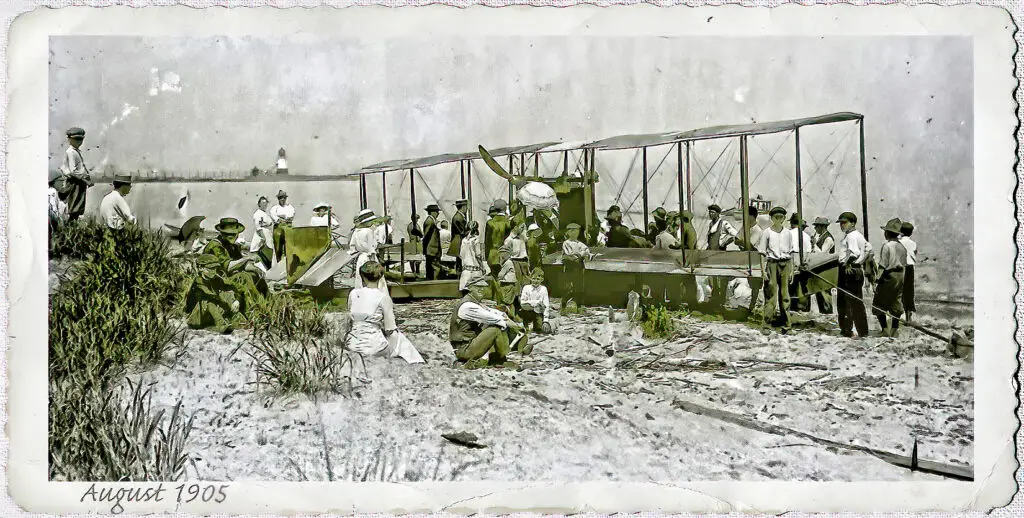
Eighteen years have passed since I initially became acquainted with and wrote about this day in local history. By the looks of things, it must’ve been a nice one. Some miles to the west, at Cedar Point, Ohio, a young flier from Washington D.C. named Anthony “Tony” Jannus (b. 6-22-1889) had been contracted by the manager of the Breakers Hotel to provide airplane rides for guests in his Benoist [ben-owah] Airboat Number 43. He had been working and living there since mid-July. [Note that early aviators were impelled by simple circumstance to use air exhibitions/races and provide persons with rides to help finance their craft, trade, and livelihoods.] Precisely who from Vermilion contacted Mr. Jannus is not known. But it is known that he was contacted and hired to bring his airboat to Vermilion on August 30, 1905, to open the Firemen’s Convention.
The first time I wrote about this event I used a photograph taken by my grandfather showing Mr. Jannus flanked by Vermilion businessman C.A. “Charlie” Trinter and a local haberdasher named Lewis Englebry posing in front of the plane on the beach at Linwood Park. I also have a photo of the plane as it was landing in the lake – and another of the aircraft moored in the river across from the Vermilion Water Treatment plant.
This photo of that event is new to me. I developed it from a glass negative supplied me by Vermilionite Alice Buell. I don’t know where she acquired it. But I’m glad she did. Initially, I didn’t know what was on the negative. And to be honest I was very surprised when I developed it. The identity of the person who captured these shadows is unknown (to me).
The lake appears to be very calm indicating that it was not a windy day. Nonetheless, the plane, facing the lake, is securely tethered to a stake in the sand. The greatest thing about this particular portrait (from my point-of-view) is the crowd that gathered to inspect the craft. There are over thirty people surrounding and inspecting the beached aeroplane. It’s unclear if the pilot is in the crowd. But no matter, it was surely a “significant” event in the lives of all Vermilionites – especially the young boys.
Aside from being a contemporary of Glenn Curtiss (for whom he later worked), the Wright Brothers, and, of course, Tom Benoist (his first employer), Jannus flew the first airplane from which a parachute jump was made, in 1912. He is also recognized as being the very first commercial passenger airline pilot in the world. At exactly 10 a.m. on January 1, 1914, he gave throttle to his Benoist Airboat in the waters of a yacht basin in St. Petersburg, Florida and took off on the first round-trip commercial passenger airflight in history; the St. Petersburg-Tampa Airboat Line was born. He may also be credited with flying the heaviest passenger on a plane at the time when he flew Vermilionite Lewis Englebry (who is said to have weighed nearly 300 lbs.) from the Linwood Beach to Cedar Point on that August day in ‘05. It was a day to remember.
Epilogue: On October 12, 1916, Antony Habbersack Jannus was killed when the Curtiss H Airboat he was testing for the Russian government experienced some mechanical problems and crashed into the Black Sea. His remains were never recovered. He was 27 years old. As the Roman playwright Platus put it, “He whom the gods love dies young.”
Vermilion resident Rich Tarrant is Curator of the Vermilion History Museum and a son and a grandson of the late proprietors of The Vermilion News (1897-1964). Readers may email him at: rnt@twc.com
© RNT April 16, 2023

VERMILION - 1914
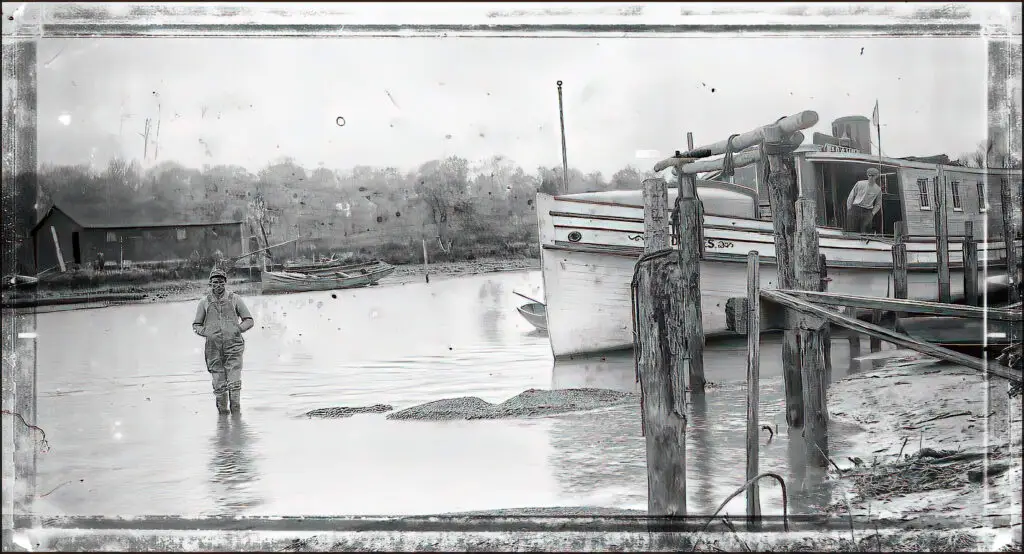
For almost two decades I’ve been transcribing bits and pieces from past issues of the town’s former weekly newspaper, The Vermilion News (1897-1964). Aside from reporting local news the old weekly also had correspondents who covered events in Huron, Berlin Heights, Birmingham, Axtel, Brownhelm and Amherst. Occasionally, there’d be a special report from the dailies in Cleveland, Lorain, and Sandusky. But it was mostly local stuff. Included were reports from area neighborhoods with names such as Ceylon Junction, Ogontz, Ashmont, Joppa, and Strong’s Corners. It’s been a fun as well as informative task. This year I’ve been immersed in 1915. Last year it was the affairs of 1914.
As is obvious from the accompanying photo the river was a tad low that year. And in late March the Driscoll Fish Company people weren’t very happy about it. A communication from the company was read to the village council stating that the river had become so shallow at their docks that at low water, boats could not be moved (as seen in the photo). They asked that the council help remedy the condition. The letter also intimated that improvements [to the fish house] were planned but the condition of the river would prevent them being made, and that it might conclude with the “dismantling of the plant”. After some discussion council moved to have the matter referred to the street committee. At the time there was no harbor committee.
Then Village Mayor, F.W. Wakefield, stated that $7,000 had been appropriated for dredging and that he was trying to ascertain how far up the river the government had ever dredged. He asked that anyone who might have definite information in this respect inform the committee or mayor.
The editor of the News responded by writing with a big bold headline: LET’S DO SOMETHING – “There are some who do not realize the importance of our river. The government has appropriated $7000 for dredging purposes and as it is up to the village and abutting property owners to look after the rest of the work. We believe it is about time something was done. The river should be dredged to the wagon bridge to a depth of 10 or 12 feet and the time for the completion of the work would be when the government equipment is here. Why not get busy. Fishing is one of our most important industries and while it is well to look for other industries to locate here, we should endeavor to assist those already here to such an extent as to keep them for our own. We realize it might be cheaper and more economical for an industry to move than to go to a great expense unassisted to remedy some defect in their present location. Here is a job for the chamber of commerce as well as individuals to look into. Let us get busy.” To their credit they did.
In the early months of 1915, the U.S. Government finally approved dredging the harbor at the mouth of the river and also agreed to help dredge the river to the wagon bridge. Government engineers estimated that the work of dredging the channel to the bridge would not cost more than $1000 not including the dredging for property owners which would be approximately $0.10 per cubic yard. It was, to say the least, good news.
Speaking of the harbor there was the following carefully worded report from a Cleveland publication about VERMILION’S NEW BOAT CLUB: Possessing one of the cleanest and beautiful little harbors on Lake Erie, the little town of Vermilion, located on the Ohio shore, 35 miles West of Cleveland has at last awakened to its possibilities and a Boat Club has been organized by a little band of enthusiasts. It is called the Vermilion Boat Club. The officers are Commodore, T. J. Ball; vice Commodore, William Showalter; Secretary, A. F. Wakefield; fleet measurer, A. J. Copeland.
Although but a few months old, the club boasts a membership of 50 active yachtsmen and a fleet of about 18 power and sailing craft. Vermilion is a well-known fishing port and is located at the mouth of the Vermilion River, which is navigable for large boats for “some little distance” from the harbor mouth. The government maintains piers protecting the entrance with a fixed red light at the outer extremity of the west side of the channel. This harbor is a favorite port of call for passing powerboats and powerboat men, who find it’s quiet hospitality a relief from the old coal harbors so common along the Great Lakes route.
They also noted that the latest addition to the Vermilion fleet was a new 45-foot cruiser, designed and built by the Matthews Boat Company for F. W. Wakefield. Wakefield’s new cruiser was called Lotus 2, and was powered with a four-cylinder, 30 horsepower marine engine. It was said to be one of the handsomest and roomiest cruising vessels on the lakes.
In the same issue it was reported that the little son of Mr. and Mrs. Clifford Parsons had been very ill the past week suffering from spasmodic croup, but he was considerably better at the time. Their son’s name was Nelson To further elucidate – this little guy was Vermilion’s Rich, Don, and Patty’s father.
There was also a report from the Cleveland papers containing the notice of the death of Karl P. Steinbrenner, eldest son of Henry and Sophia Steinbrenner at the family home in that town. It went on to say that the family is well known here. The mother before her marriage was Sophia Minch of Vermilion. They were, FYI, the g-great-grandparents of a prominent American businessman named George Henry Steinbrenner III.
Then, hidden away amongst all these dusty reports from the yesteryear was a simple recipe for pie crust: Three cups flour, 1/2 teaspoon baking powder, one cup lard,1/2 cup cold water. Cut all together with knife. Roll out. Will make 3 crusts. (Please make mine cherry.)
Vermilion resident Rich Tarrant is Curator of the Vermilion History Museum and a son and a grandson of the late proprietors of The Vermilion News (1897-1964). Readers may email him at: rnt@twc.com
© RNT June 5, 2023

A Happy Easter c.1954
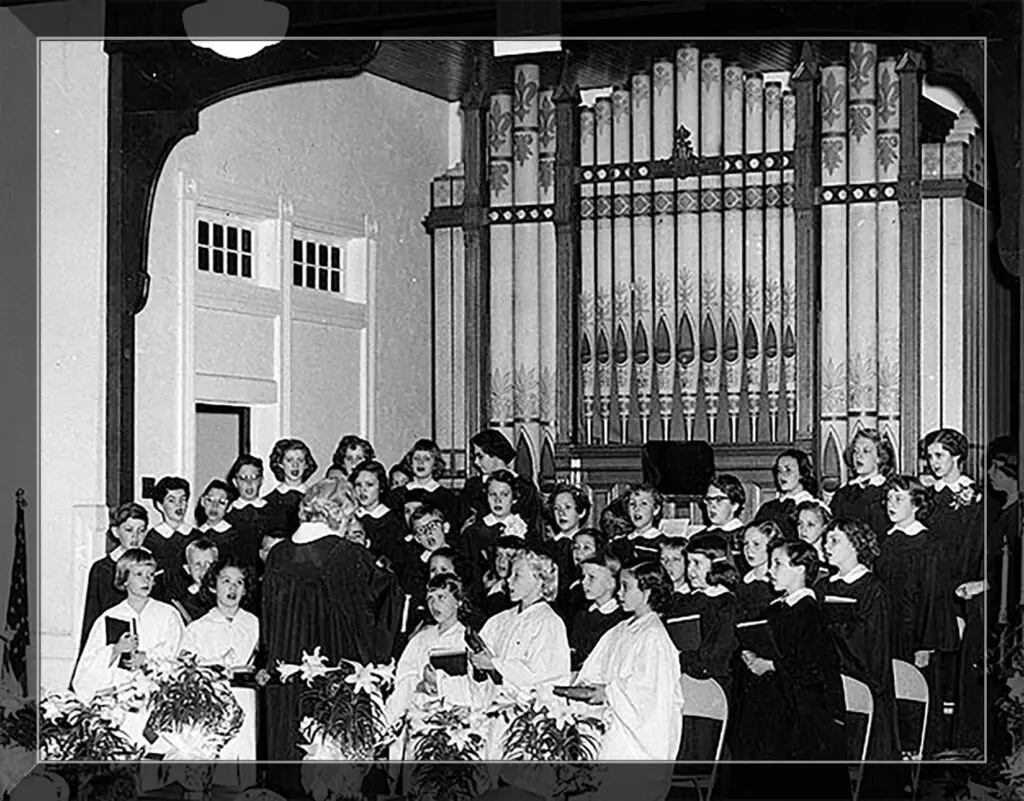
The portrait accompanying this week’s essay is more than likely irrelevant to most readers. However, I hope that many folks have (somewhere) either a similar photograph tucked away in their family album or, at least similar memories, in their memory banks. That’s because, for me, this photo is precious. It was taken nearly 70 years ago inside Vermilion’s First Congregational Church (currently Millet’s Auction House) next to the old Town Hall building.
Every year when Easter rolls around, I am taken back to the time these shadows were forever frozen by local photographer Harold Ludlow’s camera. In 1954 the church had a thriving congregation and, as is obvious, a fair-sized Junior Choir. The youngsters therein pictured ranged in age from about 8 to 12 or 13 years. Among them were some of my friends, relatives, and acquaintances when I was 10 years old.
If I had to guess, I would say that the choir is singing an old hymn called “Up from The Grave He Arose”. Widely used in hymnals of various Christian denominations, a Baptist preacher named Robert Lowry composed the hymn in 1874. I mention this and attribute / relate it to what is being sung in the photo because it is one of which 1.) I especially like, and 2.) I know for a fact that it was part of this choir’s regular Easter repertoire. I like the piece so much that I still sing it on occasion (but usually when alone).
Easter Sunday in 1954 fell on April 18th. Believe it or not I recall that it was a relatively warm day. The sun was shining. The birds were birding. The grass was greening. And the daffodils were blooming. I woke early. My dad had fixed his specialty; an egg omelet wrapped in a catsup sauce for breakfast; I ate and readied for church. Please note that I then had three older sisters who also attended church, and we had but one bathroom. So “getting ready” actually required a good deal of forethought on everyone’s part. But anyway, I put on my new light gray suit, and light purplish shirt, went out to the garden, picked a bright yellow daffodil, fastened it to the buttonhole on my jacket, and hurried off to church with my buddies, who were also my neighbors, Jake and Tom Boone. They too were esteemed members of the choir.
We liked to get to church early to get our choir robes on and chat with other members of the choir as they arrived. And, as I have undoubtedly mentioned before (in other tales), I was also in the habit of watching late Vermilionite Presdee B. Morgan as he pulled on the rope that rang the old Revere church bell calling people to church. Mr. Morgan was a very slight fellow, and I liked to watch because I thought a day might come when the rope attached to the bell would pull him up into the belfry as it recoiled. Fortunately for him, and unfortunately for me, that never happened. But I kept an eye on him anyway.
In 1954 many people, especially the ladies, purchased new apparel for Easter. So scattered throughout the congregation were numerous mothers and daughters who unknowingly provided a pastel-colored rainbow of fine bonnets and dresses amid their fellow congregants. Overall, there was a very palpable air of excitement amongst the lily-scented congregation and choir. Everything – the weather and the hymn we sang on that day could not have been more perfect for the event celebrated.
Looking over this portrait taken that day I am able to name and vividly remember many, but not all, those who are pictured: Jake Boone, Tom Boone, Jacques Jeffery, Carol Radde, Susie Hodgson, Karen Moeller, Glen Owen, Bobby Braden, Susie Rathbun, Linda Russell, Carol Idol, Judy Fisher, Janet Lindsay (my cousin), Zella Tarrant (my sis), Noreen Welch (another cousin), Judy Shaw, Patty Tokar, Mary Ellen Martinek, Judy Creel, and Cheryl Fisher. The choir director was a lady named Bertha Wood. I don’t know all the married names of the girls, so I didn’t use them in this instance. But many still reside in the Vermilion area.
In doing a bit of research about the aforementioned hymn I came across a man named Dr. C. Michael Hawn who is / was professor of sacred music at Perkins School of Theology at Southern Methodist University. In discussing the hymn, he, like myself, calls it a favorite of his childhood. He says, “Not only do I recall singing it on Easter Sunday morning…I also recall crouching low during the stanzas and jumping up suddenly at the beginning of the refrain.”
And here I thought it was only me. Happy Easter!
Vermilion resident Rich Tarrant is Curator of the Vermilion History Museum and a son and a grandson of the late proprietors of The Vermilion News (187-1964). Readers may email him at: rnt@twc.com
© RNT April 2, 2023

A RED BICYCLE
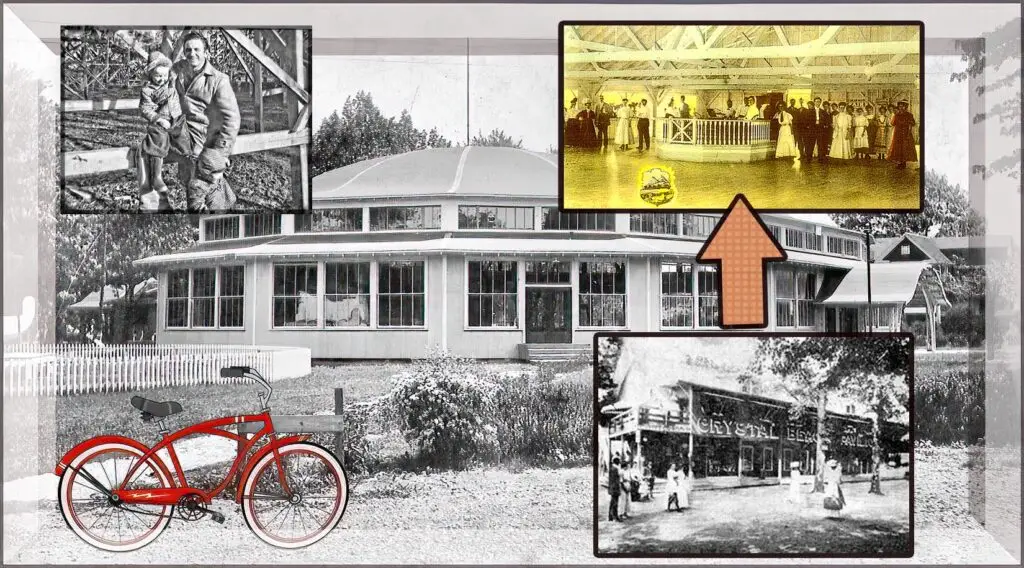
Long ago and far away is a place called Crystal Beach Park. There is now a place called Crystal Shores Apartments there. The Key Bank and the B.P. Station are also there now on the north side of Liberty Avenue. Across the street is the South Shore Shopping Center.
But once upon a time there was a wonderful amusement park (for me anyway) on that site. And it rivaled Euclid Beach and Cedar Point. Can you imagine that? I can remember the sounds and smells of the place. And I can still see it in my minds’ eye. What person wouldn’t. Wow!
It began as a summer picnic / outing park for folks in 1874. It was then known as (George) Shattuck’s (Shadduck’s) Grove. There was a bandstand for the bands, and the crowds came to listen to the music, picnic, or to just enjoy a wonderful summer’s day by Lake Erie. I don’t know if they danced in the shade in “The Park of a Thousand Trees”, but they must have certainly enjoyed the music.
And then in 1907 an area businessman named George Blanchat and his wife Josephine purchased the property and it became the Crystal Beach Amusement Park. It had a dance hall (inset picture). That particular hall was situated near the back of the park. It was destroyed by fire in the 1940s. It was immediately replaced by a one-story building, with a small bar, a dance area, pinball machines, and little crank cinema machines where for a penny a person could watch old-time moving pictures. [Don’t tell anyone but some were a little “racy”.]
When I was in my early teens, I spent a goodly amount of time at Crystal in the summer. They had a shiny rocket-ship ride, a carousel, dodgem cars, goofy-golf and a rollercoaster that scared the “bejabbers” out of me. The coaster structure was made of wood. I could not help but think that it might someday collapse into a pile of sticks. [Silly me.] On the Fourth of July the park always sponsored fireworks behind the Merry-Go-Round. They thrilled me to no end. The entire place was really and truly magic.
They also had their side games on the midway. For some reason late Vermilionite George Villa’s name (inset picture with his children) always comes to mind when I think of the park. George was a good man, and among many other things, he knew how to repair – or help repair – anything or everything on the grounds. For a short time, he and his family lived in one of the cottages at the park. He was a great guy – a WW2 veteran – who had many friends and a plethora of wonderful stories that both humored and astounded me.
Following the burning of the original dance hall (inset photos), the park owners built a new building along Lake Road in front of the park they called Crystal Gardens (large photo). And what a beauty it was. Glenn Miller and Tommy Dorsey, and many other national and local bands, played there for folks that crowded the floor. Above the crowd a lighted “crystal ball” would rotate in the dark spreading little points of light over the couples dancing on the beautiful hardwood dance floor. It was very, very romantic. Many couples met their future spouses there. My late sister Ellie and her husband John, among them. But it was also a site for political gatherings. I can remember being standing in a crowd there in the 1960s when the Republican vice-presidential candidate, Henry Cabot Lodge, gave a speech. It was, to say the least, also a very exciting place.
And as time passed the big bands and politicians evaporated. The dance floor was used primarily for roller-skating. In my younger days my buddy, Vermilionite Frank Homitz, and I used to go there to skate. I was (and remain) a terrible skater. I’d try to make a turn and land on my bottom nine times out of ten. Nonetheless, we always had a good time.
On a spring day in 1965 – off I went with the U.S. Army. I landed in in a place 10 thousand miles away called Vietnam. It was also an exciting place. Then one cold February morning several years later, I was dumbfounded when I passed the site of the old park on my way home from the war, to see that the whole darn place was “just gone”. That was in 1967.
I am hardly an expert on the park. Vermilionite Marlene (Calvert) Feldkamp and her sister Sandy are the experts. Their family owned it. The girls grew up there and lived in the big house that once sat near the front of the place. Marlene, by the way, still has artifacts from the park in her home.
Speaking for myself, all I have are wonderful memories of the park – when I was a boy on a bright red bicycle – exploring my town.
Vermilion resident Rich Tarrant is Curator of the Vermilion History Museum and a son and a grandson of the late proprietors of The Vermilion News (187-1964). Readers may email him at: rnt@twc.com
© RNT March 26, 2023

Yesteryear's Dreams of Tomorrow
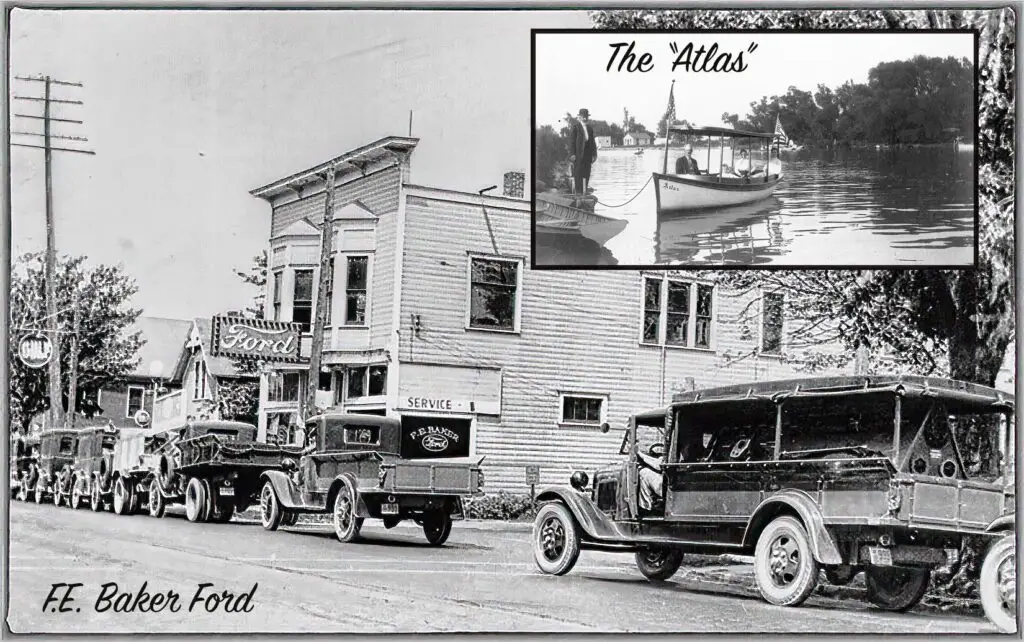
In mid-March of 1915, a few paragraphs in the “Little Stories of the Week” section of The Vermilion News announced that “Bert McQueen had received his chauffeur’s license and was prepared to carry passengers by auto.” It informed folks that the McQueen [horse] Livery had commenced a taxi service. The article went on to explain that they [McQueens’] now had “two autos on call” and intended to provide the public with “first class, prompt service”. It was a sure sign that the little Village of Vermilion in Ohio was keeping pace with the rest of the world.
That pace had picked up since the turn of the 20th century and it was most notably given a boost in the early months of 1910 when two brothers, Louis A., and James R. Dall, located a business for the manufacture of motor pistons in the village. To facilitate their business the brothers constructed their “Dall Motor Parts” building on the southwest corner of South Street and West River Road/Water Street. This is the building many once knew as the “Pickle Works” currently home to The Bad Boy Bait, Tackle & Archery store.
The brothers later operated a garage along the north side of Liberty Avenue just east of the Vermilion Boat Club. The building is currently owned by Moes Marine Service. There the brothers began to sell the finished product – the whole automobile – the Willys Overland. In 1915 James moved the dealership up the street (west) into the former Guy Davis Dry Goods Store on the northwest corner of Liberty and Grand Streets. This is the site where the town’s relatively new “Friendship Park” is now situated. Several years later he would relocate his business in Elyria. F.E. “Frank” Baker would later have a Ford franchise at that same location (large photo).
Louis Dall stayed with the engineering/manufacturing business until his death in 1949 at the age of 64. During the last few years of his life, he kept offices atop Vermilion’s Erie County Bank building on the southwest corner of Liberty and Division/Main Streets (now city offices). By that time, he had merged his Dall Motor Parts business with a Cleveland-based company, and had co-founded another auto parts manufacturing business, the H.A. Montgomery Company, located in Detroit, Michigan. And just for the appetite of history enthusiasts what follows is a byte of local trivia: Louis, who was an avid recreational boatsman, was the very first person to build and operate a power-driven pleasure boat on the Vermilion River. It is also noteworthy to learn that in March of ’15 a local fella named James Corbin purchased the gasoline boat “Atlas” (inset photo).
To be sure, the pace of things had definitely picked up since the turn of the 20th century with the help of the combustion engine. According to the first national road census taken in 1904 only 141 miles of America’s rural roads were paved, 18 of which were covered with a bituminous black top. Between 1900 and 1910, there occurred a 5,500% increase in motor vehicle registrations in the U.S. Paved roads had become less a luxury and more a desperate necessity. And the pressure to improve the conditions of American roads and to press local, state and the federal government to provide funding for road construction began in earnest.
In early 1914 an ad hoc committee, of persons from towns along the coast from Cleveland, Lorain, Vermilion, Huron, and Sandusky following the national Good Roads Movement, began to lobby for the improvement of what was then often termed as being the “Market Road” between Cleveland and Sandusky (Lake Road). In 1915 this little blip in the local paper appeared: “Work on the four-mile strip of concrete road in Vermilion Township (Shore Road) is to begin in the near future. The Buckeye Construction Company of Norwalk have the contract.” And thus did the pace quicken to improve roads in Vermilion and, as well, all across America. We were keeping pace.
The Lake Shore Electric interurban transportation system had, beyond the shadow of any doubt, proven to be a comfortable, easy, efficient, and cost-effective system. But it was not especially useful for persons living in rural areas on farms with a need to transport goods to the market; or rural mail carriers who had to traverse unpaved roads in all types of weather. Moreover, the idea of having a personal transport vehicle at one’s beck and call – especially after Henry Ford made it affordable to most Americans by 1908 – was an extremely attractive proposition. Ergo, improved roads and highways were not just desired by many. They were demanded. And the pace quickened.
I don’t know what happened to Mr. McQueen’s taxi business. But I’m pretty sure it survived the horse and buggy livery business. I know that J.R. Dall’s Ford dealership thrived in Elyria for decades after he left Vermilion. And I know for a fact that Vermilionite Frank Baker’s Ford dealership, that took its place, also proved prosperous for many years as did several others, such as Kyle’s Buick-Pontiac, Sharpnack’s Chevrolet-Oldsmobile, Walker’s Dodge-Plymouth, Martin’s Kaiser-Frazer, etc. But methinks the tempo of things that became the impetus for our nation’s vision in the yesteryear continues. Where it might lead in the morrow can only be found in a young person’s dreams.
Vermilion resident Rich Tarrant is Curator of the Vermilion History Museum and a son and a grandson of the late proprietors of The Vermilion News (187-1964). Readers may email him at: rnt@twc.com
© RNT March 19, 2023

A NOTE FROM NUG
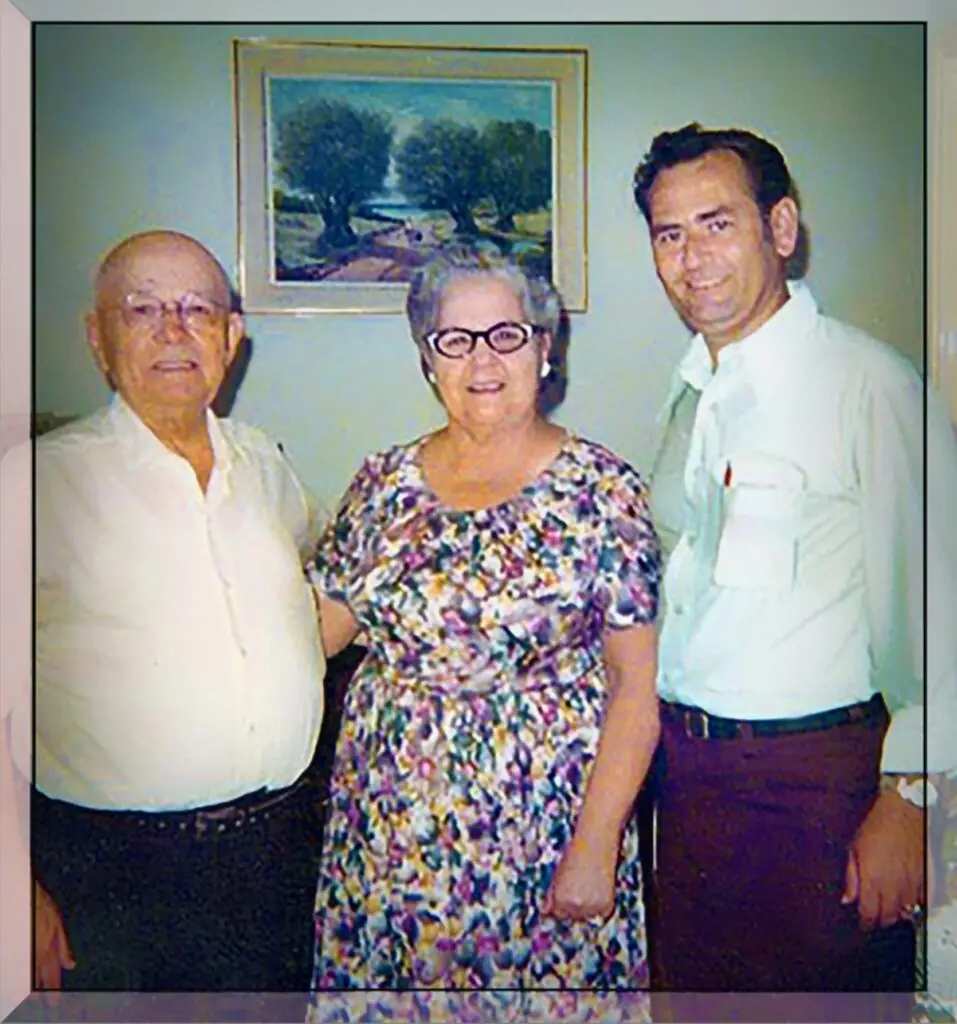
A PROFILE: Several years ago my late friend Nuggie Cook wrote down some of her memories regarding Paul and Amalie Metrakis, that are rather interesting. They are, in fact, worth sharing with everyone: I know that many older longtime Vermilionites remember Paul and Emily (Paul’s Snack Shop), but few of us knew much more about them. These are Nug’s notes:
RNT…
Memories of Paul Metrakis: for what it’s worth. Paul came to Vermilion with a friend, George Jansen, from Canton. They roomed at our house, in 1941 and started a business in the little hole-in-the-wall by the White Inn run by Don Englebry. Paul’s partner, after a few weeks, ran off and took all the money. My dad, E.J., lent Paul enough money to restart his business, and Paul used the ice house to keep his food safe. In fact, he kept using Dad’s ice house all through the years that he was in Vermilion.
Paul lived with us during that time and would cook our Sunday dinners. He kept the door shut because he didn’t want us to know the secret ingredients he used in his cooking. In later years he visited Greece, came back with his wife, Amelia. He complained about her, and yet he did bring her here. I kind of got the impression that Paul’s Greek relatives fixed him up with Amelia. He was always good to me and I got many a free Paul’s special-sauce hot dog sandwiches. Paul also owned a place called “Cracker Box” in Amherst and hired Clayte’s sister, Neota to work for him. Her younger brother Clayte worked for Paul’s Snack Shop. I met him there in 1940.
Isn’t it strange, Rich, how lives move around and intertwine in a small town? I drove my mom, Ella Mae, to Axtel every Sat. because her orchestra supplied the music for square and round dancing. On March 1946 at the end of W.W.II, Clayte showed up at Axtel. We started dating and later married in Sept. Paul was at our wedding also, so we never know where we will cross each other’s paths in life. I like the UCC logo, “don’t put a period where God has put a promise.” We just never know, do we?
Shalom,
Nug
One item I would add to this is that while researching for the bio sketch I found both Paul’s and Emily’s addresses in Greece (where they died) to have been listed as the U.S. Embassy. My assumption is that this is the case because they were, in fact, U.S. citizens living in Greece. It’s probably a matter of protocol. But it’s not something with which I’m familiar.
© 2023 VHM

A Boy on a Red Bicycle
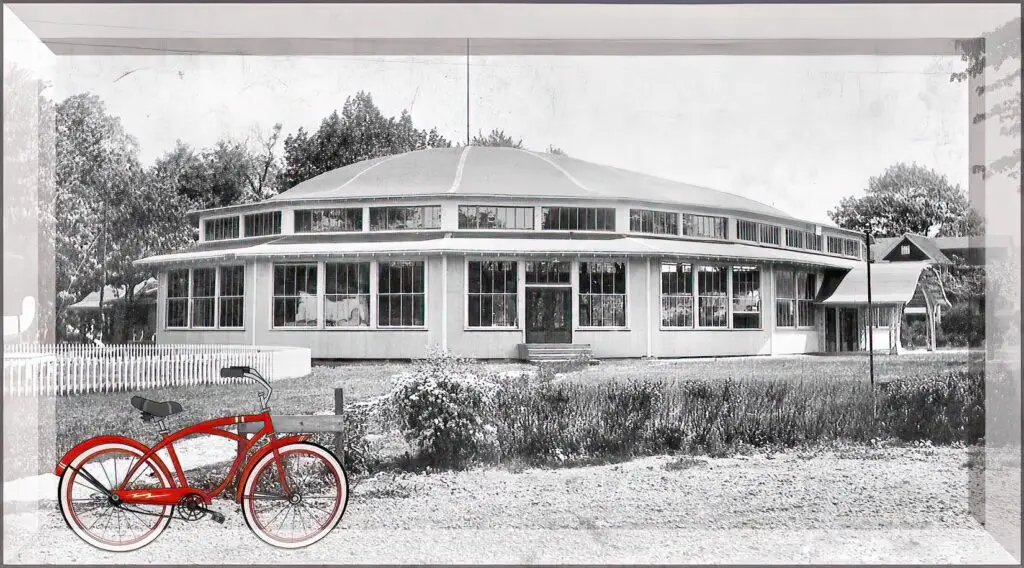
Long ago and far away is a place called Crystal Beach Park. There is now a place called Crystal Shores Apartments there. The Key Bank and the B.P. Station are also there now on the north side of Liberty Avenue. Across the street is the South Shore Shopping Center.
But once upon a time there was a wonderful amusement park (for me anyway) on that site. And it rivaled Euclid Beach and Cedar Point. Can you imagine that? I can remember the sounds and smells of the place. And I can still see it in my minds’ eye. What person wouldn’t. Wow!
It began as an entertainment park for folks in the early part of the century. It was Shattucks (Shadducks) Grove. There was a bandstand where the bands played, and the crowds came to picnic and enjoy a wonderful summer’s day. I don’t know if they danced. But they most assuredly enjoyed the music.
And then came Crystal Beach. It had a dance hall. The first one is pictured in the top postcard photo. That particular hall was situated near the back of the park. That dance hall burned to the ground in the 1940s. It was replaced by a one-story casino, with a small bar, a dance area, pinball machines, and little crank cinema machines where for a penny a person could watch moving pictures. Some were somewhat racy.
I spent a goodly amount of time at Crystal in the summer in the 50s and 60s when I was a teenager. They had a shiny rocket-ship ride, a carousel, dodgem cars, goofy-golf and a rollercoaster that scared me to death. The coaster was made of wood. I was always thinking that the thing would someday collapse into a pile of sticks.
They also had their side games. The late George Villa’s name comes to mind when I think of those games. George was a good man, and he knew how to run those games. They, like many today, were usually some types of scams. A person could always win. But in winning it was hard to tell who exactly the loser was. It certainly “weren’t” George. George was a great guy with a host of entertaining stories that always made me laugh. On the Fourth of July the park sponsored fireworks display behind the Merry-Go-Round. They thrilled me to no end. It was really magic.
Following the burning of the original dance hall, the park owners built a new building along Lake Road in front of the park the called Crystal Garden. And what a beauty it was. Glenn Miller and Tommy Dorsey, among other big bands, played there. The crystal ball in the middle of the dance floor rotated in the darkness of the room and spread spots of light all over the hardwood dance floor. Very, very romantic. And you can bet there was a lot of romance in the park. My sister, Ellie, met her husband there – as did many others. This was also a place for political gatherings. I can remember being there the 1960s when the republican vice-president candidate, Henry Cabot Lodge, spoked to a crowd there. It was, to say the least, a very exciting place.
And as time turned the big bands disappeared. The dance floor was used for roller-skating. In our younger days my friend, Frank Homitz, and I used to go there to skate. I was (and remain) a terrible skater. I’d do a turn and land on my bottom nine times out of ten. Nonetheless, we always had a good time.
One day, off I went off to the Army – ending up in a place called Vietnam for a while. Time passed and then on a cold February day a few years later I was astounded when my brother drove me past the site of the old park. The Crystal Beach Amusement Park was just gone. That was in 1967.
I am hardly an expert on the park. Marlene (Calvert) Feldkamp is the expert. Her family owned the park, and she rode that rickety old coaster many times. I wouldn’t touch it with my little toe. She also lived in the big house at the front of the place. Marlene still has “parts” of the park in her home.
Yet, I have wonderful memories of the place – when I was a boy on a bright red bicycle – exploring my town.
Vermilion resident Rich Tarrant is Curator of the Vermilion History Museum and a son and a grandson of the late proprietors of The Vermilion News (187-1964). Readers may email him at: rnt@twc.com
© RNT March 5, 2023

Okagi: An Always Expanding Story
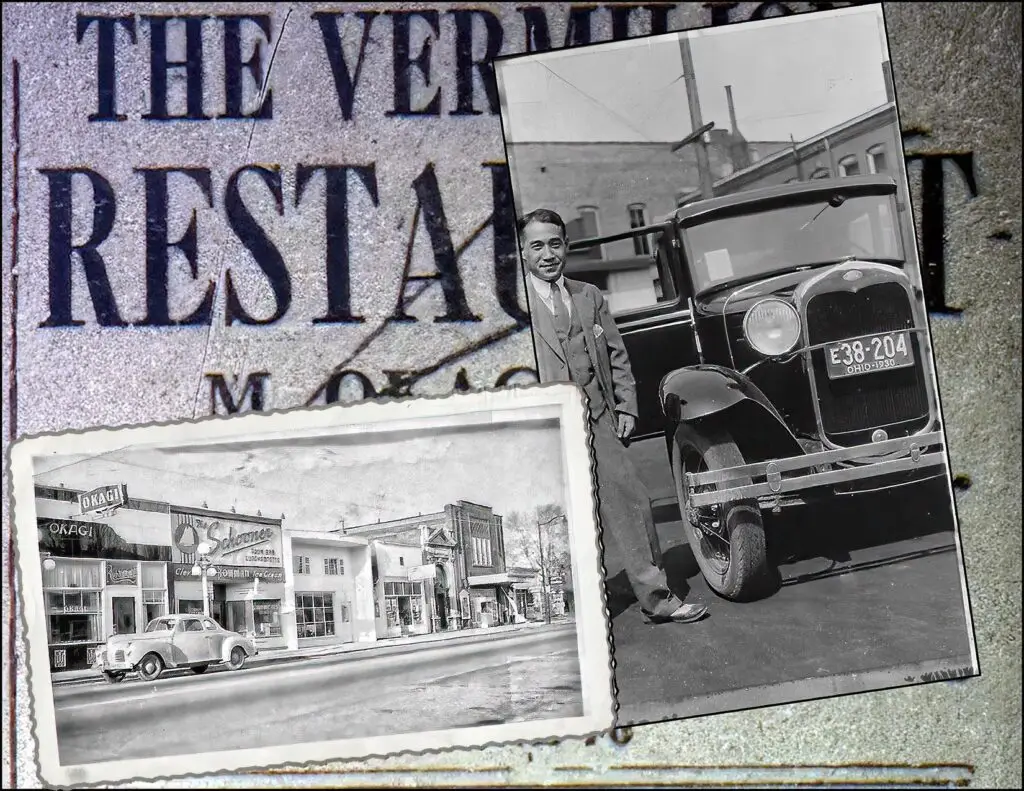
The past several years have really been difficult for just about everyone, everywhere. The pandemic really and truly tossed the proverbial monkey wrench into our lives. I sometimes feel like the world has been asleep for three years, and it’s just beginning to wake up. But if nothing else that down time has proven to be reasonably good for both digital and postal correspondence for the Vermilion History Museum.
It began in May of 2020, shortly after Covid invaded our lives. A Vermilion expatriate named Gayle Jeffery, who currently lives in Wales (a constituent country of the UK) sent me this email:
Hi Rich. I just found this photo of Mr. Okagi amongst lots of various scanned photos of my Jeffery / Naegele family. I always heard about Okagis, but don’t actually recall having seen a photo of him before, so I thought you might be interested. Also included is a nice one of the restaurant. Sorry the resolution is not fab – it’s as I received them.
After I replied to tell her I thought the photos (as you see) were great she wrote back:
I’m so glad you liked the photos. You probably know that my father (“Doc” Keith Jeffery), and quite possibly Uncle “Bud” (Morey) and Uncle “Ding” (Sidney) as well, worked at Okagi’s when they were teenagers. I have a teeny memory that it’s Mr. Okagi who was responsible for Uncle Ding’s nickname – some sort of Anglicization of a Japanese term of affection. I think they said he called him “little dingus”. [NOTE: The word Dingus refers to an often-small article whose common name is unknown or forgotten,] My Japanese has never gotten to the point of having any hope of figuring it out further.
I did reply, telling her that I thought the photos were great. And she replied sending along several more photographs. However, I’ve not used all she sent (here) because each of the pictures are worthy of 500-word stories by themselves. Moreover, I’m sure that many persons will find those accompanying this essay to be of some interest.
The portrait of a rather debonair Mamoru Okagi standing beside a Model A Ford in 1930 is the very best photograph I’ve ever seen of Vermilion’s premier restaurateur. This photograph was taken in the parking lot behind his eatery when it was located on Liberty (also pictured).
As some may recall, I have written extensively in the past about Mr. Okagi who was born in Fukuoka, Japan in 1880. But for those persons who missed those articles let it suffice for me to say (in a nutshell) that he was not a naturalized citizen until much later in his life. Also, that his first wife Marie, a native of Bordeaux, France, passed away in Vermilion in 1943. During WW2 he was questioned by the FBI, but for reasons that will forever be unknown, was never interned in a camp like many of his fellow countrymen. In any case, several years following the death of his wife he turned the business over to his adopted son-in-law Russ Vasbinder and Vasbinder’s brother-in-law Cecil Thomas and moved to California where he later remarried. He passed away in 1956 in Los Angeles.
The photo of the restaurant on Liberty Avenue was taken well after the 1930s picture of Mr. Okagi. But the cityscape is nonetheless familiar. Although Okagi’s is now a spa, and the Schooner Luncheonette Soda Bar is currently Jon Clark’s Vermilion Insurance agency. Ergo, the scene is much the same. So, when I told Gayle her pictures were “great” I sincerely mean it. But there’s one more thing.
I received a message (via Facebook) a few weeks ago from a person named Paul Urayama who lives in Oxford Ohio. He wrote:
“Hello Mr. Rich Tarrant. It was wonderful finding your information about the Okagis. Mamoru Okagi was my step great grandfather, marrying my great grandmother after he moved to California. Mr. Okagi had passed before I was born, but the family story is that he was kind and generous to my great grandmother (who passed away when I was 12). We remember how fortunate she was to have met him during a difficult time in her life. My understanding is that Mr. Okagi was active in the community and was well respected. I knew he had a successful restaurant back east (in Chicago?) but did not know the [true] story until finding your page. I am reaching out because I thought you might find it interesting to hear from someone from this period of his life. Ironically, I now live in Ohio but have not yet had the chance to visit Vermilion. Best wishes, and once again, thank you for writing about the Okagis.
I hope Paul does come to Vermilion and visits the museum. I would have a bit more to tell and show him regarding his step g-grandfather. I believe he’ll be both surprised and happy knowing those things. I know I would be. After all, it is a very compelling – always expanding – story. (Stay tuned.)
Vermilion resident Rich Tarrant is Curator of the Vermilion History Museum and a son and a grandson of the late proprietors of The Vermilion News (187-1964). Readers may email him at: rnt@twc.com
© RNT February 26, 2023

They Just Wanted to Have Fun
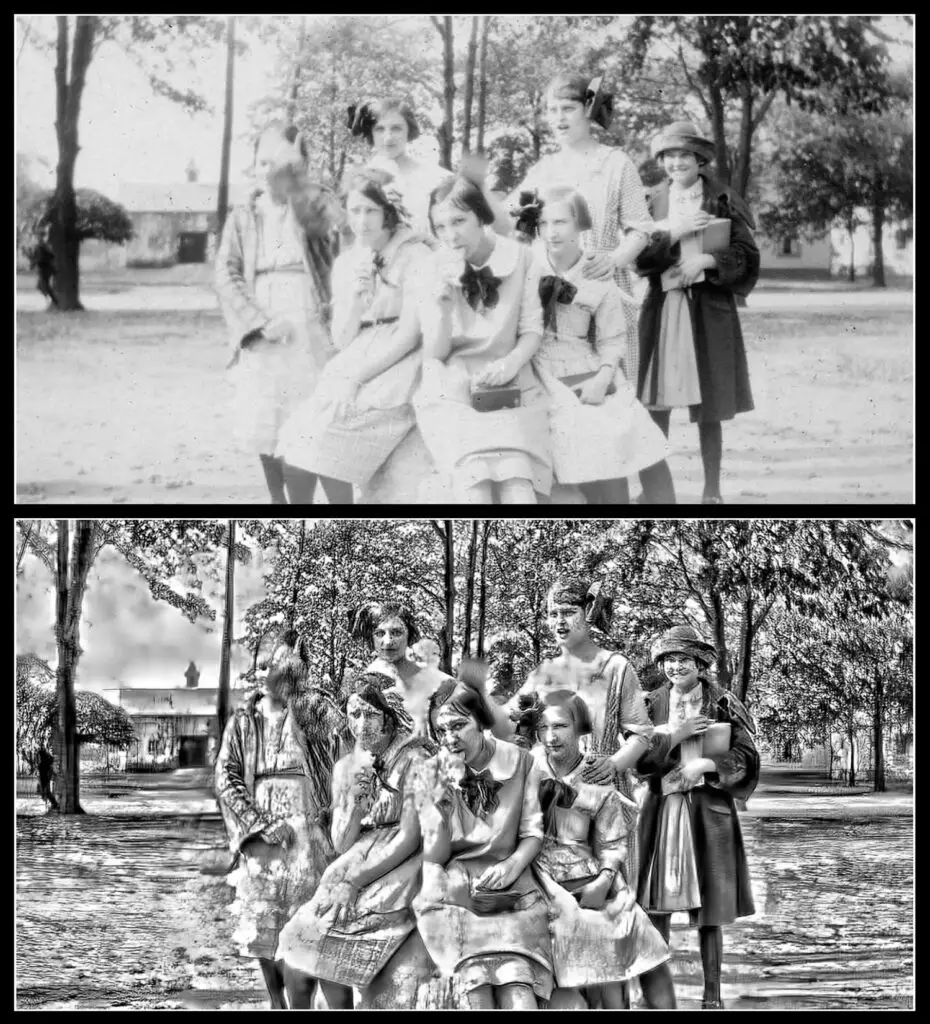
Obviously, the accompanying photographs are not great – quality-wise. I’ve been working with some of my grandfather’s, Pearl Roscoe’s, glass negatives during a January lull at the history museum and came across the upper photo. I worked it in Photoshop for maybe forty-five minutes to an hour and the lower picture, I must apologize, is the best image I could achieve. Setting aside the poor quality of either image, and the fact that I only recognize one person in it, I still like it.
This is an informal portrait of Vermilion High School girls sitting on and standing around “the big stone” that once sat in the front lawn of the place many currently (2023) call “the old schoolhouse” on State Street. While I don’t know for certain, I believe the “big stone” still exists, and rests in front the flagpole at Vermilion’s former elementary school. These schoolyard shadows were captured in the spring of 1922. I suspect the ladies were celebrating the end of the academic year and / or the beginning of another wonderful summer in our town.
The reason I worked so long on trying to improve the photo is because I was trying to improve the definition of the clothing worn by the girls. As is obvious in the original photo those items are less defined. The dresses all appear to be light colored and essentially the same. With the help of an “AI” (artificial intelligence) photo filter the folds, wrinkles, pleats, and patterns in their dresses that were not easily visible in the initial portrait became apparent. It also seems that even the textures of the materials became evident. Patterns in the sweater worn by the girl on the far left appear and the tall girl at the back of the group appears to be wearing a “checkered” patterned dress.
Most of the blurring in the photograph was caused when those persons moved as the shutter on the camera was closing. The hands of the two young ladies at the front (left) of the group are blurred. Although I can’t state it as an absolute fact, it appears to me that they have ice cream cones in their hands that were moving to or from their mouths. The girl standing at the left of the group appears to have been adjusting her hair. Ergo, her arm and part of her face are blurred. And I am fain, and somewhat embarrassed, to say it, but I believe that it is my mother. The blur on the front of the dress of the tall girl was more than likely from a small smudge on the camera lens or negative.
One of the items that also caught my attention when I came across this photo is the building in the background. Among our collection of antique photographs of Vermilion there is a very nice portrait of that particular building. It is the auto-barn that once sat behind the Ball / Wilber home (i.e. Sunset Cottage) on the west side of State Street. The girls are blocking any view of the home. But in the background to the right another house is very visible. Moreover, that home looks much the same today as it did then.
The Wilber home and the barn were torn down in the late 1950s. And upon their remains Vermilion’s UCC Congregational Church rose. While I am sorry that I am unable to give a name to all the girls pictured, I do know one thing for sure: they were definitely much the same as generations of young ladies who followed. They just wanted to have fun.
Vermilion resident Rich Tarrant is Curator of the Vermilion History Museum and a son and a grandson of the late proprietors of The Vermilion News (187-1964). Readers may email him at: rnt@twc.com
© RNT February 19, 2023

JAKE
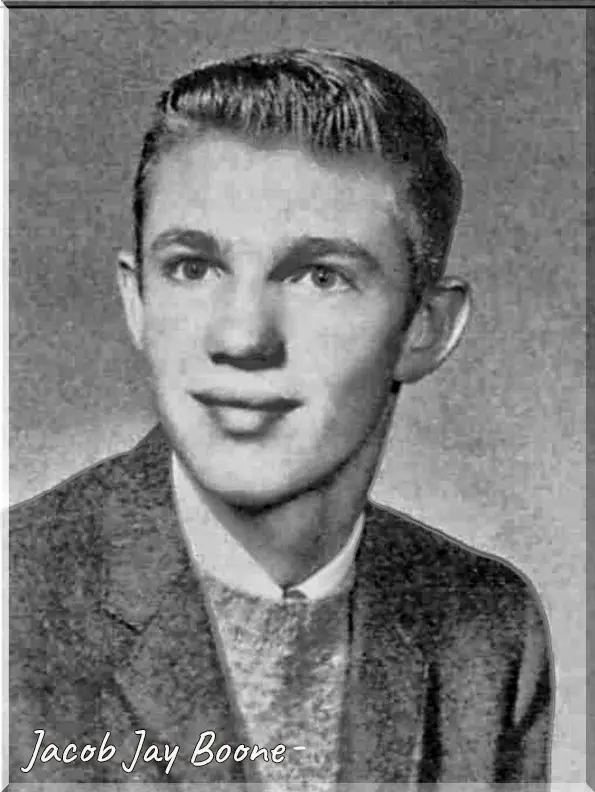
Most persons who know me know that I’m a genuine Vermilion “homebody, and homeboy”. I like to joke with our friends when they take trips to the Caribbean, Europe, or Hawaii by explaining to them that my wife and I traipse around the world every Monday night with American television travel personality Rick Steves. In truth I am just an old “fuddy-duddy”. But so be it.
When I was a little guy – no matter where I was with my friends – and no matter how much fun we were having – when the time neared six in the evening I stopped what I was doing and told my buddies, “Sorry. I gotta go home.” That’s partially because it was dinner time. It was also because I liked our “home”. I was (but didn’t realize it at the time) a young “fuddy-duddy”.
But my friends? Eh, not so much. They travelled out of our neighborhood across the world. Many moved to other places. But oddly enough Vermilion very much remained on their minds. So, while they travel, I am able to keep in touch; or at least keep them in touch with their roots. I don’t mind. I really enjoy hearing of their successes, where they’ve travelled, who they met, and where they’ve landed. I revel in their stories. That would not have likely been the case if I was always on the go. It would’ve been very “un-fuddy-duddy-like”.
I don’t know about anyone else, but I’ve been fortunate to have group of friends with whom I’ve remained in touch with since I was old enough to cross the street alone. A few have bitten the proverbial dust now. Most times I have been aware of their demise and, in fact, read their obituaries in the VPJ or other papers. But there is one exception. And it’s one that puzzles me some.
My friend Jake, Jacob Jay Boone, died last July. I’ve known him since I was eight years old – so 70 plus years. We used to sit in the yard near our family homes on Perry Street (Where else, but here in Vermilion.) and tell each other how we would make our fortunes in the world when we grew up. Jake always said he was going to be a millionaire. I don’t know all the details – but I believe Jake’s prediction came true – or at least very close to it. But it is likely only Jake will really ever know for certain. And perhaps it’s irrelevant. If you’re not there to use it what good is it?
I assume that not letting anyone know of his demise is the way he wanted it. Yet, had I been able to advise him I would have told him that there are more good reasons to have it known than not. Those reasons, however, have nothing to do with grieving so much as they have to do with celebrating accomplishments. For example, I doubt that any, or at least many, persons grieve the death of Thomas Edison. But what one does do is celebrate the fact that he developed a long-lasting incandescent electric light bulb – among other things.
In Jake’s case I know he was responsible for at least five separate patents in the U.S. and Europe during the years he worked for the Nordson Corporation located in Westlake, Ohio. Nordson is an American multinational corporation that designs and manufactures dispensing equipment for consumer and industrial adhesives, sealants, and coatings. Jake’s patents were related to improving those products. His contributions, while unknown by most, were significant.
I’ve no doubt that other employees of this corporation also contributed to such developments. However, only one of them was Vermilion’s Jacob Jay “Jake” Boone who was born on a farm on Joppa Road on September 8, 1942; graduated from VHS with the Class of 1961, spent two years in the Army, graduated from BGSU, went to work for Nordson, travelled all over the world, retired in his early 50s to be a greeter at Walmart and Sam’s Club in Sandusky Ohio, and died near the home where he was born in early July of 2022.
So, do I mourn Jake’s death? Nah! Like the rest of us he could sometimes be an ass. But he was a friend who accomplished great things. And folks should know and remember who he was. Moreover, he was “fuddy-duddy-less”.
Vermilion resident Rich Tarrant is Curator of the Vermilion History Museum and a son and a grandson of the late proprietors of The Vermilion News (187-1964). Readers may email him at: rnt@twc.com
© RNT February 12, 2023

Rudy's but not Rudy's
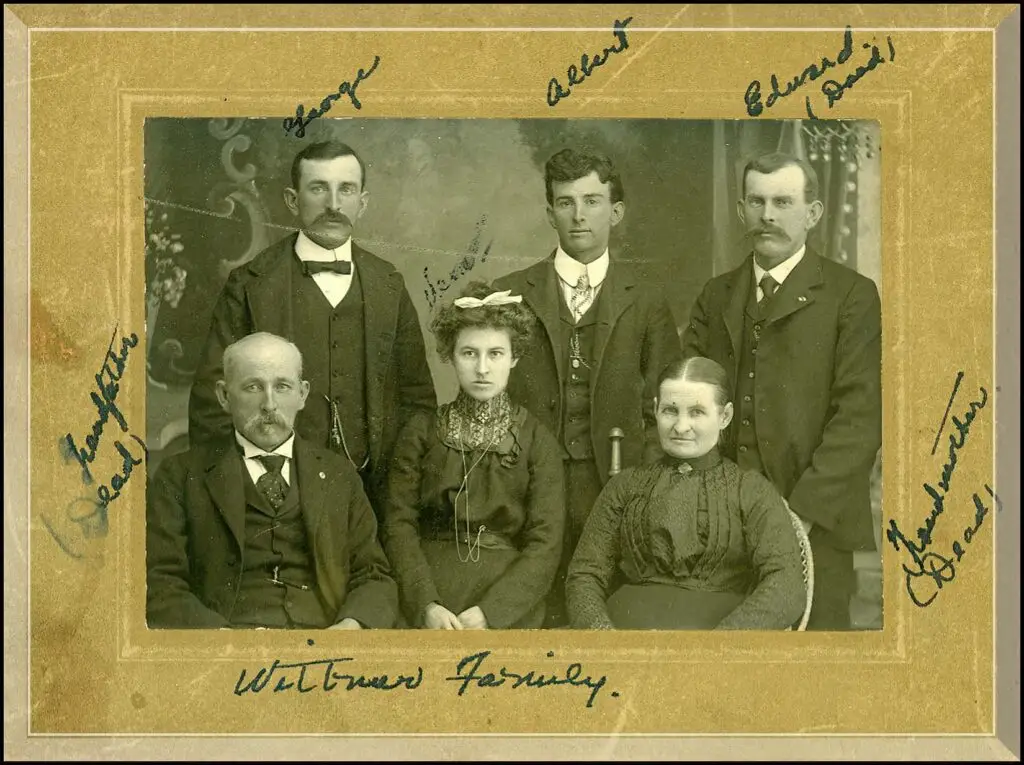
The title of this essay is admittedly confusing. But it is truthful. The accompanying photograph is a Rudy Moc photograph, but it isn’t one that he took. It was among about 60 photographs I acquired about a decade ago when late Vermilionite Evelyn “Nuggie” Hayes-Cook asked me to scan an album of photographs belonging to the now also late Dr. Rudy Moc and place them on a CD.
Very few of the persons in any of the photos in the album were identified. This one of the Wittmer Family was an exception. It may interest some persons to understand that when researching the “roots” of families it is easy to get lost in a tangle of Christian names and dates. Those taking genealogical expeditions will find that given / baptismal names in families are often used from generation to generation. Now, back to the photo.
I didn’t realize it until I began working with this portrait that the Moc family had such deep roots in both the Brownhelm and Vermilion areas. The Rudy Moc that numerous persons in northern Ohio knew as a talented professional photographer was married to a Vermilion girl named Esther Wittmer. Esther’s father was George (pictured top left). George, born in Brownhelm, was a bridge carpenter by trade. The George Wittmer family lived on State Street near what many now (2023) call “the old schoolhouse”. Esther’s mother (not pictured) was Elizabeth Darley-Wittmer. And, looking further ye will soon discover that the roots of the family also wind through Vermilion’s well-known local Darley, Baumhardt, Bachman, Hahn, and Leidheiser families as well.
John Wittmer (“Grandfather” pictured lower left) was born in Bavaria (a state in Germany). “Grandmother”, Christine (pictured lower right), was the daughter of Charles and Catherine Baumhardt-Hahn who lived in Brownhelm. [Now, if you’re becoming a bit “dizzy” with this data – welcome to “genealogical land”.] I was somewhat surprised to come across all these family connections. Mr. Moc (Rudy) and his immediate family were from Bohemia (now part of the Czech Republic) and came to the U.S. around 1908. His wife, Esther’s parents were of German heritage, but were born in Ohio. But all of this (i.e., the family relationships) seems to come into focus in the Village of Vermilion. (And here I speculate some.)
Rudy Moc, the photographer, was born in Bohemia in 1896, but grew up in nearby Lorain becoming interested in photography at a very early age. In the early years of the 20th century, he opened a photography studio he called “Sunset Studio” in the heart of Vermilion. It was located on the east side of Grand Street near the railroad tracks on the site now occupied (2023) by the “Jailhouse Bed and Breakfast” – formerly the Vermilion Police Station – originally the first Vermilion Public Library. Persons familiar with his work and success will clearly understand that it had nothing to do with simply having a camera. He was an artist.
In any case, given his age at the time he started his business (he was only a year older than Esther), the nature of his work, and the fact that Vermilion was a village of only about 1200 souls it’s not very hard to imagine that the couple would meet and eventually marry. Although Mr. Moc did leave town to open a new studio on Broadway in Lorain, he didn’t leave Vermilion altogether. The couple built a beautiful home on Darrow Road southwest of town where they raised their two sons, Rudy G., and Roger K. Both boys attended and graduated from VHS.
Esther passed away in 1961, and Rudy in 1969. And although the accompanying photograph of the Wittmer Family: George, Albert, Edward, Vera, Grandfather John, and Grandmother Christine isn’t Rudy’s per se, it most certainly is.
Vermilion resident Rich Tarrant is Curator of the Vermilion History Museum and a son and a grandson of the late proprietors of The Vermilion News (187-1964). Readers may email him at: rnt@twc.com
© RNT February 5, 2023

George Holl - The Cobbler - Always Busy
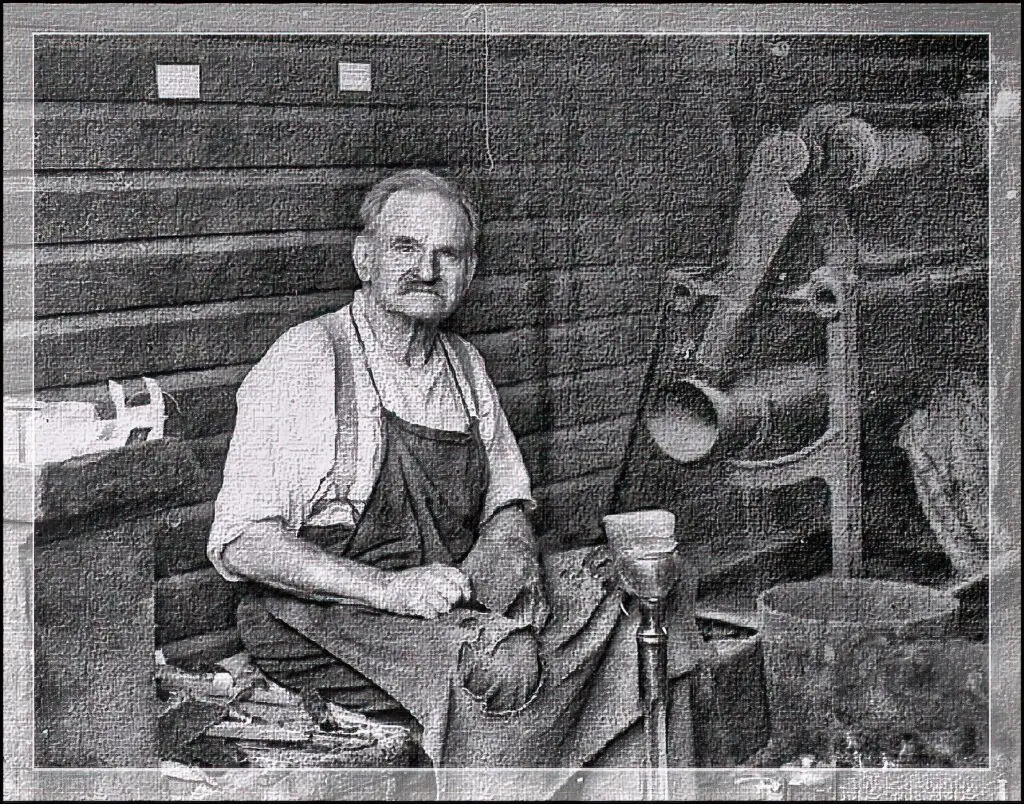
In 1870 there was a lot happening in our world. and our nation. Ulysses S. Grant, an Ohio boy, was president. All the former Confederate states were finally rejoining the Union after a bitter conflict. And the Union was in the process of restoring relations with southern states, as well as helping in the reconstruction of their major cities, railroads, and farms. Out West the Great Plains were being settled, but not without some serious problems. An Apache warrior of the Chiricahua tribe named Geronimo was waging war on settlers and soldiers in Mexico and the Southwest that would last for the next decade. In Africa, New York Herald journalist Henry Morton was on the trail of European explorer David Livingstone who no one had heard from for several years. In Australia the notorious bushranger outlaw, Nick Kelly, that poor and underprivileged citizens considered to be a hero, was about to rage a personal rebellion against the establishment that would eventually lead him to the gallows. Also, in 1870 in Amherst, Ohio a husky young man of 15 years named George Holl was apprenticed in the cobbler shop of one George Faus.
Young Holl worked in the Faus shop until he was 22 and then came to Vermillion to work for Mr. Nick Wagner, the village’s veteran cobbler. At 29 George broke his ties with Wagner and started his very own cobbler shop. Holl was certainly a man of few words. Most of the time he could be found sitting on his workbench with a shoe between his knees, a mouthful of nails that one by one he placed between his thumb and forefinger and with a tap-tap-tap he remedied the problem of a worn-out heel or shoe sole. If ever a man had a motto to live by his would have been “always busy”.
Understandably, the town cobbler was an important job in the yesteryear. Understanding the true importance of this position in every community has become clouded by the relative ease with which most can now access footwear. Few persons own only a single pair of shoes. Many have four or five pairs: A shoe for every occasion. Moreover, having our shoes repaired to put another hundred thousand miles on them is now unthinkable – not to mention undoable. But step (no pun intended) back into the first decade of the 20th century or earlier and we find that a village cobbler very literally kept citizens on their feet.
Mr. Holl was no exception. Quietly and persistently, he made new shoes and mended the old for generations of Vermilionites. More than a few of those made-to-measure shoes cost the proud owner are whopping four dollars. During the first world war the price jumped to $14.50 and afterward dropped to $12. As late as 1927, when the accompanying photograph was taken folks could still count on “Cobbler” George Hall to fashion custom-made shoes or boots for a reasonable price.
The bench on which he toiled each workday appears as though it had been with him for all of his 57 years in the business. But Holl explained, “It has only been with me for 40 years”. The bench, by the way, was made by a local resident named Henry Reis. It might also interest everyone to also know that during all his years in the business (i.e., 40 years working on that same bench and the previous 17) Holl had taken less than two weeks’ vacation.
In 1880 Mr. Holl had met and married Miss Elizabeth “Eliza” Lapp. From that union four girls and four boys blessed their home. And the little hammer worked overtime to feed, clothe, house, and educate that lively bunch of little people. Through time and circumstance, they lost one son and two daughters. But still, through all those difficulties George’s hammer kept tap-tapping away.
Holl’s first shop was in the room with “Tinner” Smith. Later he kept cobbling in Bill Bowland’s, Will Krapp’s, and the Leidheiser place. He was forced to move several times due to fires (something that was not uncommon in early Vermilion history). His last location was built by Mr. Leidheiser after Leidheiser sold his place to Mr. Mamarou Okagi. Leidheiser closed off the alley next to his old place on Liberty Street and built a new shop for Holl. The new place was constructed in a manner that would allow the cool breezes to waft through the place in the summer and one that could be easily heated during winter. And there, while the rest of the world churned and turned, “Cobbler” George Holl spent his days “always busy”. He died in 1932.
Ref: The Vermilion News, August 1927.
Vermilion resident Rich Tarrant is Curator of the Vermilion History Museum and a son and a grandson of the late proprietors of The Vermilion News (187-1964). Readers may email him at: rnt@twc.com
© RNT January 29, 2023

How Things Might Have Been If…
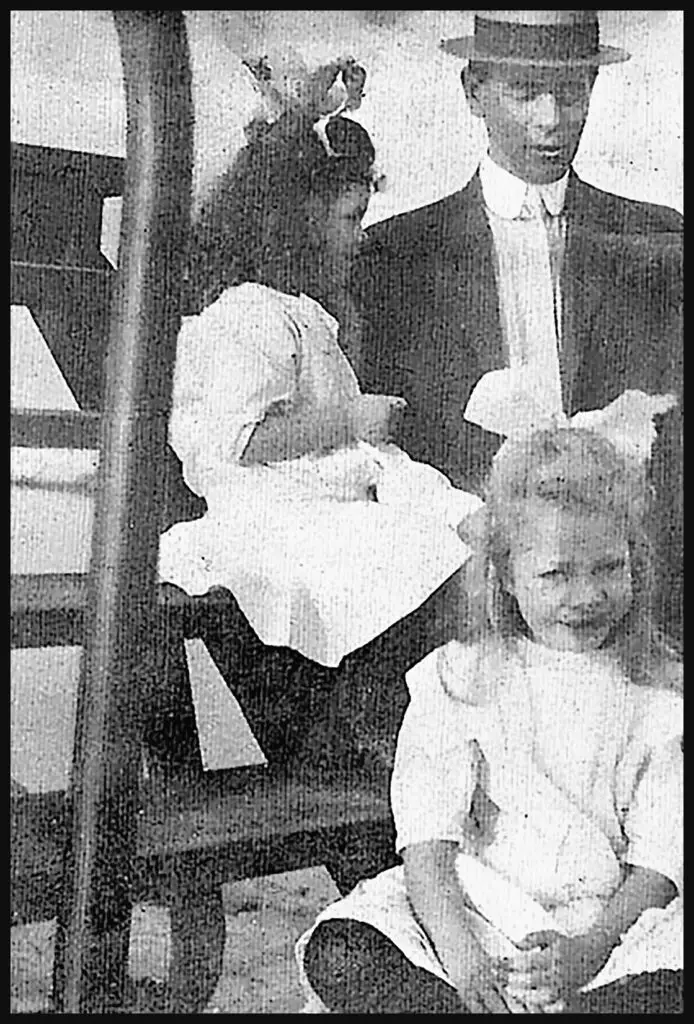
According to the National Institute of Mental Health an estimated 26.2 percent of Americans ages 18 and older — about one in four adults — suffer from a diagnosable mental disorder in a given year.
If that statistic makes you take a step back, you are overreacting. Because it doesn’t follow that over a quarter of the people surrounding us are raving lunatics. What it does mean is that mental disorders are relatively common – and that a majority of those afflictions are very manageable. Unfortunately, this has not always been true. Such was the case of Albert L. Irey.
Mr. Irey was born in Pennsylvania in 1875. Excelling in his studies he not only finished college but had earned a doctorate in education by the time he took a position with the Vermilion Public School System about 1910. By 1914 he had earned a promotion to Superintendent. He and his wife, Clara, who was also an educator, had two daughters: Genevieve Sarah (b.1904), and Rosamond (b.1908).
As the attending photograph of Mr. Irey with his daughters (c.1911-12) seems to indicate – Albert L. Irey was a rather dashing figure. And thus, it should be no great surprise for one to learn that this attractive wight often caught the eye of many a maiden.
Now had it all ended there, there would have been no problem. But it apparently did not. And before too long letters were uncovered that strongly implied that the esteemed educator was romantically involved with one of the female instructors. Not only did his wife and family find this news disturbing but the entire community was enraged by his behavior. This was, in their view(s), hardly appropriate conduct for a community leader to exhibit. As a result a special meeting of the Vermilion School Board was called and Mr. Irey, as well as two female teachers were unceremoniously dismissed. One of the teachers, who had only been guilty of carrying correspondence between the two suspected paramours, later filed suit to keep her job and won.
Mrs. Irey’s reaction to the circumstance was immediate, predictable, and understandable. She filed for, and received, a divorce retaining custody of their daughters. Albert, who was devastated by the fate he, himself, had wrought apparently began to lose touch with reality.
He began to write rambling letters – some threatening, some remorseful – to his wife and lay them by the door of their Ohio Street home. Alarmed by the tone and manner of the letters Mrs. Irey formally sought to have Albert acquire psychiatric treatment.
In the first of the two sanity hearings held in Sandusky, Ohio in 1916 for Mr. Irey he defended himself. His eloquence and appearance were very persuasive, and he was found to be quite sane. After the hearing he told an acquaintance that he was off to California to begin his life again. In truth he remained in the area and continued secreting often terrifying letters, along with some soiled underwear, on the doorstep of his estranged family.
After a warrant was filed for his arrest he disappeared for a time, only to turn up in Akron Ohio working as a carpenter for 45 cents an hour and using an assumed name. Taken into custody without a struggle the, now bearded, Professor was unable to pay the thousand-dollar bail set for him and spent the days before his third hearing sitting in a jail cell reading Shakespeare.
During this sanity hearing Mr. Irey sat quietly making notes, or fidgeting with his fingers, during testimony given by several physicians as to his condition. When it was over, he was found to be insane and was removed to the Lima State Hospital for the Criminally Insane. Before his departure from the courtroom, he asked to see, and talk with, his daughters. His sincere affection for the girls was noted. And the years passed.
On an overcast Thursday morning in mid-August in 1962 Professor Albert L. Irey died alone in the Central Ohio Psychiatric Hospital in Columbus. He was 87 years old and had lived more than half his life there or in other hospitals. His former wife had remained in Vermilion where she completed her career as an educator. Sarah and Rosamond grew up, left town, and raised families of their own – far, far away. And all was nearly forgot.
Twenty years ago, one of his great-great-granddaughters sent me this lovely photograph of him with his children inquiring if I’d ever heard of her “infamous g-g-grandfather”. [Note: That was her term. Not mine.] I had not. But it motivated me to research and familiarize myself with the story. Things have, of course, changed in the field of psychiatry since then. And I can’t help but wonder how things might have been in that yesteryear – if…
Ref: National Institute of Mental Health; Sandusky Register, 7-1916; The Vermilion News, 7-6-1916: Special Thanks: Joan Woodruff-Owens, Fort Collins, CO.
Vermilion resident Rich Tarrant is Curator of the Vermilion History Museum and a son and a grandson of the late proprietors of The Vermilion News (187-1964). Readers may email him at: rnt@twc.com
© RNT January 22, 2023

PEARL'S ROSES
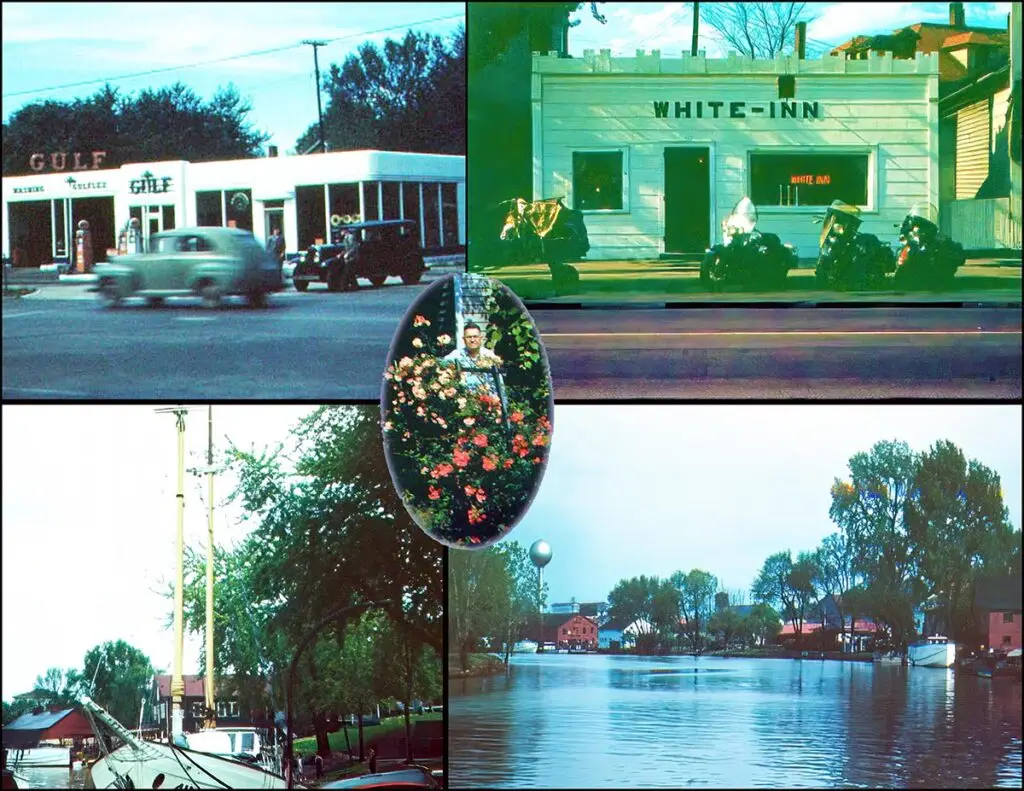
The Eastman Kodak Company of Rochester, New York, introduced color film (Kodachrome) to the world in 1935. The first commercially viable color films were produced in the early 1940s. These films used dye-coupled colors in which a chemical process connects three dye layers together to create a color image. That same process is still used today on film. Blissfully unaware of these facts, I earnestly rebuffed the idea that my grandfather, Pearl Roscoe, might have taken any color photographs prior to his death in 1946. No matter that my cousin, Dave Lindsay, insisted that he had some color slides taken by our grandfather. Well, guess what? Dave was right. And I should’ve kept my mouth shut until I had all the facts. So much for my “know it all” attitude.
The photographs which Dave told me about were in the form of color slides produced by the Kodak Company called Kodaslide(s}. He put them in the mail from his home in Texas and I received them in short order. They were in their original boxes and had postmarked dates 1942, ’43, and ’45. I knew they belonged to our grandfather because they were self-addressed, and I recognized his handwriting. (It appears on many of his black and white photographs.)
After receiving the slides, I took them to my trusty scanner and began to copy them. They are, in a word, beautiful. Unfortunately, the photos are not printed in color in this particular medium (Initially this article was published in the Vermilion Phtojournal.). They are, however, unmistakably Pearl Roscoe photographs. They require very little cropping / framing, which is characteristic of his work. Many amateur and professional photographers will understand the expertise required to capture great photographs in that format. Another defining characteristic of his photography is the subject matter.
A great deal of his photographic work was focused on keeping a pictorial record of Vermilion. Although he did some photo identification work, and a few portraits people portraits, most of his photographs were of objects and places. In the accompanying composition he is surrounded by four of his color photos. In it, he is standing in his wonderful rose garden behind the News office. This probably the summer of 1942.
In the top left corner is the Gulf gas station that was located on the corner of Liberty and Grand streets. Years later it became the headquarters for Vermilion’s ambulance. Today it is the site of Vermilion’s Friendship Park. The former service station, by the way, rose from the ashes of what was at one time Glen Martin’s Pontiac Dealership and then Mayor Osberg’s Office that went up in flames around 1940. Even as a youngster I appreciated the unique art nouveau type architecture of the building. You will note that there are no sharp corners on the building.
At the Top right is what I term to be the “ghost” of the White Inn restaurant. It was situated on Liberty between George Rathbun’s General Store (now the Pavilion Grill) in the shadow of Adam Trinter’s house (a Vermilion patriarch) to the left. Just over the roof of the eatery the back of the Wagner Hotel (now Harbour Town Dentistry’s and the Vermilion Photojournal offices) can be seen. Today both the restaurant and Trinter home have been replaced by the Old Prague parking lot. And only their ghosts remain.
Bottom left is a picture of a schooner docked in front of the waterworks on Main Street. Aside from the schooner points of interest are the slope to the south of the water plant now reinforced by a concrete wall, and the ark-type fish tug moored at the Kishman Company dock. In another picture (not included) the schooner rests at a dock in one of the lagoons.
The last picture on the lower right is a jewel, and I’m very sorry it can’t be presented in living color. Taken from the middle of the river just south of the waterworks it epitomized the Vermilion of the 1940s. The fish houses still lined the waterway from Kishman’s to the bridge. With the water tower and the lumber company building looming in the distance we see the village at its very best; tidy, prosperous, and quiet. Taken near sundown it unknowingly suggests that the “end of those times” are at hand. Less than a decade later a major fire in the Leidheiser fish houses along the river would foreshadow the beginning of the end for Vermilion’s fishing industry. It was something Roscoe never imagined when he captured this photo. It was also something he would never see.
These are probably the very last pictures Roscoe would take of his beloved town only a few blocks away from his home on Grand Street. They were never published during his lifetime. Like his roses, I believe he wanted his fellow Vermilionites to enjoy them. I certainly hope he succeeded.
Vermilion resident Rich Tarrant is Curator of the Vermilion History Museum and a son and a grandson of the late proprietors of The Vermilion News (187-1964). Readers may email him at: rnt@twc.com
© RNT January 15, 2023

Sid & Polly
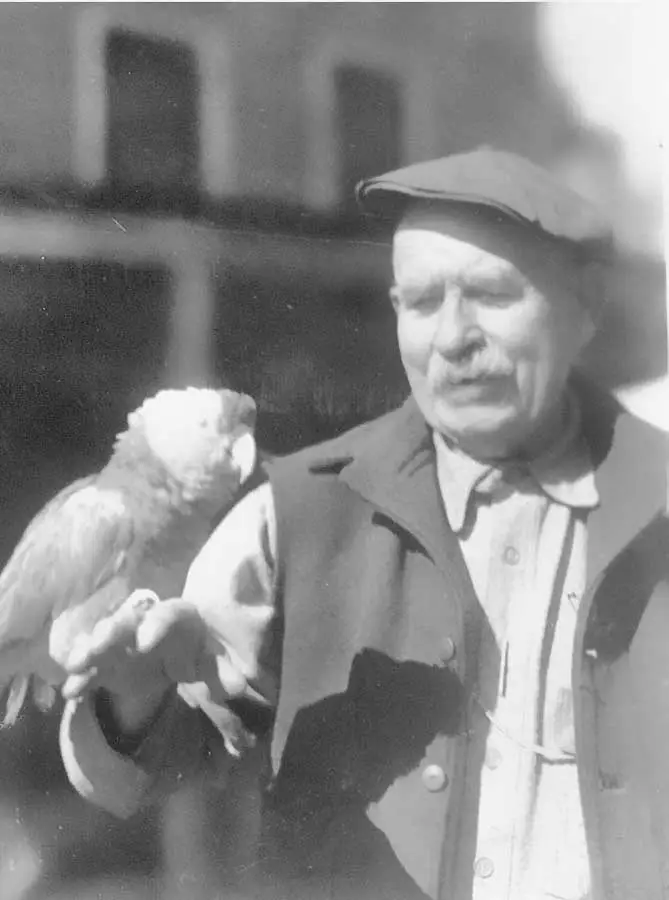
If birds could talk logically pioneer grocer, Sid Simons’, parrot Lindy (a.k.a. Polly) probably could have told Vermilionites of the 1940s a great deal more than they either should or would have wanted to know about their neighbors and friends. For more than 50 years the Simons family ran a local grocery business in our town. And though Polly wasn’t around’ all that time he was there long enough to observe and absorb all that he saw and heard in his domain on Grand Street. It is said that even the most innocent of passers-by during a summer evening stroll seldom escaped Polly’s assaults on their character interspersed with an occasional compliment ‘for a well-turned ankle or two if a lady happened by. Such was the amiable atmosphere of the village in its early days.
Sidney W. Simons was born in 1852 on a small farm south of town. That same year a story called Uncle Tom’s Cabin was being published in an Abolitionist magazine call the National Era. It was a story that would help change the very course of American history. A man with the oddest of names, Millard Fillmore, had been thrust into the presidency of our nation due to the untimely death of President Zachary Taylor. San Quentin Prison near San Francisco, California had just opened for business. The “Swedish Nightingale” Jenny Lind was on a singing tour of the country, A fellow named P.T. Barnum was her agent. A Shakespearian actor by the name of Brutus Junius Booth died leaving a son, John Wilkes, whose name would eventually live in historical infamy.
Simons was inclined to look back at his early years with some regret. Yes, there were the hardships and troubles, but there were also good times on the farms he once worked and owned. He would often say “I’d rather be on the farm than in the store.”
He married his wife, Frances (Minkler), when he was 21 and she was but 15 years of age. Their children, Gertrude (b.1882) and Cortland (b.1885), were born on their 38-acre farm. After a time, he left farming and came into the village to work on the coal docks. Later he went into a partnership in a store at Berlinville, Ohio just a stone’s throw southwest of Berlin Heights. Shortly after this time the Simons family opened their first store in Vermilion.
The family lived in the back of the first grocery. It was located immediately south of the railroad tracks on Grand Street. Several years later Mr. Simons built a new store on the same street with living quarters above it that would serve as the family home for a number of years afterward. [Note: Many long-time Vermilion residents later knew the building as Bailey’s Vermilion Hardware Store.] It was in this store that Sid Simons would spend the next 50 years of his life weighting out sugar and standing behind the counter ready to serve his customers.
Polly, the bird was a gift brought to him by the local dog warden sometime after the death of Sid’s wife. It was not intended to take her place, but it certainly accomplished one thing; silence was never a problem. The bird took up residence quickly without giving any thought of leaving, and Mr. Simons appeared to enjoy the company. Polly even had a chair and a place at the dinner table.
I, unfortunately, never knew Mr. Simons. I did, however, know his son Cortland and his wife Myrtle. The couple lived in the old brick house on the southeast corner of Ohio and Grand Streets. [Note: Some know the house as a Gilchrist house. But for me it was always “Simons’s”] In any case, I remember both Myrtle and Cort as being very friendly people. The Vermilion News office being so close to their home, I saw both with some regularity. If my memory serves me well, “Myrt” helped out at the print shop in a pinch. I recall that Cort, who also worked in the grocery store was a very active volunteer fireman. I also remember that our old fox terrier, Mister Chips, made their home one his regular stops every morning for a treat as he made his rounds about town each day.
Hopefully, it is obvious that Vermilion – aside from being the “Village of Lake Captains” – was also a village of enterprising, good and very memorable characters, (both human and animal), and places. Sid Simons, his son Cort, daughter-in-law Myrt, his store, and of course his parrot, Polly, were but a few of them. They are in fact and deed unforgettable.
Ref: The Vermilion News; 11-21- 1940; Ancestry com: 1900 U.S. Census, Vermilion, Ohio; VPJ, 04/22/14; Rev. 01.08.23.
Vermilion resident Rich Tarrant is Curator of the Vermilion History Museum and a son and a grandson of the late proprietors of The Vermilion News (187-1964). Readers may email him at: rnt@twc.com
© RNT January 8, 2023

.
A Bridge to Yesteryear
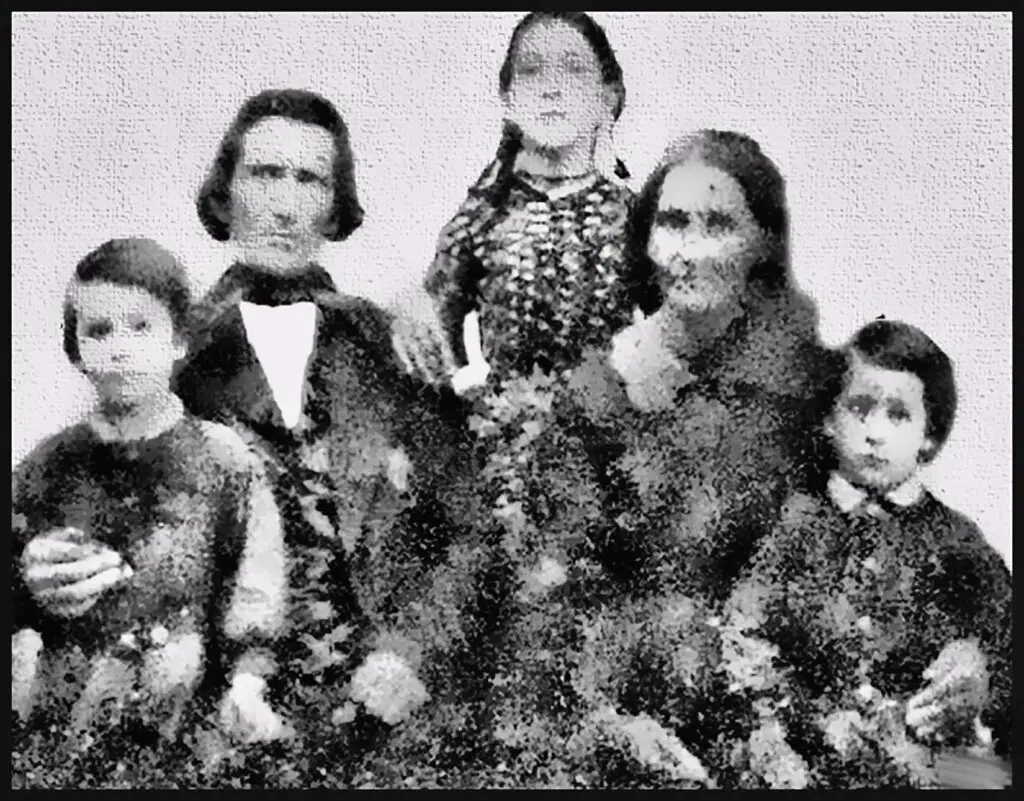
To begin with, it might interest some to know that I often feel like I am “accidently” finding gold everywhere I turn. I am, of course, not literally stumbling upon the precious metal, but rather coming across priceless artifacts from the past that just take my breath away. Their real value is actually arbitrary because that value is not based merely on their age, but on one’s ability to identify them and place them in context with history. By themselves they are nearly worthless (like old photographs of nameless places and faces that are sold in flea markets across our nation). What follows is an example.
The photo accompanying this week’s essay is a precious tintype of my g-g-grandparents Levi (b.1810) and Eliza Stockwell Roscoe (b.1812) and their family. I would guestimate this pic was taken about 1860. The young girl behind the group is Harriet (b. 1847); the oldest boy on his father’s lap is Lucious (b1851); and the younger boy on his mother’s lap is Jay (b.1854). They were all living in what was then referred to as North Milan, Ohio when this portrait was made. As one might imagine acquiring a legible copy of a photo from a vintage tintype is sometimes, but not always, easy. In this instance it’s a good – but hardly wonderful – reproduction. The great part of the matter is that I can identify those in the photograph.
I came across the tintype in a great collection of my g-grandfather’s (Caselton Roscoe, 1835-1918) letters, diaries, sketches, etc. several years ago. There is, by the way, another very interesting portrait that was apparently taken of my g-grandfather with members of what I would call his “dance band” in the years following the Civil War that I will certainly write about another time.
My g-grandfather, Cass, was the 2nd oldest child of Levi and Eliza’s 9 children. One daughter, Emma (b.1846) died when she was but one year old. The three youngsters pictured are the youngest. I am (again) truly sorry that I knew none of them – but can only imagine.
Jay, the youngest, died in 1952 at the age of 98. When I was a very little boy I recall going to Norwalk, Ohio with my mother to visit him when he was a resident in what most persons used to call “an old age home”. I distinctly remember opting (demanding) to stay in the car because I was terrified of old people. I also recall, on the visit, that just outside our car a huge magnolia tree was in full bloom. To this day I associate ageing (including my own) with that odor.
Well, I certainly botched that one. Really. It was my one and only chance to personally touch base with not only the oldest member of my family at the time, but also a person who could have probably shared memories of the Civil War as well as local events surrounding the day President Lincoln was assassinated. Darn. But looking on the bright side I do have a “magnolia memory” of that time, along with a treasury of artifacts that continue to provide me, as well as others, with a literal bridge from yesteryear to today, tomorrow, and the year(s) ahead.
Vermilion resident Rich Tarrant is Curator of the Vermilion History Museum and a son and a grandson of the late proprietors of The Vermilion News (187-1964). Readers may email him at: rnt@twc.com
© RNT December 25, 2022

MEMORIES THAT LAST
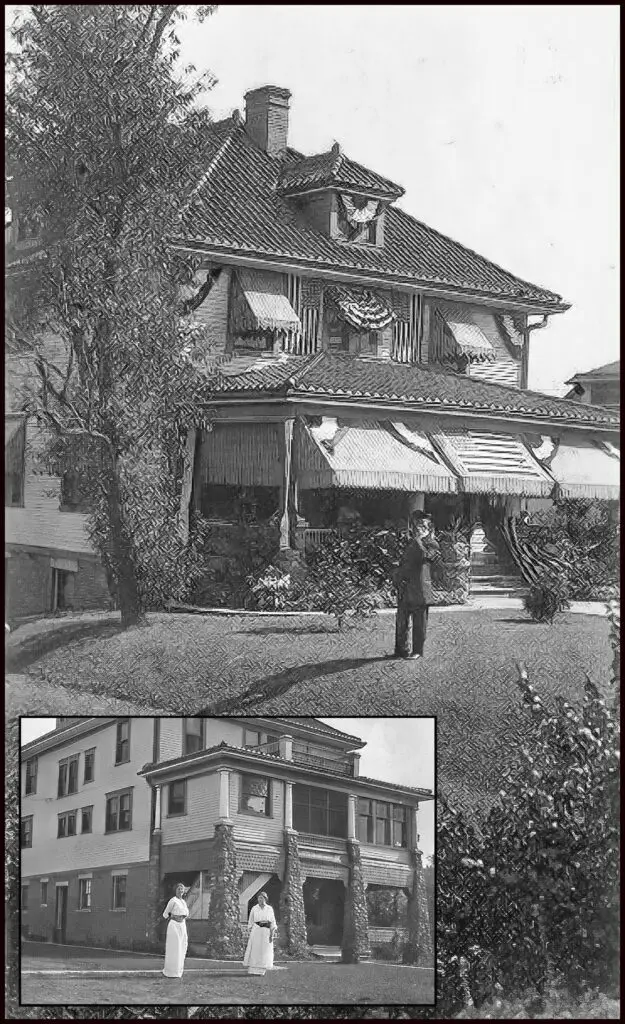
It’s likely no secret that this writer thought razing the old F.W. Wakefield home (among others) along the lake shore at the end of Main Street was short-sighted. But given the fact that I too (believe it or not) make mistakes who am I to criticize? Such things were done long before that home was built and will continue ad. infinitum.
In fact, one of the most beautiful homes in Vermilion (now long gone) was the one pictured. It was built under the direction of Vermilion entrepreneur George Fischer in the early years of the 20th century. From the front it doesn’t look to be an extremely large home. The rear view of the place (the lower inset photo), however, better illustrates its real size. In short, it was substantial. It was also literally one of the town’s most beautiful homes – a mansion.
The domicile was sandwiched between Liberty Avenue and the Vermilion River near a bend in the river with the Fischer Lumber Co. to the east and the Kishman Fish Co. on the northwest. This would currently be the area between the Vermilion Boat Club (east) and the Fishermen’s Bend condominium complex (northwest). Today the area is part of Exchange Park.
In the 1930s the lumber yard, that was established in 1870, the Fischer family business for three generations went up in smoke. The facilities along the river front were never rebuilt. The Fischer home miraculously survived. But the owners, George, and Elizabeth Fischer, passed into the ether therein within a decade of the fire. Their son Elton then lived there with his wife Ruth until shortly before his demise in 1960. He passed away while a resident of Hall’s Rest Home. That facility, by the way, was then in the old Pelton home on the northeast corner of Liberty and Decatur streets across from the Vermilion Police HQ.
Just as an aside it might be of interest to some to know that Vermilion’s former Maud-Elton Hotel acquired its name from George and Elizabeth Fischer’s children Elton and Maude. Surprisingly enough, the old hotel (or at least part of it) still exists – and sits on the southwest corner of Liberty and Exchange streets. Mr. Fischer purchased the original hotel – once known as the Lake House Hotel (built in 1876) – when it occupied the southeast corner of Liberty and Division / Main streets in 1903. Several years thereafter he had it moved east – down the hill – to its present location. In 1914-15 he oversaw the building of the brick Fischer Building block that currently occupies that site and actually connects to the old hotel. Late Vermilion historian Don Englebry wrote in his memoirs of the town in 1987, “I remember when they moved the Old Maudelton Hotel down to its present location. It was really some job in those days, with none of the modern equipment it took some time, but I don’t believe they even cracked any plaster in the process.”
But back now to the old mansion along the river. Following the deaths of Elton and Ruth Fischer the place was purchased by Vermilionites Bob and Lucille Nuhn and it became known as the Riverview Nursing Home. And time passed.
Like many structures of its size the wear and tear married to the cost of adequate maintenance took its toll on the once very stately home. Such negligence inevitably resulted in its being sold and subsequently demolished. But maybe, in the long run, it doesn’t matter. Because when it comes down to it – it isn’t really things or places that make lasting memories. It is people.
Vermilion resident Rich Tarrant is Curator of the Vermilion History Museum and a son and a grandson of the late proprietors of The Vermilion News (187-1964). Readers may email him at: rnt@twc.com
© RNT January 1, 2023
